Catamaran vs Monohull in Rough Seas: Which is Better?
Catamarans and monohulls have different designs that affect how they handle rough sea conditions. In fact, they have an advantage over each other when sailing in heavy seas. Let's try to compare each type of vessel based on their performance, design, and stability, to help you decide which can give you a safer and more comfortable journey on the open water.
Regarding speed, efficiency, and stability, a catamaran may be the better option for you. Because they have twin hulls, they are more comfortable to sail in rough seas. A monohull can become more advantageous in rough seas when sailing upwind since it can point higher into the wind and can handle strong winds easily.
Catamarans with two rudders also allow for better control and maneuverability in rough seas compared to monohulls, which only have one rudder. Let's look at more of the comparison between these two types of boats when sailing through big waves in the sea.
- When it comes to stability and comfort, catamarans can provide more stability. They are also less likely to cause seasickness and offer more living space and privacy.
- In terms of speed, catamarans are also faster than monohulls because they have a smaller displacement. Their structure also makes them less likely to capsize or sink.
- A monohull is advantageous when it comes to sailing upwind, and handling stronger winds. Their deep keel also provides them with increased stability and reduces drag, which can be an advantage in rough seas.


Catamarans Vs. Monohulls in Rough Seas
If you're planning to buy a boat, and you're deciding whether to go for a catamaran or a monohull, one of the many things you may need to consider is how they perform in rough seas. Rough seas can be challenging for any vessel, but some boats are better equipped to handle them than others. Below is a table summarizing how well these boats perform in rough seas:
A catamaran is a boat with two hulls connected by a deck. Because they have two hulls , catamarans are known for their speed, stability, and spaciousness. They are often used for cruising and chartering, as well as racing. They also have a wider beam than monohulls, which means they offer more living space and stability. They are less likely to heel or tilt to one side, are more buoyant, and have a shallow draft.
On the other hand, monohulls are the most common type of boat with only one hull. They are known for their simplicity, versatility, and affordability. Monohulls are often used for day sailing, racing, and cruising.
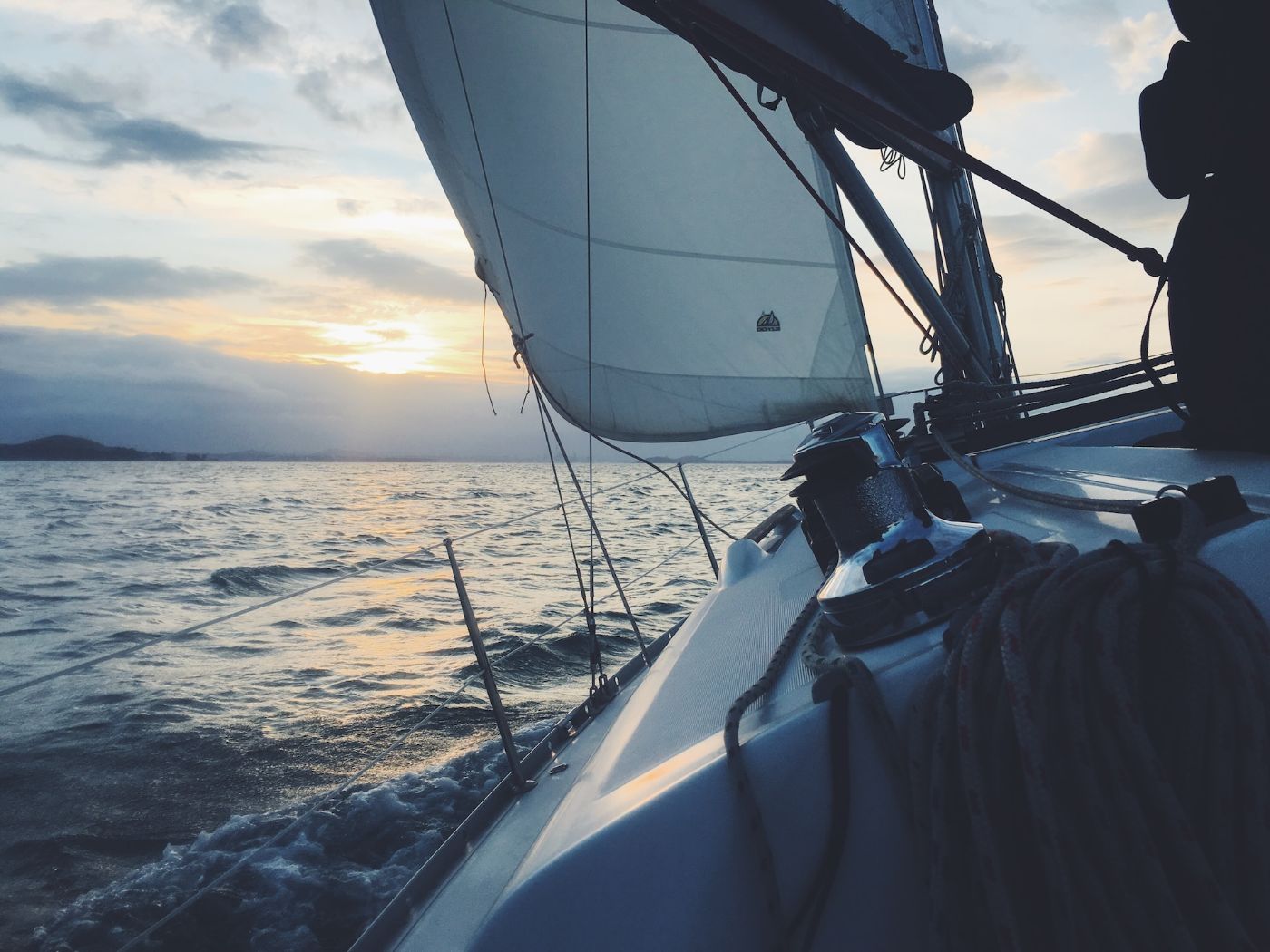
When it comes to rough seas, catamarans are generally more stable than monohulls in terms of roll stability. Monohulls, on the other hand, are better at handling heavy seas and high winds, but they can be more prone to rolling and pitching, and can significantly heel more than a catamaran.
If you are aiming for speed, efficiency, and stability, then a catamaran may be the better option for you. They are generally faster and more efficient due to their twin hulls, and their stability can make for a more comfortable ride in rough seas.
On the other hand, if you prioritize upwind sailing performance, sailing feels and responsiveness, and the traditional look and feel of a sailboat, then a monohull may be the better option for you. Monohulls sail closer to the wind and have a unique feel to them that some sailors prefer.
Detailed Comparison Between Catamaran And Monohull
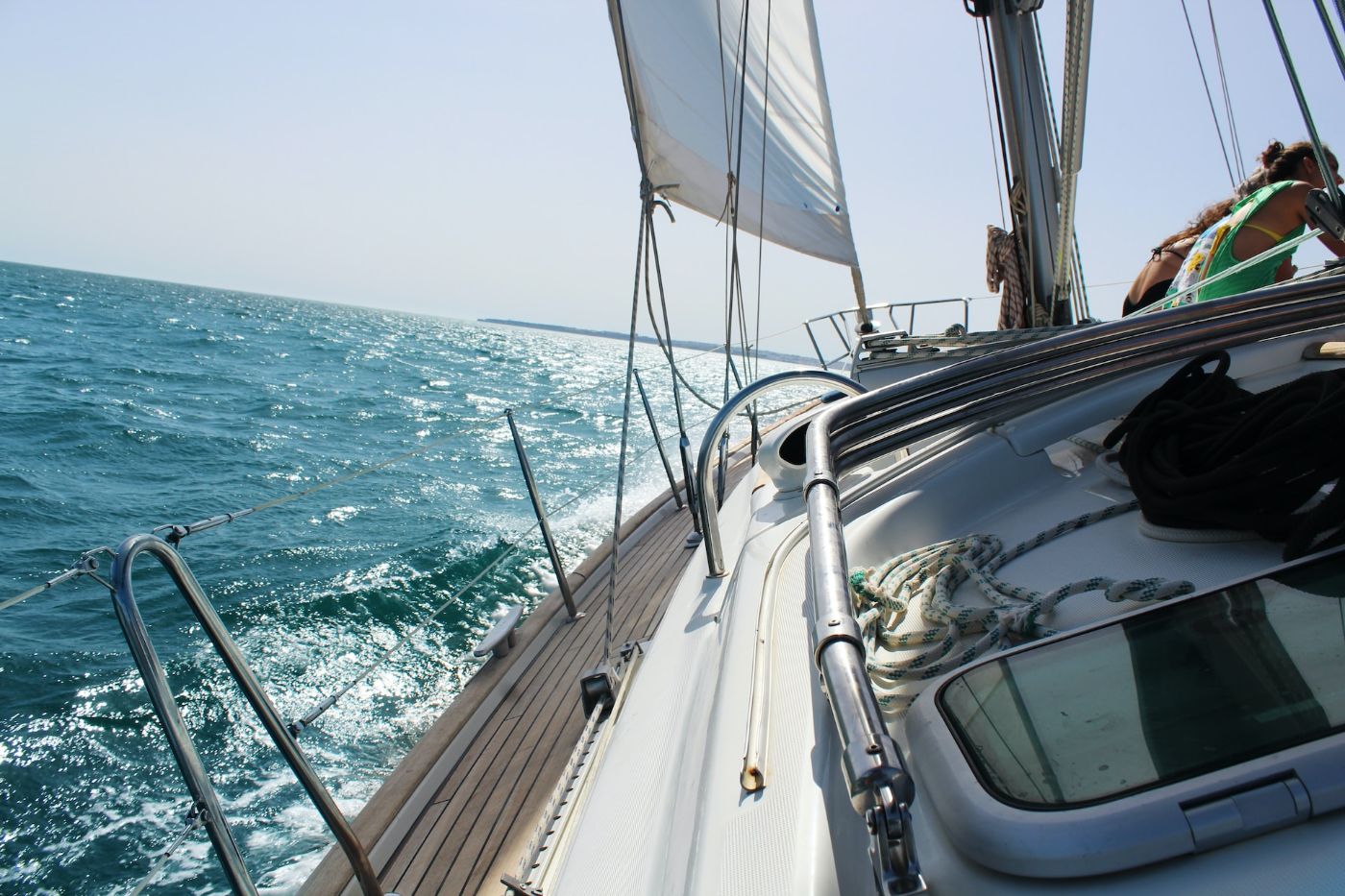
Catamarans provide better stability and comfort
Catamarans are more stable, less likely to cause seasickness and offer more living space and privacy. Below is a table summarizing why catamaran is more advantageous in this category:
In terms of motion in rough seas
Catamarans are more stable in rough seas because they have two hulls instead of one. This means that they are less likely to roll or heel, which can make for a more comfortable ride. Monohulls, on the other hand, tend to pitch and roll more in rough seas.
In terms of handling seasickness
If you are prone to seasickness, a catamaran may be a better choice for you. The stability of a catamaran means that it is less likely to cause seasickness than a monohull. Additionally, the living space on a catamaran is often spread out between the two hulls, which can help to reduce the feeling of confinement that can contribute to seasickness.
In terms of living space and privacy
Catamarans also tend to offer more living space and privacy than monohulls. Because the living space is spread out between the two hulls, each hull can function as a separate living space. This can be especially beneficial if you are traveling with a group of people and want to have some privacy.
Both boat types have specific advantages in performance and speed
A catamaran is generally faster and more stable than a monohull, but a monohull can be easier to handle in certain conditions.
In terms of navigating upwind
When sailing upwind, a monohull has the advantage over a catamaran due to its ability to point higher into the wind. This means that a monohull can sail closer to the wind than a catamaran, which will need to tack more often. However, a catamaran can make up for this disadvantage with its speed. A catamaran can sail faster than a monohull , which can help it to cover more distance in less time.
In terms of handling strong winds
In strong winds, a catamaran is generally more stable than a monohull due to its wider beam. This means that a catamaran is less likely to heel over, making it more comfortable for passengers. However, a monohull can be easier to handle in strong winds due to its ability to reef the sails. By reducing the sail area, a monohull can reduce the amount of wind it catches, making it easier to control.
Catamarans and monohulls have different designs and function
Catamarans offer more deck and cabin space, shallow draft, and increased buoyancy, while monohulls have a deeper draft, reduced drag, and increased stability.
In terms of the deck and cabin space
One of the advantages of catamarans over monohulls is their wider beam, which provides more deck space. This means more room to move around and increased stability, which is important in rough seas.
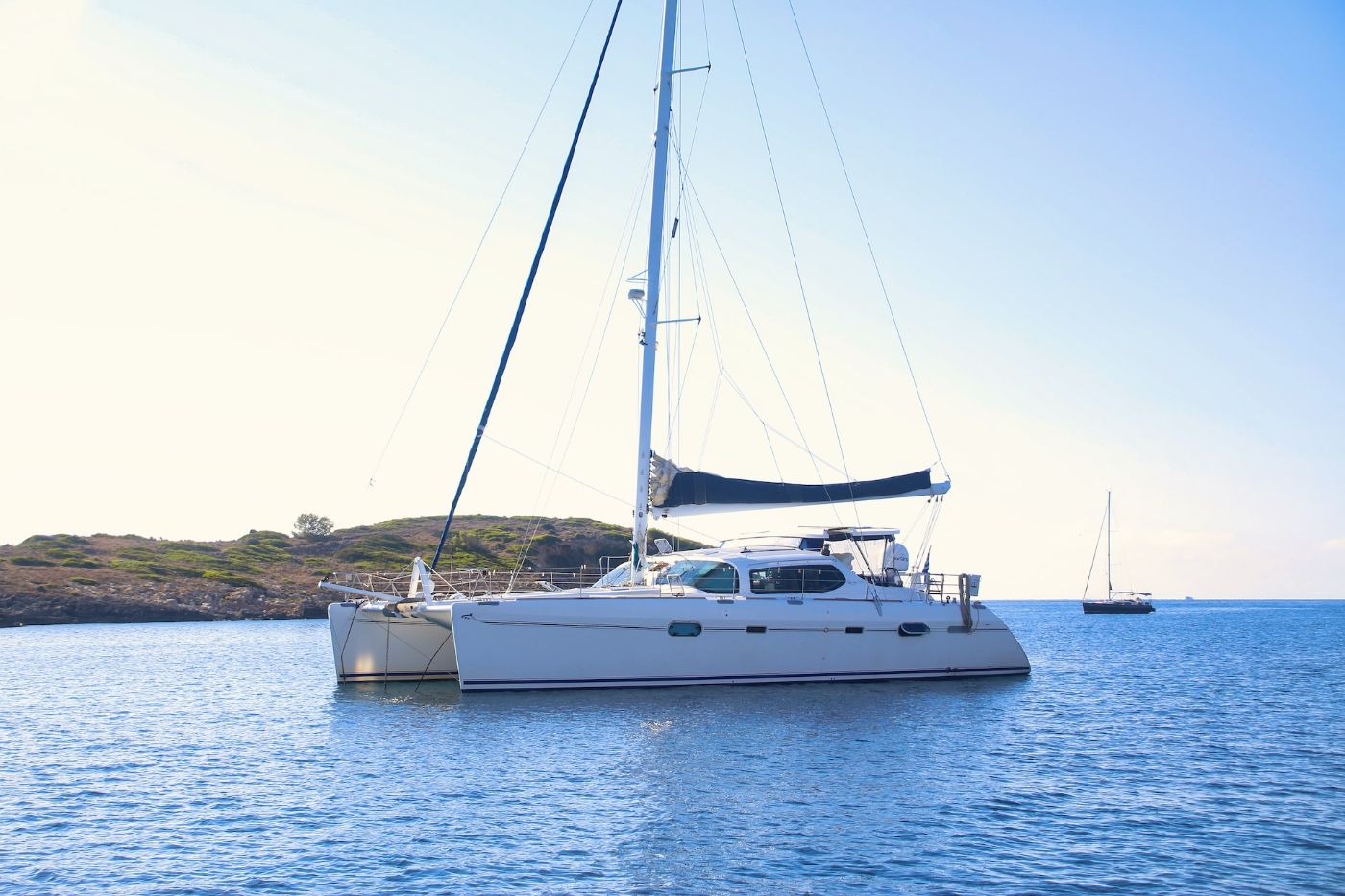
Additionally, catamarans usually have two hulls, which means more cabin space and privacy for the crew and passengers. On the other hand, monohulls have a single hull, which means less deck and cabin space. However, monohulls usually have a deeper draft, which allows them to sail closer to the wind and tack more efficiently.
In terms of draft and buoyancy
Catamarans have a shallow draft, which means they can sail in shallow waters and anchor closer to shore. This makes them ideal for exploring shallow coves and bays. Also, catamarans have two hulls, which provide increased buoyancy and stability in rough seas.
Monohulls, on the other hand, have a deeper draft, which makes them less suitable for shallow waters. However, their deep keel provides increased stability and reduces drag , which can be an advantage in rough seas.
Both boat types have unique safety considerations
Safety is a top priority when sailing in rough seas. Catamarans are generally more stable and easier to control, while monohulls have a greater risk of capsizing but are also more maneuverable in certain situations.
In terms of the risk of capsizing
One of the biggest safety concerns when sailing in rough seas is the risk of capsizing. Catamarans have two hulls, which make them more stable than monohulls. This means that they are less likely to capsize in rough seas. Catamarans are also technically unsinkable , meaning that they will not sink even if one hull is damaged or flooded.
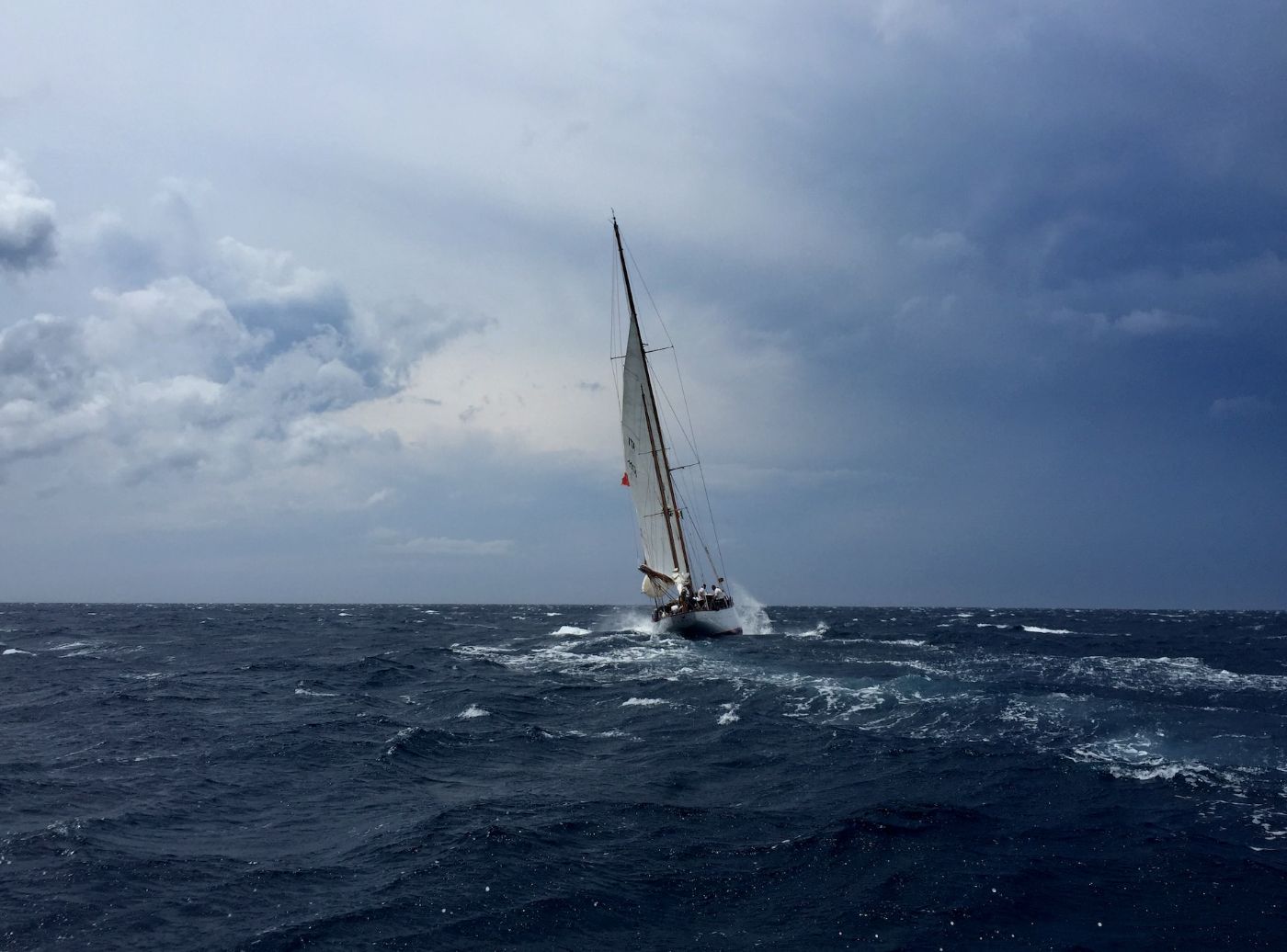
On the other hand, monohulls have a keel and ballast, which provide stability but also increase the risk of capsizing. If a monohull capsizes, it can be difficult to right the boat and prevent it from sinking.
In terms of navigational control
Catamarans have two rudders, which provide additional control and maneuverability in rough seas. This means that you can steer the boat more easily and avoid obstacles like rocks and other boats. Meanwhile, a monohull only has one rudder.
However, despite the number of rudders involved, the ability to control and maneuver the boat, whether a catamaran or a monohull, still depends on the design and construction of the boat, as well as the skill of the captain and crew in handling the boat.
Other practical considerations when choosing between catamaran and monohull
In terms of docking and anchorage.
Docking and anchorage can be easier with a catamaran due to the wider beam, which provides more stability. However, catamarans can be more difficult to maneuver in tight spaces due to their size. On the other hand, monohulls are generally easier to maneuver in tight spaces, but they may be less stable in rough seas.
For docking costs, catamarans tend to have higher docking rate costs due to their size and wider beam. Read this article to know more about the costs of docking a catamaran in different locations.
In terms of storage and equipment
Catamarans typically have more storage space than monohulls due to their wider beam and larger deck area. This means they can carry more gear and supplies, making them a good choice for longer voyages or liveaboard situations. They can accommodate larger equipment such as dinghies, kayaks, and paddleboards - making them a great choice for water sports enthusiasts who want to bring their gear along.
Monohulls, on the other hand, have less storage space due to their narrower beam and smaller deck area. This means they are better suited for shorter trips or day sailing, where less gear and supplies are needed. Monohulls may also be better suited for certain types of equipment, such as fishing gear or diving equipment, due to the layout of the boat.
In terms of crew accommodations
Catamarans tend to have more spacious accommodations than monohulls, which can be an advantage for longer trips or when traveling with a larger crew. However, monohulls may offer more privacy for individual crew members due to the separate cabins and tighter quarters.
Catamarans generally have more living space than monohulls so they can offer more room for sleeping, lounging, and cooking, which can be especially beneficial for larger crews or families. They also often have large, open salons and cockpits that allow for easy socializing and entertaining. This can be a great feature for crews who enjoy spending time together.
Monohulls, on the other hand, have less living space than catamarans due to their narrower beam. This means they may be better suited for smaller crews or shorter trips. They often have cabins located closer together, which can make it easier to communicate and work together as a crew, which is a plus for racing or cruising in crowded areas.
Choosing boat type based on personal preferences
In terms of aesthetics and personal taste.
One of the first things that come to mind when choosing between a catamaran and a monohull is aesthetics. Both types of boats have their unique look, and it is up to personal preference which one you find more appealing. Some people prefer the sleek and modern look of a catamaran, while others prefer the classic look of a monohull.
Another thing to consider is personal taste. If you are someone who prefers a more spacious and open boat, then a catamaran might be the right choice for you. On the other hand, if you prefer a more traditional sailing experience, then a monohull might be the better option.
In terms of suitability for families and couples
Basically, catamarans are known for their stability and spaciousness, making them a great choice for families with children or couples who want to have more space and privacy.
Monohulls, on the other hand, might not be as spacious as catamarans, but they offer a more traditional sailing experience. If you are a couple or a small family who wants to experience the thrill of sailing and doesn't mind being in close quarters, then a monohull might be the right choice for you.
Leave a comment
You may also like, cost of catamaran vs. monohull: which is more expensive.
The market for monohull sailboats is a lot bigger than that of catamarans, which is one of the reasons why they are so much cheaper.
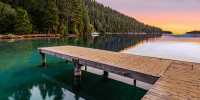
How Much Does It Cost to Dock a Catamaran? (7 Locations)
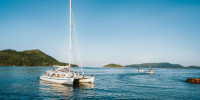
The Perfect Size Catamaran to Sail Around the World

17 Sailboat Types Explained: How To Recognize Them
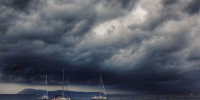
What Type of Hull Handles Rough Water the Best?
Own your first boat within a year on any budget.
A sailboat doesn't have to be expensive if you know what you're doing. If you want to learn how to make your sailing dream reality within a year, leave your email and I'll send you free updates . I don't like spam - I will only send helpful content.
Ready to Own Your First Boat?
Just tell us the best email address to send your tips to:

Catamaran and Monohull Compared: Which is Better, Faster, Safier, and More Stable in Rought Sea?
Catamarans and monohulls are two vessels that have distinct features from each other. Catamarans have two hulls connected by a bridge structure whereas, as the name suggests monohulls have a single hull.
Both types of vessels have different features in terms of both aesthetics and function, let’s get into the details to find out more.
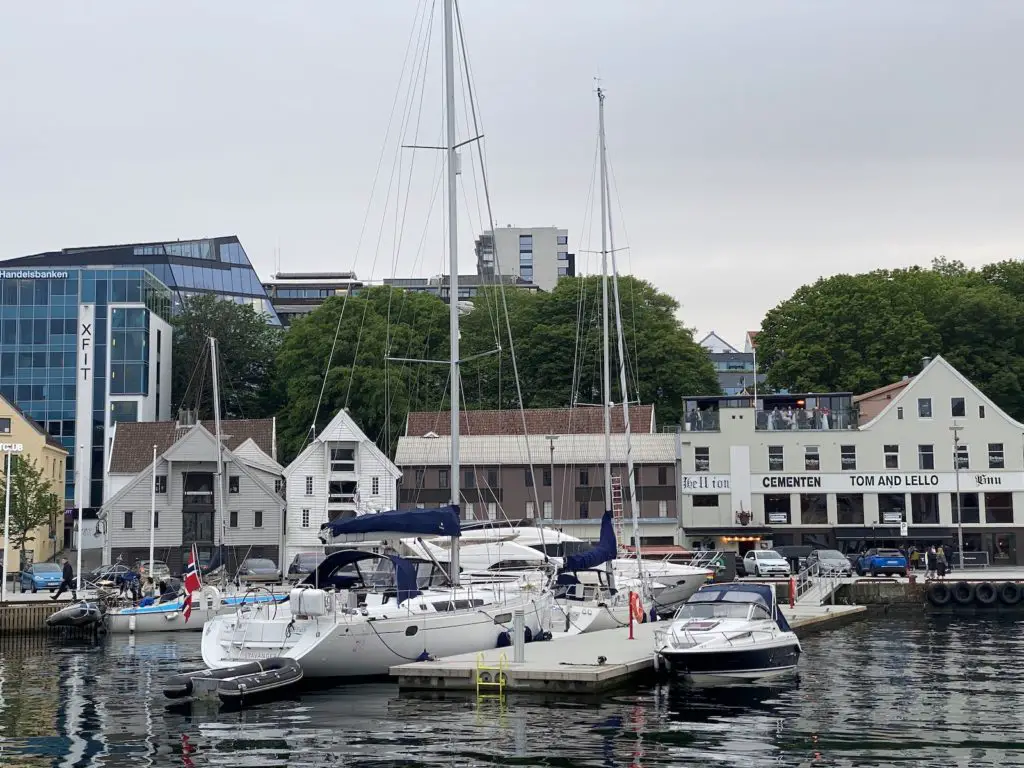
Do Catamarans Have More Space?
Since catamarans have two hulls, they are normally wider than monohulls. This gives the designers and owners the flexibility to maximize the space requirements in terms of space and function.
Vessels can be designed for either commercial or recreational uses. The additional space can serve as an advantage in both fields. In terms of recreational vessels such as yachts, the accommodation can be split up between the two hulls and can be well designed in such a manner that separate spaces can be allotted for the owner, guest, and crews with separate passages such that the path between the primary guests and the crew don’t collide.
In terms of interiors, the huge space addition can give the owners much more flexibility in choosing furniture without size restrictions and more space for additional appliances such as washers, dryers and so on which can make life on board much easier.
The deck can also house more people without the feeling of being enclosed in a closed space and for this reason, catamarans are normally used as party boats with wider deck space and more space to move around.
In terms of storage, catamarans have better storage options than monohulls as both the hulls can be utilized for different functions which not only increases the overall capacity of storage in terms of fuel , fresh water , cargo, and so on but also gives the designer an option to segregate the storage areas for different uses.
Catamarans are also now a growing trend in the fishing industry as the wide decks provide more area for the fisherman to move around without any obstructions making fishing much easier also, catamarans tend to roll less which stabilizes the vessel better than monohulls, giving more stable conditions for fishing without the risk of going aboard.
Due to the wider proportions, the spaces can also be designed in such a way so as to house tenders, jet-skis, and so on, on either of the deck spaces normally aft of the vessel mostly functioned by a small crane which can launch the vessel into the water.
Recreational activities such as swimming and diving can be performed with ease on both types of boats. On catamarans, the wide aft spaces also provide effective spacing for housing equipment and accessories such as dive tanks, telescopic staircases and so on which can serve as must-haves for similar activities.
The same can also be performed on monohulls with limitations to the width of the vessel. The wide superstructures on catamarans can also be used to house solar panels for green and renewable energy solutions which surely is going to be a great advantage in the near future.
Monohulls have the advantage of having wider compartments below the deck when compared to catamarans, as the overall width of the hull is larger than a single hull on a catamaran. This gives room for larger living spaces below the deck, which can have the option to walk around on either side of the bed.
Why Are Catamarans More Expensive Than Monohulls?
Catamarans are normally priced more than monohulls. This is because they have more overall area which requires more raw materials in the production stage than monohulls.
In terms of machinery, they have two or more engines on each hull depending on the width of each semi-hull and its supporting machinery which can increase the overall cost of the final product.
In terms of engines, maintenance is less frequent when compared to monohulls as they don’t need to operate on their maximum limits to push the vessel.
Maintenance costs can also be higher for catamarans as they have more machinery and more deck space, but on the contrary, the ease of maintenance will be much better in catamarans than monohulls as they have better accessible spaces.
The preventive maintenance for corrosion and marine growth on catamaran hulls is also higher as they normally have more area to treat than monohulls.
Are Catamarans Faster Than Monohulls?
Catamarans tend to outperform monohulls due to their slender hulls which help in reducing the drag forces. On performance power catamarans the space between the two hulls is called a “Tunnel” which is designed in a similar manner to an aerofoil so that it acts like a wing, which increases the aerodynamic lift forces thereby increasing overall efficiency and top-end speeds of the vessel.
The balance between the hydrodynamic and aerodynamic forces is the key aspect that determines the performance and stability of high-speed catamarans.
Fuel economy is normally better on catamarans due to the higher lift forces and lower water friction compared to monohulls which thereby reduces the overall load on the engines, reducing fuel consumption.
Is A Catamaran More Stable Than A Monohull?
Catamarans are generally more stable than monohulls in terms of roll stability. Let’s take an example of balancing a stick in the middle compared to balancing it by supporting the two ends, obviously, the second case has an advantage. In a similar manner, we can observe that catamarans have better roll stability when compared to monohulls.
This gives them an upper hand in terms of comfort and executing different operations onboard the vessel with ease, also reducing the risk of people falling on board the vessel. Catamarans are mostly used as ferries or passenger vessels as people tend to get less seasick on these kinds of vessels.
The deeper the deadrise the better the sea-keeping characteristics, most monohulls are designed with a deep v deadrise and tend to outperform catamarans which normally have displacement or semi-displacement hulls, in rough waters.
The typical catamarans are better in shallower water than rough water due to this reason and that’s why we see most of the coastal or inland cruisers as catamarans and most ocean-going vessels as deep v monohulls.
The draft can be defined as the distance of the waterline to the keel of the vessel. Catamarans normally tend to have a lower draft compared to monohulls which gives them an advantage of plying over shallower waters without the risk of grounding.
The lower the draft of the less the vessel, the less it is in contact with water, and therefore the overall water friction resistance is reduced leading to the need for lower power to push the vessel and better fuel efficiency.
What Is Easier To Sail A Catamaran Or Monohull?
For the thrill of sailing most sailors prefer monohulls over catamarans. They are sensitive to different forces like wind and waves acting on the vessel and there is an immediate response on the vessel. They ride through rough and choppy waves; this is the experience the sailors look forward to, giving them an adrenaline rush.
Sailing catamarans do not respond similarly to monohulls as the overall motions are reduced and also monohulls maneuver much easier than catamarans at high speeds.
Docking in marinas usually is easier with monohulls than catamarans as they require lesser space to mauver into the docking space.
Which Is Safer Catamaran Or The Monohull?
Catamarans normally tend to be on the safer side than monohulls in terms of backups and safety. If any machinery fails there is always a backup, say for example if rudder machinery fails on the port hull we can always get back ashore with the help of the starboard rudder, similarly if an engine fails there is always the second engine which can be used as a backup.
In terms of reserve buoyancy, if the port side hull gets damaged, the vessel will still remain afloat. These advantages can help people on board keeping them safe and saving a life.
The only downside to the above aspects is the maintenance costs which come up with the same as we discussed earlier.
Which One Should I Get?
The type of vessel should depend totally on your end goals in terms of functionality, performance, region of operation, and so on.
But always keep in mind never to get blinded by the length when you compare a monohull to a catamaran. A monohull in comparison might be longer but the overall space which is measured in cubic space will be higher in the shorter-length catamaran.
Going through the pros and cons the final decision should be made depending on your personal requirements.

About the author
I worked as an officer in the deck department on various types of vessels, including oil and chemical tankers, LPG carriers, and even reefer and TSHD in the early years. Currently employed as Marine Surveyor carrying cargo, draft, bunker, and warranty survey.
Leave a Reply Cancel reply
Your email address will not be published. Required fields are marked *
Save my name, email, and website in this browser for the next time I comment.
Latest posts

What Does a Longshoreman Do?
Longshoremen play a critical role in the global supply chain, bringing billions worth of cargo into the country. So what does a longshoreman do exactly?
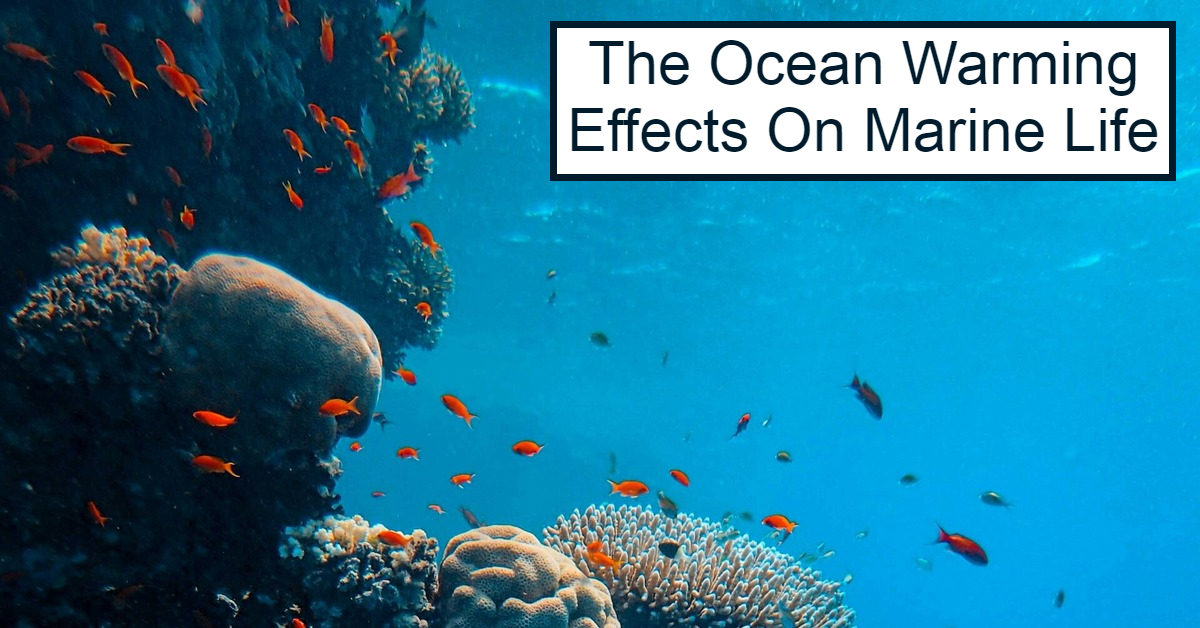
The Ocean Warming Effects on Marine Life
The last few decades have seen ocean temperatures rise as climate change begins to affect maritime industries worldwide. Here are the ocean warming effects on marine life seen so far.
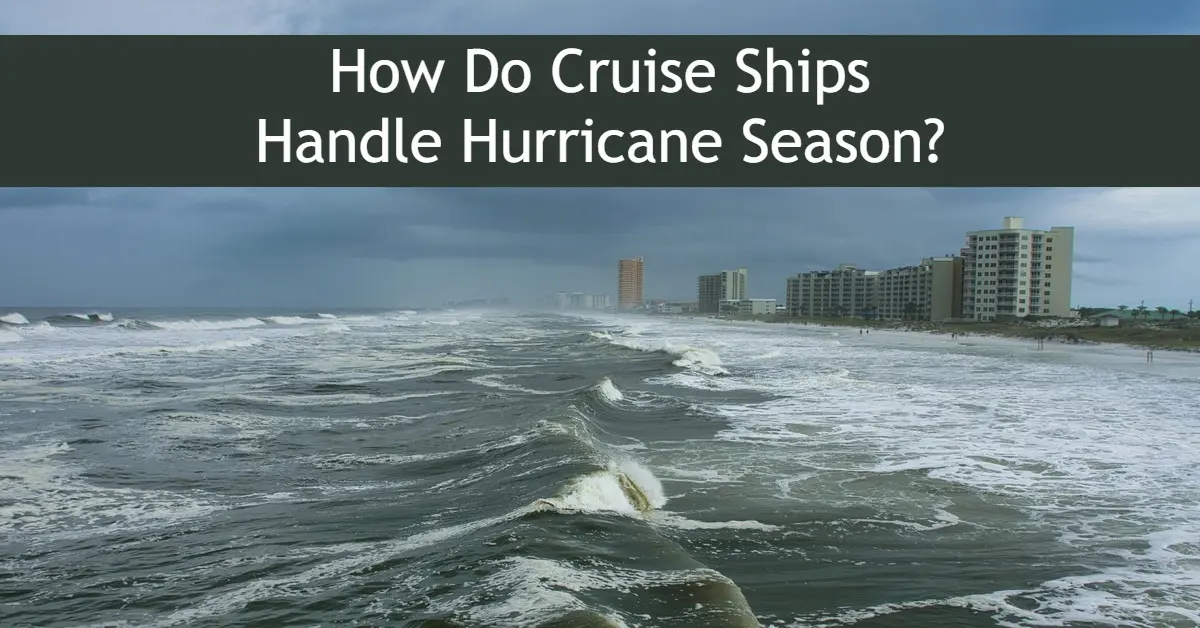
How Do Cruise Ships Handle Hurricane Season Cruises?
Thankfully, modern cruise ships can handle a hurricane season cruise. Due to past experiences and new advancements, crews prove these boats operate well no matter the weather.

Catamaran Vs. Monohull: Which Is Better?
When considering sailboats for cruising or liveaboard purposes, two primary options often come to mind: catamarans vs. monohulls. We know, because we’ve been there!
Having sailed full-time for four years on a monohull before swapping to a catamaran with the impending arrival of baby, we really understand the whole catamaran vs. monohull debate, and it isn’t clear cut.
Both types of vessels have their own unique characteristics, advantages, and considerations. Understanding the differences between catamarans and monohulls can help individuals make an informed decision based on their specific needs and preferences.
Catamarans are known for their spaciousness, stability, and comfort. With their twin-hull design and wide beam, catamarans offer generous living spaces, expansive decks, and increased privacy with separate hulls.
The stability provided by the twin hulls creates a smoother ride, reduced rolling motion, and enhanced comfort in a variety of sea conditions. Catamarans also tend to have better maneuverability, fuel efficiency, and shallow draft capabilities.
On the other hand, monohulls are characterized by their sailing performance and versatility. Their single-hull design, deep keel, and ballast provide excellent upwind performance and responsiveness.
Monohulls offer a traditional sailing experience with the sensation of heeling and a closer connection to the water.
They are often more cost-effective in terms of initial purchase price and maintenance expenses. Monohulls also provide more options for docking in marinas with narrower slips.
Choosing between a catamaran and a monohull ultimately depends on individual preferences, intended use, and priorities.
Factors to consider include space requirements, stability preferences, sailing performance, budget, cruising plans, and personal comfort levels. Spending time on both types of boats and seeking advice from experienced sailors can help in making a well-informed decision.
In the following sections, we will delve deeper into various aspects of catamarans and monohulls, exploring their advantages and considerations, including stability, speed, cost, maintenance, maneuverability, and more.
By examining these factors, individuals can gain a comprehensive understanding of which type of sailboat may be more suitable for their specific needs and aspirations.

As an Amazon Associate, we earn from qualifying purchases. We also earn from other affiliate programs. This means we may receive a small commission on products purchased through our links at no extra cost to you.
Table of Contents
Which is better catamaran vs. monohull, the advantages of catamarans, the advantages of monohulls, the disadvantages of catamarans, the disadvantages of monohulls, are monohulls safer than catamarans, maintenance, ability to maneuver.
- Fuel Efficiency
Which Is Better In Rough Seas?
- Which makes a better liveaboard Sailboat?

There are lots of advantages to both catamarans and monohulls. Both can be excellent sailing or power vessels and suit various different needs. There is always a big debate among sailors about which is actually better and honestly, we don’t have the answers!
There are so many plus and minus points for each that it’s hard to come to a logical conclusion without knowing a certain sailor’s needs first.
What advantages does one have over the other? Let’s explore that now to help you decide which one is right for your individual needs.

Catamarans offer several advantages that make them popular choices for various marine applications.
One key advantage is their superior stability. The two parallel hulls provide a wide base, which distributes the weight evenly and reduces the likelihood of tipping or rolling. This stability is especially beneficial in rough seas, making catamarans a preferred choice for cruising, offshore sailing, and passenger transportation.
Another advantage of catamarans is their speed performance. The twin hulls reduce drag and increase buoyancy, allowing them to achieve higher speeds with less power.
Catamarans are often faster than monohull boats of similar size, making them popular for racing, chartering, and personal use. The speed advantage of catamarans can be particularly appealing for those who enjoy thrilling water sports or need to reach their destinations quickly.
Catamarans are also known for their fuel efficiency. The design of catamarans minimizes drag and weight, enabling them to achieve higher speeds with less power and fuel consumption compared to monohull boats.
This advantage becomes especially significant during long-distance cruising, where fuel costs can be substantial. The fuel efficiency of catamarans not only saves money but also contributes to a more sustainable and environmentally friendly boating experience.
In addition to stability, speed, and fuel efficiency, catamarans offer other advantages as well. Their wide beam provides ample deck space, offering more room for socializing, entertaining, and enjoying outdoor activities.
Catamarans often feature spacious cabins, making them comfortable for extended periods on the water, whether for leisurely cruising or living aboard. The dual hulls also provide increased buoyancy, allowing for shallower drafts and access to more secluded anchorages and cruising grounds.
Furthermore, catamarans generally have shallower keels compared to monohulls, which allows them to navigate in shallower waters and access remote areas that might be inaccessible to deeper-draft vessels . This versatility opens up a broader range of exploration possibilities for catamaran owners.
Overall, the advantages of catamarans, including stability, speed, fuel efficiency, spaciousness, and versatility, make them attractive options for a variety of boating enthusiasts.
Whether for leisurely cruising, racing, chartering, or living aboard, catamarans offer a unique combination of features that enhance the boating experience.

Monohull boats offer several advantages that make them popular among sailors.
One of the key advantages is their excellent seaworthiness, particularly in challenging conditions. The deep, V-shaped hulls of monohulls provide stability and a smoother ride through waves and choppy waters.
This design allows monohulls to cut through the water efficiently, making them well-suited for offshore sailing and bluewater cruising.
When out in huge waves during an unexpected storm I found it hard to imagine how a catamaran would cope compared to our heavy bluewater monohull that just plowed through the waves as though they were butter.
Another advantage of monohulls is their superior upwind performance. The single hull design allows them to tack more effectively and maintain a higher pointing ability, making them ideal for sailors who frequently navigate against the wind. This advantage is particularly important for racing sailors and those who enjoy exploring areas where upwind sailing is common.
Monohull boats are typically more maneuverable than catamarans. The single hull allows for sharper turns and greater agility, which can be advantageous in tight spaces, marinas, or when docking.
The ability to maneuver easily makes monohulls more versatile in navigating narrow channels, entering small harbors, or handling in confined areas.
Additionally, monohulls offer a wide availability and variety of models, sizes, and configurations. They have been the traditional and widely available choice in the boating industry for a long time. This abundance of options allows boaters to select a monohull that suits their specific preferences, needs, and budget.
Monohull boats also often have a lower initial cost compared to catamarans of similar size and quality. The construction and design of a monohull are typically simpler, resulting in a more affordable purchase price.
This cost advantage can be significant for individuals or families entering the boating world on a limited budget.
Finally, monohull boats are generally easier to dock and berth in standard marina slips. Their single hull design allows for straightforward docking procedures and fitting into narrower slips designed for monohulls.
This advantage simplifies the process for boaters who frequently visit marinas or require regular docking facilities.
It’s important to note that the choice between a monohull and a catamaran ultimately depends on individual preferences, intended use, and specific requirements. Both types of vessels have their unique advantages and considerations, and it’s crucial to carefully evaluate these factors when selecting a boat that best suits your needs.

Catamarans, despite their advantages, also have some disadvantages that should be taken into consideration.
One notable disadvantage is the cost. Catamarans are generally more expensive than comparable monohull boats. The construction, materials, and design complexity of catamarans contribute to their higher price tag.
Additionally, maintenance, docking fees, and insurance costs can be higher due to the larger size and wider beam of catamarans. We’re only just starting to find out just how much more they cost, and it isn’t insignificant!
Another disadvantage of catamarans is the limited availability of berthing options. The wider beam of catamarans can pose challenges when it comes to finding suitable berths in marinas. Many marina slips are designed to accommodate monohull boats and may not have sufficient space for catamarans.
This limitation may require catamaran owners to seek specialized marinas or rely more frequently on anchoring.
The wider beam of catamarans can make maneuvering more challenging, especially in tight spaces, narrow channels, or crowded marinas. The increased width may require additional care and skill when docking or navigating in confined areas. Catamarans may also require specialized docking arrangements or wider slips to accommodate their size.
In heavy weather conditions, catamarans may experience some performance limitations. While they generally provide excellent stability, their wider beam can make them more susceptible to windage and slamming.
The larger surface area exposed to the wind can result in more resistance and difficulties maintaining course in strong winds. Skillful handling and careful sail management are necessary to optimize performance in challenging weather conditions.
Additionally, some sailors enjoy the heeling sensation experienced on monohulls when sailing close to the wind. Catamarans, with their stable platform, lack this sensation since they do not heel to the same degree.
This absence of heeling can be seen as a disadvantage for sailors who enjoy the dynamic experience of monohull sailing.

Monohull boats also have their own unique set of disadvantages.
One of the main disadvantages is their stability compared to catamarans. Monohulls typically have a narrower beam and a single hull, which can make them less stable in certain conditions, particularly in rough seas.
This may result in more rolling and pitching motions, which can be uncomfortable for some passengers.
Another disadvantage of monohulls is their potential for heeling. When sailing close to the wind, monohulls have a tendency to heel or lean to one side. While this is a characteristic appreciated by many sailors, it can be a disadvantage for those who prefer a more stable and level sailing experience.
Monohulls also tend to have limitations when it comes to living space and interior layout. The narrow beam of monohulls can result in smaller cabins and reduced interior space compared to catamarans. This can be a consideration for individuals or families looking for more spacious accommodations on their boat.
Additionally, monohull boats may have more limited access to shallow or restricted areas due to their deeper draft. The single keel design of monohulls often requires a deeper depth requirement, which can limit their ability to explore certain cruising grounds or navigate shallow waterways.
Lastly, monohull boats generally have a lower initial stability when at rest compared to catamarans. This means that while they may have better stability underway, monohulls can feel less stable and more susceptible to rolling when anchored or at the dock.
This may require additional measures such as stabilizers or careful weight distribution to enhance stability at rest.
Comparing Catamarans Vs. Monohulls

We’ve compared some of the most important factors to consider when choosing a boat.
Ultimately, I don’t think either a monohull or a catamaran is superior to the other, but simply superior to the individual sailors’ needs. Before you decide which is right for you it’s a good idea to spend some time on both and work out what your priorities are when it comes to choosing a vessel.
Hopefully these comparisons will help a little!
The safety of monohulls vs. catamarans is a topic that can vary depending on several factors. It is important to note that both types of vessels have their own safety considerations, and the overall safety can depend on various factors, including design, construction, maintenance, and the skill of the captain and crew.
One aspect to consider is stability. Catamarans generally offer better initial stability due to their wide beam and twin hulls.
This stability can provide a more stable platform for passengers and crew, reducing the likelihood of rolling or heeling in rough seas. However, it’s important to note that catamarans can still capsize if pushed beyond their design limits or operated improperly.
Monohulls, on the other hand, have a narrower beam and a single hull, which can result in a higher tendency to heel or roll. However, monohulls are designed to recover from heeling due to their deep keel and ballast system.
They generally have a higher risk of capsizing compared to catamarans but will right themselves if this happens. This is a big thing to consider. Do you want a boat that is less likely to capsize but will be far more catastrophic if it does, or a boat that is designed to capsize and then right itself again?
Seaworthiness is another consideration. Both monohulls and catamarans can be designed and built to be seaworthy.
The quality of construction, design integrity, and adherence to safety standards play a significant role in the seaworthiness of any vessel. A well-maintained and properly equipped boat, regardless of its type, can handle a wide range of sea conditions safely.
Another aspect to evaluate is motion comfort. This can be subjective and may vary depending on individual preferences.
Some people may find the gentle rocking motion of a monohull more comfortable, while others may prefer the stability and reduced motion of a catamaran. It’s essential to consider personal comfort levels and any potential motion-related concerns when choosing a boat.
Lastly, it’s important to emphasize that the safety of any vessel depends on factors beyond the boat itself, such as the skill and experience of the captain and crew, adherence to safety protocols, and proper maintenance.
Regular inspections, safety equipment, and knowledge of emergency procedures are crucial for ensuring safety on any type of vessel.
In conclusion, the safety of monohulls versus catamarans is not a straightforward comparison. Both types of boats can be safe when used appropriately and in accordance with good seamanship practices.
It’s essential to consider the specific design characteristics, maintenance standards, and individual preferences when assessing the safety of a particular vessel.

When comparing the stability of catamarans vs. monohulls, it’s important to consider their inherent design characteristics.
Catamarans, with their twin hulls and wide beam, generally offer better initial stability than monohulls. The separation of the hulls provides a larger base and increased resistance to rolling.
This stability advantage is particularly noticeable at rest and in calm or moderate sea conditions. Catamarans tend to have a more level sailing experience and minimal heeling, which can be appealing to those who prefer a stable platform.
On the other hand, monohulls have a single hull and a narrower beam. This design makes them more prone to heeling, especially when sailing close to the wind or in stronger gusts.
However, monohulls are designed with deep keels and ballast systems to provide stability and the ability to recover from heeling. The combination of their keel and ballast works to counterbalance the forces acting on the sails, enhancing stability and minimizing excessive rolling.
It’s important to note that the stability of both catamarans and monohulls can be influenced by factors such as weight distribution, sail plan, and sea conditions. Improper loading or sail handling can affect the stability of any vessel, regardless of its design.
In terms of overall stability, catamarans often provide a more initial stable platform due to their wider beam and twin hulls. However, monohulls can offer a different kind of stability through their ability to recover from heeling and their long-established track record of safe offshore passages.
We would advise you to experience both types of boats firsthand, if possible, to get a better sense of their stability characteristics and determine which suits your needs and preferences best.
Speed: Catamarans vs. Monohulls

When it comes to speed, catamarans and monohulls have distinct characteristics and performance capabilities.
Catamarans are generally known for their high-speed potential. The design of a catamaran, with its two hulls separated by a wide beam, offers reduced drag and increased stability, allowing them to sail at higher speeds.
The wide beam also provides a larger surface area for sail plans, enabling catamarans to harness more wind power.
Due to their lightweight construction and reduced resistance in the water, catamarans can often achieve faster speeds, especially in reaching and downwind conditions.
Monohulls, on the other hand, have a single hull and a narrower beam. Their design may result in increased drag and slower speeds compared to catamarans, particularly in light wind conditions.
However, monohulls are well-suited for upwind sailing, thanks to their ability to heel and make use of the lift generated by their sails. This characteristic allows monohulls to excel in close-hauled or beating angles, which can be advantageous when sailing against the wind.
It’s important to note that the specific design, size, and rigging of a catamaran or a monohull can greatly influence their speed potential.
Different models, materials, and sailing configurations will have varying performance characteristics. Additionally, the skill of the captain and crew in optimizing sail trim and harnessing the wind’s power also plays a significant role in achieving maximum speed.

The cost of catamarans and monohulls can vary significantly based on several factors, including the size, age, brand, construction materials, and overall condition of the vessel.
It is essential to consider both the initial purchase price and the ongoing costs associated with owning and maintaining the boat.
Catamarans, in general, tend to be more expensive than monohulls of similar size and condition. The construction, materials, and design complexity of catamarans often contribute to their higher price tag.
The wider beam, twin hulls, and larger deck spaces of catamarans require more materials and labor during the construction process, leading to increased costs. Additionally, the popularity and demand for catamarans can also impact their pricing.
Maintenance costs can be higher for catamarans compared to monohulls. Catamarans typically have more deck space, more systems and equipment, and two hulls to maintain, which can result in increased maintenance and repair expenses.
Furthermore, the cost of haul-outs, bottom paint, and other services may be higher for catamarans due to their wider beam and potentially larger size.
Docking fees in marinas can also be higher for catamarans. Many marinas charge slip fees based on the length overall (LOA) and beam of the vessel. Catamarans, with their wider beam, may require larger slips, resulting in higher docking fees compared to monohulls.
However, it’s worth noting that docking fees can vary between marinas and regions, so it’s important to research and compare the costs in the specific areas where you plan to moor your boat.
Insurance costs for catamarans are typically higher than for monohulls. Insurance premiums are influenced by various factors such as the value of the boat, its size, cruising area, and the owner’s experience.
Catamarans often have higher values, and their wider beam may result in higher insurance premiums compared to monohulls. It is crucial to obtain insurance quotes specific to the vessel you are considering to understand the potential costs involved.
It’s important to keep in mind that these cost considerations are general observations, and individual circumstances may vary. Factors such as age, condition, location, and market trends can all influence the actual costs of catamarans and monohulls.
You can definitely buy an older catamaran in bad condition for less than a newer, ready to sail monohull as we did! Or opt for a small catamaran for cruising instead of a larger monohull.
Conducting thorough research, consulting with experts, and obtaining specific quotes and estimates are advisable when evaluating the cost implications of owning either type of vessel.
In conclusion, while catamarans generally tend to be more expensive to purchase, maintain, and insure compared to monohulls, the actual costs can vary significantly based on individual factors.
It’s crucial to assess your budget, intended use, and long-term financial considerations when deciding between a catamaran vs. a monohull.

The maintenance requirements for catamarans and monohulls can vary based on factors such as size, age, construction materials, and the specific equipment and systems onboard.
Catamarans typically have more deck space and systems to maintain compared to monohulls. With two hulls, there are generally more areas to clean, inspect, and maintain.
This includes the hulls, decks, and various components such as trampolines, rigging, and bridge decks. The larger deck areas and additional systems, such as two engines, may require more time and effort for cleaning, maintenance, and routine checks.
The hulls of catamarans often require regular cleaning and antifouling to prevent the growth of marine organisms and maintain optimal performance. Due to their wider beam, catamarans may have a larger underwater surface area, which can result in increased costs for haul-outs, bottom paint, and related services.
Monohulls typically have a single hull and a more streamlined shape, which may make certain maintenance tasks more straightforward. The single-hull design can simplify tasks like hull cleaning, inspection, and maintenance.
However, monohulls may have deeper keels and other appendages that require attention and occasional maintenance, such as keel bolts, rudders, and through-hull fittings.
Both catamarans and monohulls have various onboard systems and equipment that require regular maintenance, such as engines, generators, plumbing, electrical systems, and navigation equipment.
The maintenance requirements for these systems can be similar regardless of the hull type, as they depend on the quality of the equipment, usage patterns, and adherence to recommended maintenance schedules. On a catamaran though, remember you’ll have double of most things!
It’s important to note that maintenance needs can also be influenced by the quality of construction, materials used, and overall condition of the vessel. A well-maintained and properly cared-for boat, whether a catamaran or a monohull, is likely to require less maintenance and be more reliable in the long run.
Regular inspections, maintenance checklists, and adherence to manufacturer guidelines and recommendations are crucial for ensuring the safety and longevity of any vessel.
In conclusion, while catamarans may have more deck space and systems to maintain, the specific maintenance requirements can vary depending on individual factors. Regular cleaning, inspection, and upkeep of hulls, systems, and equipment are essential for both catamarans and monohulls to ensure their safe and reliable operation.
When comparing the ability to maneuver, catamarans and monohulls have some differences based on their design characteristics.
Catamarans generally have better maneuverability in certain aspects. Due to their twin-hull design, catamarans typically have a smaller turning radius, allowing them to make tighter turns compared to monohulls. This can be advantageous when navigating in tight spaces, such as marinas or narrow channels.
The wide beam of catamarans provides inherent stability, which can contribute to a more predictable and controlled maneuvering experience. They have a reduced tendency to heel, allowing them to maintain a more level sailing platform while executing maneuvers. This stability can be particularly beneficial when sailing in challenging conditions or when performing quick maneuvers.
Monohulls, on the other hand, have different maneuvering characteristics. Their single-hull design allows them to tack more efficiently when sailing upwind, taking advantage of the lift generated by their sails. Monohulls can often point closer to the wind compared to catamarans, making them more effective in beating angles.
Monohulls with deep keels and rudders may have better tracking ability and may be more responsive to helm inputs compared to catamarans. This can make monohulls more agile and responsive during maneuvers such as jibing or changing course.
However, it’s important to note that the maneuverability of any boat depends not only on its design but also on factors such as size, weight, sail plan (how many sailboat masts ), rigging, and the skill of the captain and crew. The performance and maneuverability of a vessel can be influenced by the specific model, its handling characteristics, and the experience of those operating it.
Ultimately, the ability to maneuver a boat effectively depends on the individual’s familiarity with the vessel, understanding of sailing principles, and proficiency in handling various sailing maneuvers.
Practice, training, and experience are key factors in mastering the maneuvering capabilities of any sailboat, whether it’s a catamaran or a monohull.
It’s worth noting that modern catamarans and monohulls often incorporate advanced sail handling systems, such as electric winches and bow thrusters, which can enhance maneuverability and make handling the boat easier in certain situations.
In conclusion, catamarans and monohulls have their own maneuvering characteristics based on their design features. Catamarans generally offer tighter turning radius and better stability, while monohulls may excel in upwind sailing and responsiveness.
However, individual experience, skill, and familiarity with the vessel play significant roles in maximizing maneuverability for either type of boat. I’m terrified of docking the new catamaran considering how much bigger it is, but with practice you can get used to any vessel.
Fuel Efficiency: Catamarans vs. Monohulls

When comparing the fuel efficiency of catamarans vs. monohulls, there are several factors to consider that can impact their respective fuel consumption.
Catamarans, with their wide beam and twin-hull design, generally offer better fuel efficiency compared to monohulls of similar size.
The reduced hull drag and increased stability of catamarans contribute to improved fuel economy. The efficient hull shape and reduced resistance in the water allow catamarans to glide through the water more easily, requiring less power to maintain a given speed.
Monohulls, with their single hull and narrower beam, typically have higher hull drag and may require more power to maintain similar speeds compared to catamarans.
However, modern monohull designs incorporate advancements in hydrodynamics and sail technology, which can help optimize fuel efficiency. Efficient hull shapes, bulbous bows, and streamlined appendages can all contribute to improved fuel economy in monohulls.
The specific speed and conditions of sailing can significantly impact fuel efficiency for both catamarans and monohulls.
Generally, sailing at lower speeds or utilizing downwind conditions can improve fuel efficiency, as it reduces resistance and minimizes the need for engine power. On the other hand, pushing a vessel to its maximum speed or sailing against strong headwinds can increase fuel consumption.
Other factors that can influence fuel efficiency include the size and weight of the vessel, the engine type and power, the sail plan, and the cruising habits of the captain and crew.
Efficient propulsion systems, such as modern diesel engines or hybrid electric systems, can further enhance fuel efficiency for both catamarans and monohulls.
It’s important to note that the fuel efficiency of any boat is also influenced by factors such as maintenance, proper hull cleaning, and overall vessel condition. Fouled hulls, dirty propellers, and inefficient systems can increase drag and reduce fuel efficiency.
Ultimately, the fuel efficiency of a catamaran or a monohull can vary depending on multiple factors, and it’s challenging to make broad generalizations. When considering the fuel consumption of a particular vessel, it’s essential to evaluate the specific design, size, engine setup, and cruising habits to obtain a more accurate understanding of its fuel efficiency capabilities.
In conclusion, catamarans generally offer better fuel efficiency compared to monohulls of similar size, thanks to their reduced hull drag and increased stability.
However, advancements in monohull design and technology have narrowed the gap, and modern monohulls can also achieve respectable fuel efficiency. The specific vessel, its design, engine setup, and cruising habits will ultimately determine the fuel efficiency of a catamaran or a monohull.

When it comes to determining which is better in rough seas, whether a catamaran vs. a monohull, it depends on various factors and personal preferences.
Both types of vessels have their own strengths and considerations in rough conditions and it took us a lot of research to work out that really there isn’t a ‘better vessel’, just different preferences.
Catamarans, with their wide beam and twin-hull design, generally offer better stability and reduced rolling motion in rough seas. The separation of the hulls provides a larger base and increased resistance to rolling, resulting in a more stable platform.
This can contribute to a smoother and more comfortable ride, particularly in waves or when the sea state is challenging.
The inherent stability of catamarans can also be advantageous when sailing in rough seas, as it reduces the tendency to heel excessively and maintains a more level deck. This can enhance safety and comfort for crew and passengers, as well as provide better accessibility to onboard amenities and reduce the risk of items shifting or falling.
Adam and I have always found that the constant rolling on our monohull caused lots of opportunities for accidents, and even sometimes prevented us from checking things on deck because we felt too unsafe to move around up there in heavy seas.
On the other hand, monohulls are known for their ability to handle rough seas and heavy weather conditions effectively.
Their single hull design, with a deep keel and ballast, allows them to slice through waves and provide a more predictable motion in challenging sea states. The weight and ballasting of monohulls contribute to their ability to maintain course stability and resist being pushed around by waves and wind.
Monohulls also have a reputation for their ability to “self-right” in extreme situations, where their inherent stability helps them recover from a knockdown or capsize. This characteristic can provide added safety and reassurance in rough seas.
It’s worth noting that the specific design, size, construction, and condition of a vessel can significantly influence its performance in rough seas.
Heavy weather sailing often requires proper preparation, including reefing sails, securing loose items, and ensuring the boat is seaworthy and equipped with appropriate safety gear.
Additionally, the skill and experience of the captain and crew play a crucial role in handling a boat in rough seas. Understanding the vessel’s limitations, practicing good seamanship, and making sound decisions based on prevailing conditions are vital regardless of the type of boat.
Which Makes A Better Liveaboard Sailboat?
Determining which sailboat makes a better liveaboard depends on individual preferences, lifestyle, and specific needs. Both catamarans and monohulls can offer advantages and considerations for liveaboard sailing.
Catamarans are often preferred as liveaboard sailboats for several reasons:
- Space and Comfort: Catamarans generally offer more interior space and living area compared to monohulls of similar size. The wide beam allows for spacious cabins, larger saloons, and generous deck space , providing a more open and comfortable living environment.
- Stability: Catamarans’ twin-hull design provides inherent stability, minimizing rocking and rolling motion. This stability can contribute to a more comfortable living experience, especially for those prone to seasickness or families with young children.
- Privacy: Catamarans often have separate hulls with cabins located in each hull. This layout can provide increased privacy, making them suitable for couples, families, or individuals who value their own space.
- Accessibility: The level decks of catamarans make it easier to move around the boat, especially for those with mobility challenges or families with young children. The absence of heeling allows for a more stable and safer environment while underway or at anchor.
Monohulls also offer advantages for liveaboard sailing:
- Sailing Performance: Monohulls are known for their sailing performance, particularly upwind. They typically have better windward ability and can handle a wider range of sailing conditions. If sailing and performance are priorities, a monohull may be preferred.
- Cost: Monohulls generally have a lower purchase price and maintenance costs compared to catamarans of similar size and condition. This can be advantageous for those on a tighter budget or looking to minimize expenses.
- Traditional Experience: Many sailors appreciate the traditional experience of sailing a monohull. The heeling sensation and close connection to the water can provide a sense of adventure and immersion in the sailing lifestyle. We have to say, we loved the romance that living on board our monohull gave.
- Docking and Marinas: Monohulls generally require narrower slips, making them more suitable for certain marinas and docking situations where space may be limited. This can provide more flexibility in choosing berthing options (and cheaper too!)
Ultimately, the choice between a catamaran and a monohull as a liveaboard sailboat depends on individual preferences for space, comfort, stability, performance, budget, and intended use. Check out the best shallow draft liveaboard sailboats .
We would recommended you spend time on both types of boats, perhaps through charters or boat shows, to experience firsthand their layout, handling, and suitability for living aboard.
If you can’t do this, then we would suggest you buy a cheap boat to start with and spend six months living aboard to work out what you really want and need from a liveaboard boat.
Consulting with experienced liveaboard sailors can also provide valuable insights and perspectives based on their own experiences, and watching sailing YouTube channels can also help you form an idea of what you might need.
Conclusion: Catamaran Vs. Monohull

In conclusion, the choice between a catamaran and a monohull depends on various factors and personal preferences. Both types of sailboats offer distinct advantages and considerations.
Catamarans excel in areas such as spaciousness, stability, and comfort. Their wide beam provides ample living space, and their twin-hull design offers inherent stability, making them popular choices for liveaboard sailors seeking a comfortable and roomy living environment.
Catamarans also have advantages in terms of maneuverability, fuel efficiency, and shallow draft capabilities.
Monohulls, on the other hand, are known for their sailing performance, particularly upwind. They offer a traditional sailing experience with a heeling sensation and a closer connection to the water.
Monohulls generally have lower purchase and maintenance costs compared to catamarans, making them more budget-friendly options. They can also be advantageous in certain docking situations and marinas that have narrower slips.
It is important to consider factors such as space requirements, stability preferences, sailing performance, budget, and specific cruising plans. It is advisable to spend time on both types of boats to gain firsthand experience and insights into their handling, comfort, and suitability for specific needs.
Consulting with experienced sailors, attending boat shows, and seeking professional advice can also provide valuable guidance in making an informed decision.
Ultimately, selecting the right sailboat, whether a catamaran or a monohull, is about finding the vessel that aligns with your preferences, lifestyle, and goals for the sailing experience.
Similar Posts
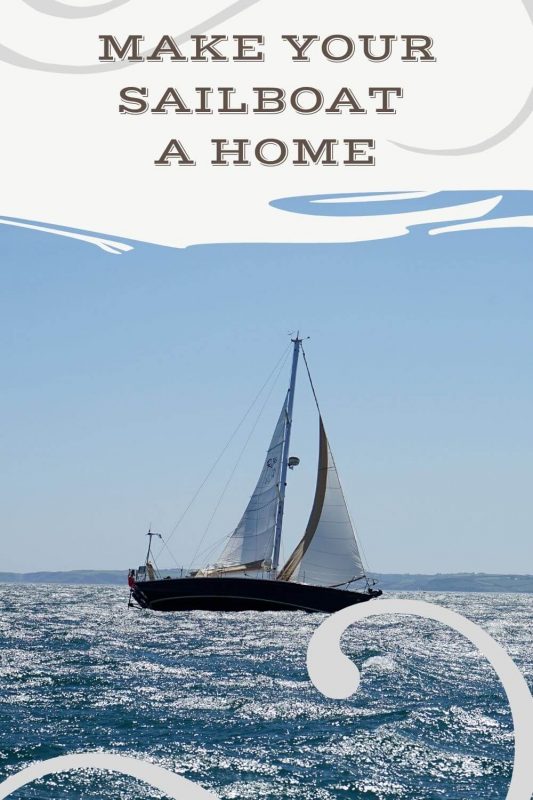
Making Your Sailboat Feel Like Home: Must Have Home Comforts

Storm Sails: The Ultimate Guide
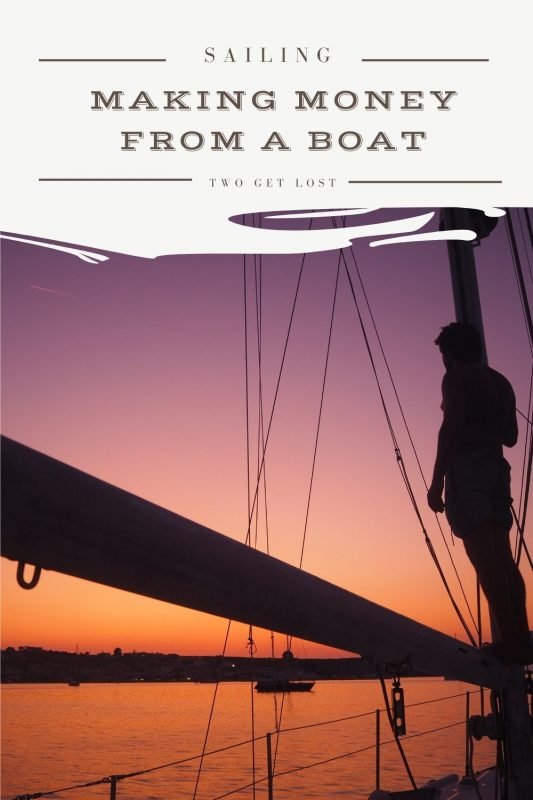
How to Make Money While Living on a Sailboat

Sailing Close To The Wind: How And Why You Should

How To Start A Life At Sea

Can You Live On A Boat On Land And What’s It Really Like?
- Search Search Hi! We’re Emily, Adam and Tiny Cat, liveaboard sailors travelling the world on our 38ft sailboat and writing about it as we go. We hope we can inspire you to live the life you’ve always dreamed, whether that’s exploring the world or living a more simple way of life in a tiny home. Find out more. Patreon
- Privacy Policy
Catamaran vs. monohull: Navigating the waters in style and comfort
- Catamaran vs. Monohull: Navigating the waters in style and comfort
Embarking on a journey across the open waters has long captured the human spirit of adventure. The realm of sailing offers a plethora of options, each delivering its own unique experience. Among these, catamaran sailing stands out as a modern and luxurious way to navigate the seas. In this article, we delve into the world of catamaran sailboats, compare them to monohull counterparts, and help you discover the ideal choice for your maritime dreams.
Unveiling catamaran sailboats
Catamarans, known for their twin hulls and spacious decks, have redefined the sailing experience. These impressive vessels offer stability, ample space, and a comfortable layout, making them a favorite among sailing enthusiasts. Whether you're a seasoned sailor or a beginner, a catamaran promises a remarkable adventure on the water.
The thrill of sailing a catamaran
Sailing a catamaran brings a new level of excitement. The feeling of gliding through the water with minimal heeling is exhilarating. The wide deck areas provide plenty of space for relaxation, sunbathing, and socializing. Catamarans are also well-equipped with modern amenities, ensuring a comfortable journey.
Read our top notch articles on topics such as sailing, sailing tips and destinations in our Magazine .
Monohull sailboats: A classic choice
Monohull sailboats, with their single hull design, embody tradition and elegance. These boats are known for their responsiveness to wind and waves, offering an authentic sailing experience. While they may have less space compared to catamarans, their sleek design and maneuverability make them a beloved choice for purist sailors.
Choosing between catamaran and monohull
Deciding between a catamaran and a monohull often boils down to personal preferences. Catamarans excel in stability and space, making them suitable for larger groups and extended trips. Monohulls, on the other hand, offer a classic sailing feel and perform well in various weather conditions. Consider your priorities and the type of adventure you seek.
Sailing catamaran: A luxurious experience
Catamarans offer more than just a sailing experience; they provide a luxurious way to explore the waters. With spacious cabins, well-appointed kitchens, and modern bathrooms, catamarans feel like floating vacation homes. The comfort and opulence they offer have elevated the world of maritime leisure.
Navigating choppy waters: Monohull vs. catamaran
In rough seas, the design of a catamaran shines through. Its twin hulls provide excellent stability, reducing the rocking motion common on monohulls. If comfort during challenging weather is a priority, catamarans have a clear advantage.
Sailboat catamaran: Best of both worlds
For those who desire a mix of tradition and modernity, sailboat catamarans offer the best of both worlds. These vessels combine the classic aesthetics of monohulls with some of the space advantages of catamarans. Sailboat catamarans cater to sailors who value both performance and comfort.
Setting sail: Monohull yacht adventures
Monohull yachts, especially those designed for racing, offer a thrilling experience on the water. The feeling of harnessing the wind's power to glide through the waves is unparalleled. Monohull yachts are favored by competitive sailors and those who relish the art of traditional sailing.
Exploring the multihull sailboat
Beyond catamarans, the realm of multihull sailboats includes trimarans, which have three hulls. Trimarans offer a unique combination of stability and speed, making them suitable for both leisurely cruises and exhilarating races. They are perfect for those seeking a balance between comfort and performance.
Catamaran sailing yachts: Unmatched elegance
Sailing yachts built on the catamaran platform exude elegance and sophistication. These vessels are designed to provide a lavish experience, with spacious cabins, gourmet kitchens, and lavish lounging areas. Catamaran sailing yachts redefine luxury living on the open sea.
Catamaran landing near Anse Severe on La Digue Island, Seychelles
Monohull vs. multihull: Making the right choice
Choosing between a monohull and a multihull depends on your preferences and intended use. Multihulls, including catamarans and trimarans, offer stability and space. Monohulls provide a classic sailing feel and are favored by those who appreciate tradition. Consider your priorities and aspirations to make an informed decision.
Catamaran sailing safety and tips
Safety is paramount when sailing, regardless of the vessel type. Catamarans' stability reduces the risk of capsizing, but it's essential to follow safety guidelines and weather forecasts. Proper training, regular maintenance, and responsible navigation contribute to a safe and enjoyable sailing experience.
Catamaran sailing offers a blend of luxury, comfort, and adventure on the open waters. Monohulls continue to captivate with their classic charm and sailing prowess. Both options cater to different tastes and aspirations, ensuring that the world of sailing remains diverse and inviting.
So what are you waiting for? Take a look at our range of charter boats and head to some of our favourite sailing destinations .
FAQs about catamaran vs. monohull

A Trusted Source For Boating Information Since 2019
The battle of the boats: catamaran vs. monohull in rough seas.
- Post Written By: Boater Jer
- Published: November 7, 2022
- Updated: November 7, 2022

Disclaimer: You might notice that we recommend products in some articles. We may earn a commission for referring you if you click the link and buy a product.
We only recommend products we’ve tried/tested/own (that’s why you won’t find thousands of affiliate links on my site). If you have experience with one of the products we’ve mentioned, please share your experiences in the comments at the end.
Advertisement

Catamaran vs. Monohull in Rough Seas? Catamarans and monohulls are boats that are pretty different from each other. Although the term catamaran applies to any vessel with multiple hulls, most catamarans are from two hulls connected by decks and outriggers to prevent capsizing in rough seas, while monohulls only have one hull.
Catamarans are typically faster and more efficient than monohulls, but the latter tend to be less expensive and easier to maintain. It’s imperative to understand the capabilities of different boats when planning your next trip on the open ocean.
This guide will help you figure out which boat would be better suited to handle rough seas and why, so you can make an informed decision when choosing your next vessel. You’ll learn what each type of boat excels at, how they handle varying conditions, and the key differences between catamarans and monohulls so you can pick the right one to match your needs. Let’s get started!…
What Are The Differences Between Catamaran vs. Monohull in Rough Seas?
Several key differences between catamarans and monohulls impact the way they handle rough seas . Here are some basics to help you choose the right boat for your next trip, whatever kind of water you’re venturing. For example, a catamaran has two hulls on either side connected by a keel beam. It gives it more stability than a monohull—which only has one hull—in choppy waters because it can ride over waves rather than get knocked around by them. In addition, as mentioned above, boats with multiple hulls tend to be less affected by changes in wave height or frequency than their single-hulled counterparts.
How Does The Amount of Hulls Affect Performance In Rough Seas?

Regarding performance in rough seas, catamarans and monohulls differ in a big way. For starters, catamarans become more stable when you’re going on stormy seas because they have more buoyancy than their monohull counterparts. However, most smaller boats are better suited for rough conditions than larger boats.

How Can You Test For Yourself Which Boat Is Better For You?
Of course, you can’t just jump on a catamaran and head out to rough seas to test its seaworthiness. But there are ways to try for yourself which boat is better for you. For example, if you’re considering buying a monohull or catamaran but aren’t sure which one will be best for your situation, look at your local weather patterns. If storms are common where you live, it might be wise to consider getting a boat that can handle rougher waters—which may mean opting for a catamaran over a monohull.
Which Kind Of Boat Do I Need?
Many wonder which kind of boat is best for them—one to sail across calm waters or conquer choppy seas. In truth, both can be used on several different water bodies and are effective for everyday use. But each boat has its benefits and drawbacks, and it may be wise to invest in a watercraft that aligns with your needs.
- Latest Articles
- Article Sources
- Crab Island by Pontoon: A Fun Watery Boating Guide Destination in 2024
- Upgrade Your Boating Experience: Adding a Third Pontoon Made Easy!
- How Long Does It Take A Canoe To Go… (Canoe Calculator Here)
- In-Depth Review of the Pelican Sentinel 100X Fishing Kayak: Pros, Cons, and Performance
- How To Put A Kayak In The Water – The Ultimate Guide For New Kayakers
- Davis, M. R., and D. S. Holloway. “A comparison of the motions of trimarans, catamarans, and monohulls.” Australian Journal of Mechanical Engineering 4.2 (2007): 183-195.
- Targan, Barry. “Building Boats.” The North American Review, vol. 292, no. 3/4, 2007, pp. 71–73. JSTOR, http://www.jstor.org/stable/25478919 . Accessed 15 Jun. 2022.
replicarolex.is

Share this post with your friends
Subscribe to our newsletter.
Join us in our love for all things water. And Adventure.

Chasing Dory 5 Thruster Underwater Drone Review
Advertisement Every time you go on a marine or a boat trip, the major issue that arises is preserving memories. It is easy to snap pictures when you’re on the land, but what if you want to capture underwater images? That’s right, in such a scenario, what saves the day is an underwater drone. So,

Why Are Boat Steering Wheels So Big?
Advertisement You see them on the water in summer or all year round, depending on where you live, boats, and lots of them. Riding on the water on a ship is calming and relaxing unless you are racing, then it can be exhilarating and action-filled! I have been on many boats of different shapes and

Can Snow Damage A Kayak
Advertisement Asking ‘Can snow damage a kayak?’ is a good idea when selecting a location for kayak winter storage. However, kayak outside storage for winter may not be the best solution, at least not for your kayak’s hull integrity. Snow can cause significant damage to your kayak. However, it is not just snow that can

A Guide To The Materials J-B Weld Works On (With Some Awesome Tips To Help)
Advertisement If you’re looking for the materials J-B Weld works on, you’re in the right place. J-B Weld is a great cold weld, which comes as a two-part epoxy system offering a long-lasting and robust weld on several surfaces. The J-B weld is mixed in a ratio of 1:1 and molded to the desired shape,

Do Kayaks Tip Easily?
Advertisement Do kayaks tip easily? I wondered this myself when I first started kayaking years ago. Learning to kayak is like learning to ride a bicycle. It would be best to learn how to balance a position that may not be part of everyday life. It is a learned sense of balance that only comes

Can You Use A Bass Boat In Saltwater?
Advertisement Bass boat in saltwater? Really? Going fishing on a fine sunny day might come to your mind. However, you only have a bass boat as your best companion. It leaves you to question if you can use your boat in saltwater? Saltwater contains a tremendous amount of salt, as the name suggests. This salt

Boat Information By Type
© 2023 Boating.Guide, A Hyperwave Media Group Ltd. Publication.
Privacy Overview
- Catamaran vs. Monohull: What Type of Boat is Right for You?
- Sailing Hub
- Sailing Dilemmas
- Catamaran vs. Monohull - which one should you choose?
When you are planning a sailing holiday, you’ll be faced with a choice; catamaran vs. monohull. Each type has many benefits, but it’s important to think about what your needs are because that will tell you just which one to pick!
Let's dive right in!
Ease of sailing
Maneuverability, space/layout, holiday vibe.
You may also like: Sailing holiday destinations for your next boat trip
One of the top considerations you should have is what type of sailor you are because catamaran vs monohulls offer a distinctly different sailing experience. If you are a first time sailor and just want something incredibly easy to handle, then a catamaran will probably win out.
Catamarans have great control when it comes to maneuvering in tight places. Since they have twin engines and rudders, you get a lot of control and can turn pretty much 360 degrees with ease.
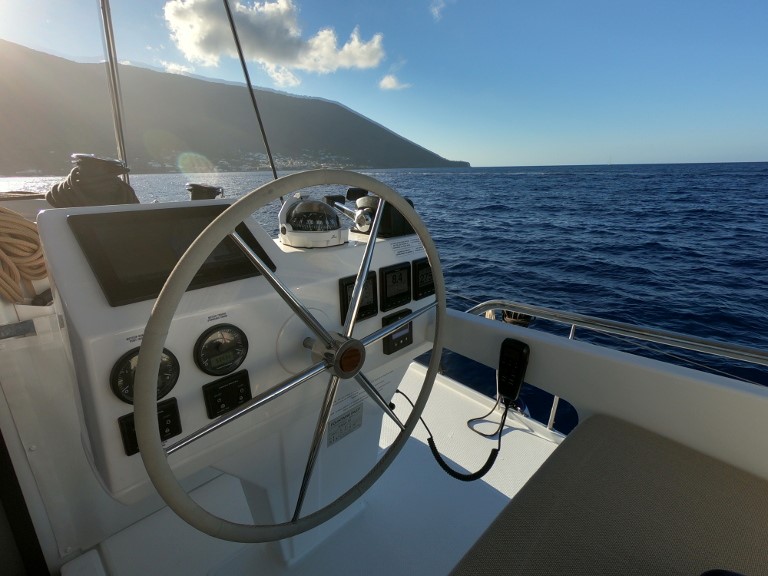
Catamarans also have a shallow draft, which will allow you to explore much closer to the shoreline than a monohull would be able to venture.
In the catamaran vs monohull speed debate, it might be more of a draw. Catamarans are typically 25-30% faster than a comparable monohull, but some argue that it comes at a price. When catamarans are sailing full speed you might experience a lot of slapping from the waves. Monohulls are designed to cut through the water. Also note that catamarans can be inefficient upwind and tack slowly.
When considering sailing conditions , a catamaran vs monohull in rough seas will perform very differently.
During rough sailing, you must be more vigilant when on a catamaran. The feedback from the wheel of a cat is not as obvious as that from a monohull. In high winds, you’ll need to know when to reduce sail.
However, monohulls tend to roll more in stormy weather, while catamarans stay pretty level even in rough seas.
When thinking about catamaran vs monohull stability, the stability that catamarans offer is a huge draw for many. Since cats bounce with the waves less, it is easier to walk around and enjoy the yacht while in motion. The increased stability is also great for children, or seniors, or anyone who might be prone to seasickness. When it comes to catamaran vs monohull seasickness, catamarans come out on top.
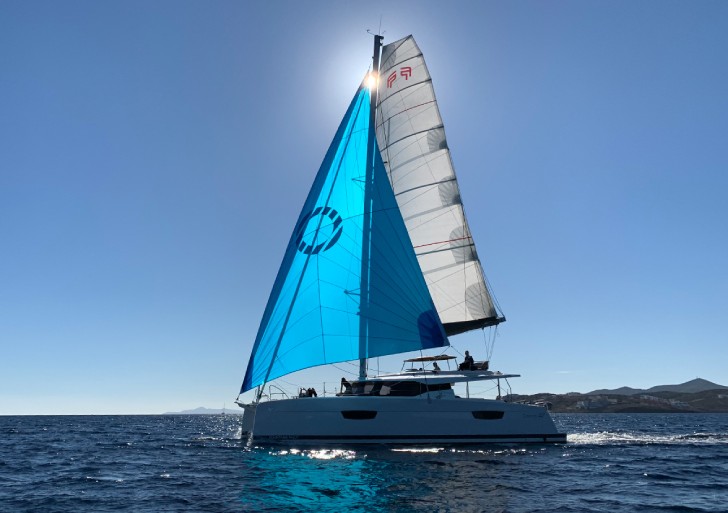
Although it is worth noting that monohulls swing less than catamarans if placed side by side in an anchorage.
If you’re deciding on a catamaran vs. monohull, you’ll have to think about what type of group you have. For family sailing holidays , maybe a catamaran is the best choice. Catamarans are very spacious, offering a large living space, and many cabin/head options. This makes them optimal for parties that want to spread out. Whether you’re a family, a big group of friends, or even couples looking for a 5 star, luxury experience who appreciate the extra space and comfort even if it’s not needed, a catamaran can fit your needs.
If thinking about catamaran vs monohull liveaboard readiness, the catamaran is a top contender. With far more living space and a much more spacious kitchen, Catamarans are great for people and groups that want to focus on entertainment and lounging.
Catamarans also typically have more spacious cabins and more privacy due to the layout with the cabins separate from the living area. This way you can send the kids to bed, and still enjoy the kitchen, dining, and living area.
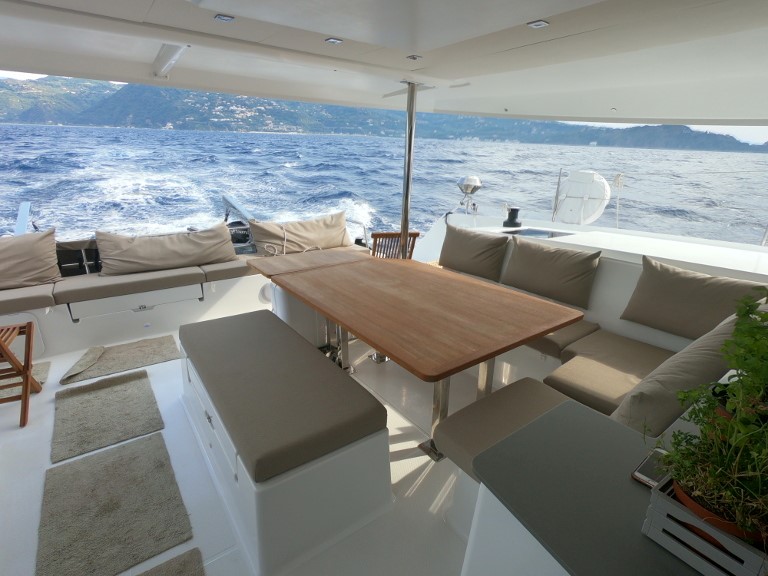
While catamarans are often touted for being roomy and luxurious, it’s worth nothing that monohull yachts can also be large and luxe. The Oceanis 62 and the Jeanneau 64 are top choices for those who want to live in the lap of luxury during their sailing holidays , while still getting that real sailing yacht experience.
In terms of catamarans vs monohull price , a monohull will definitely win. Charter prices for a catamaran can be 50-100% higher than that of a comparable sailing yacht. But that can be boiled down to the fact that you’re getting more space and more equipment with a catamaran!
A monohull, will only have one of everything - like it’s name suggests. It has one hull, one engine, one rudder, whereas a catamaran has twice the equipment and twice the living space of a monohull of the same length.
Another catamaran vs monohull cost to consider is the mooring costs. A catamaran, due to its twin hulls, might use two spots. Monohulls take less space to moor, and will be less expensive in that regard.
The cost of fuel should also be a consideration and in the question of catamaran vs monohull fuel efficiency, catamarans are the winner. With easy to drive hulls, and super light weight, they have great fuel efficiency.
Lastly, there is an abundant supply of monohull charters yachts, so the charter costs tend to be less to match the demand.
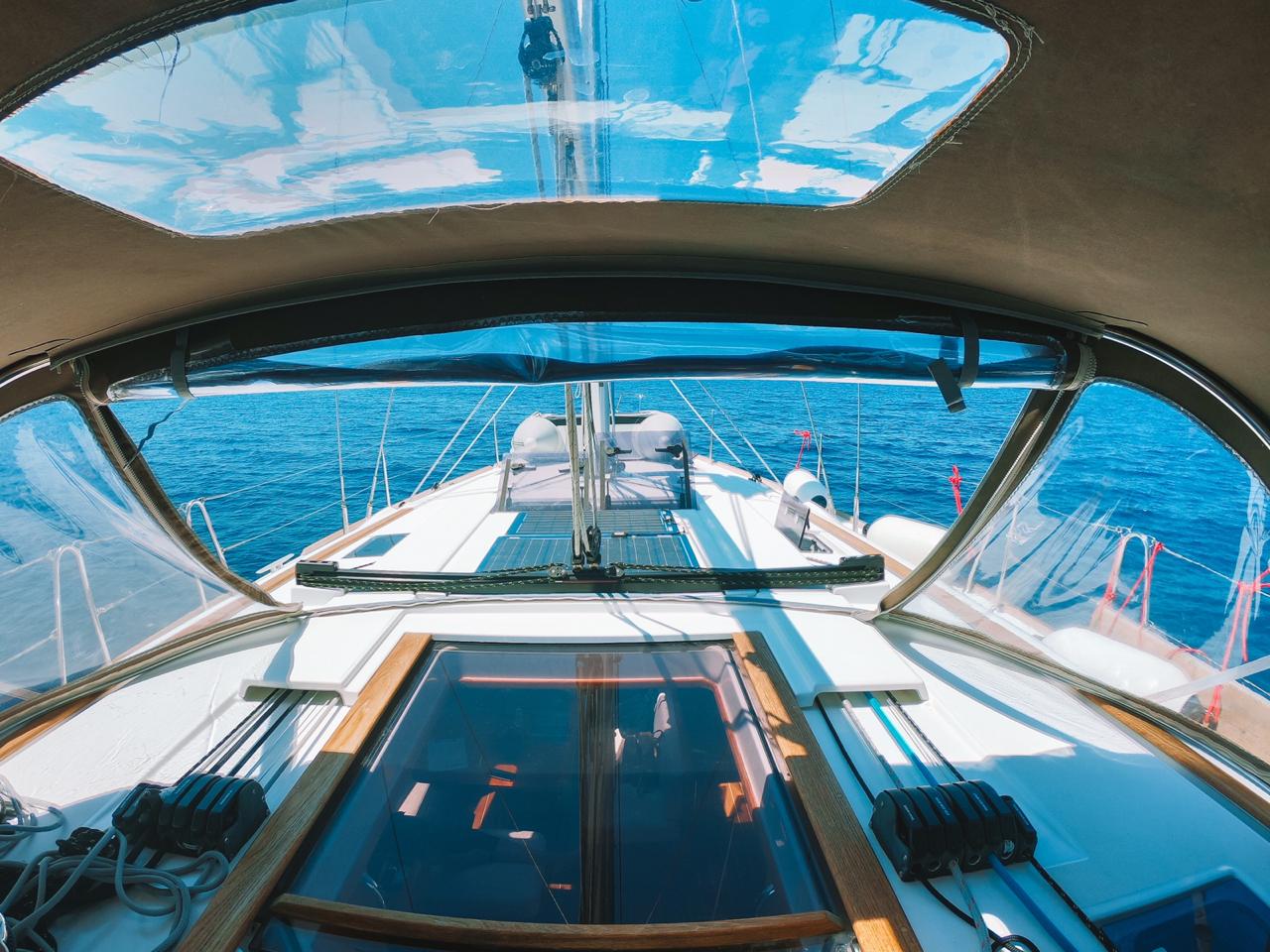
In the end, what it all comes down to is preference. In terms of performance, price, and comfort, catamarans and monohulls both have a lot going for them. You just need to decide what kind of holiday vibe you’re looking for, and Yacht4Less can help you with the rest!
At Yacht4Less we recommend fully crewed catamaran charters if you’re looking for top-of-the-line luxury and a super relaxing holiday where you don’t have to lift a finger. These boats will offer the space and comfort you’d expect from a 5-star hotel.
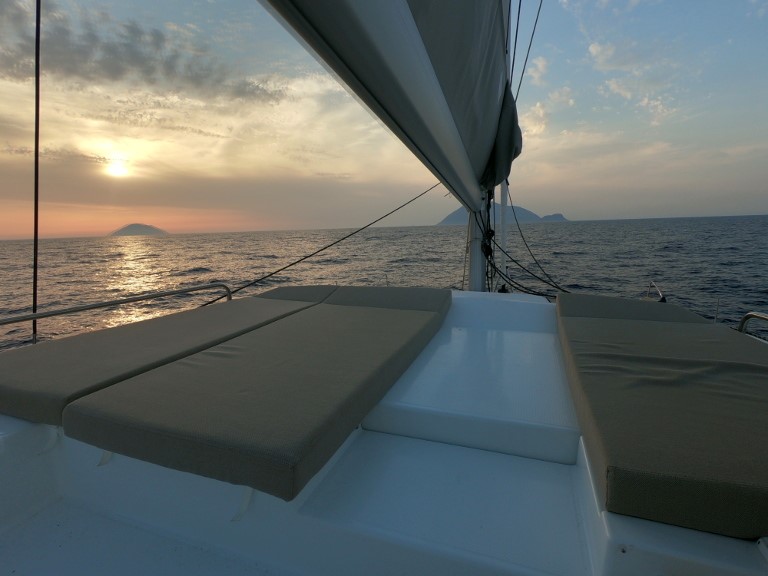
If you’re looking for a hands-on sailing adventure holiday, you might want to do a skippered charter with a monohull.. Your captain can show the ropes and help you learn how to sail. Or if you’re already an experienced sailor, go for a bareboat monohull charter . The exhilarating feeling of sailing a monohull is unmatched. It’s the classic romantic sailing experience, and makes for a thrilling holiday.
For those looking for a sailing experience somewhere in between extravagant luxury and exciting escapades, Yacht4Less is here to help you find the perfect boat for your needs. More sailing holiday dilemmas? We got you covered! Sailing Holidays vs. Land-Based Holidays » Party Sailing vs. Natural Wonders »
Get a free & non-binding quote

Catamaran vs. Monohull: We Changed, Should You?
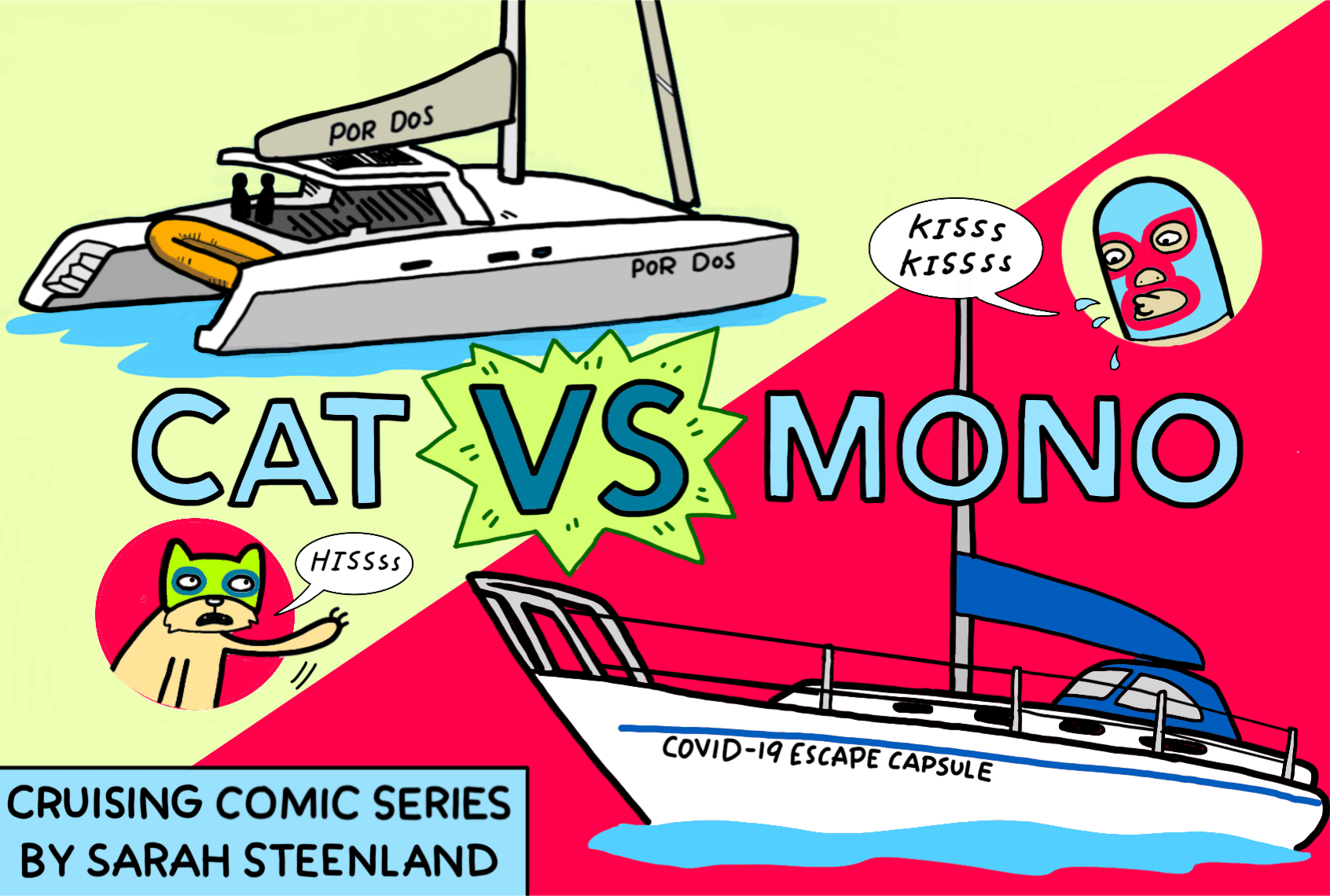
There are two schools of thought when it comes to monohull versus catamaran. We have done extensive cruising and lived aboard two monohulls and four catamarans over the past 25+ years . We experienced the good and the bad for both single hull and multihulls first hand. Quite honestly, the pluses for catamarans far outweigh the minuses. There are multiple benefits of catamarans. They are faster, more stable and spacious, and have shallower drafts allowing safer anchorage closer to shore. Being on a stable platform with no heeling cuts down on crew fatigue and seasickness leaving the crew more alert and in control of the vessel. Even novice sailors feel more confident on catamarans.
When we built our monohull Royal Salute in the early 90s, catamarans were not established and were looked upon with extreme suspicion by most cruisers, including ourselves. “Safety and the capsize” issue were always the first things to come up against sailing catamarans. It is a fact that monohulls can get rolled in heavy seas but will right themselves because of the heavy lead keel, and while crew and vessel will be battered, the roll is survivable.
However a catamaran once capsized, will remain upside down (jokingly referring to this state of the catamaran as “reaching its most stable position when upside down”). The inability of a catamaran to self-right was and still is a major bone of contention. However, what is not often discussed is that a monohull has about a 5,000 pound keel of lead that is constantly trying to drag the boat to the bottom of the ocean versus a catamaran that has no ballast and is in most cases with modern catamarans, unsinkable.
So the options are to either sail the world on a boat that, if it springs a leak, will sink like a stone or a vessel that cannot self-right in the event of a capsize but will not sink no matter what. So from a practical point of view, here are our observations over the last 25+ years of living aboard, on the advantages and disadvantages of a catamaran.
ADVANTAGES OF A CATAMARAN
1. speed equals safety.
The speed of a catamaran makes it possible to outrun bad weather. While catamarans do not point as high into the wind as a monohull (or if it does, it makes more leeway or slides sideways), it is about 20% faster than a monohull. This means that even if you sail upwind at a slightly wider angle to the wind than a monohull and have to cover more distance, you will still arrive at your destination long before a monohull.
A modern performance catamaran with daggerboards and good quality sails will point as high as a similar sized monohull. It will point the same as a comparable monohull and sail much faster and therefore arrive at an upwind position much sooner than a the monohull. It is important to note that most of the production catamarans on the market are under-powered and are equipped with standard smaller sails. In lighter breezes many of these designs perform poorly unless fitted with bigger headsails, a Code Zero and a square-top mainsail.
While we believe that more comfortable and safer in rough weather , we have to concede that when the weather gets really bad (60 knots of wind or more) we would personally prefer to be on a monohull from the standpoint of surviving. I would say that a monohull is preferable for serious offshore single-handed sailing because you can more easily hove-to in a monohull. We have been in some extreme weather on a number of catamarans and never really felt that we were in danger, although it takes some nifty seamanship.
A monohull could capsize in extreme weather or even roll in a storm, but they generally come back upright. A catamaran on the other hand, will not right itself. But the cat will generally stay afloat, offering a good place to survive while you wait out the storm or until help comes along. Well-designed modern catamarans are very hard to capsize though.
Having said all that, most catamarans can do 200 to 250 miles a day and with modern technology allowing one to pull down weather at will, there is no good reason why you should get caught in extreme weather. A faster boat is a safer boat as it will in many cases be able to outrun bad weather. With good weather routing information a catamaran can avoid most serious weather and, at worst, place itself in the most favorable position to avoid the brunt of a storm.
2. A Catamaran is a Stable, Safe Platform Underway
Catamarans have no ballast in the keels like monohulls do and therefor it relies on beam and buoyancy for stability. Typically cruising catamarans will have a beam to length ratio of roughly 50%, although many designs nowadays exceed the 50% rule of thumb. So, a 45-ft long catamaran will be about 22-ft wide, providing a very stable platform when sailing. Unlike catamarans, monohulls cannot overcome the rolling and pitching with their narrow beam and the lead ballast for stability.
This rolling and pitching makes the deck on a monohull very unsafe whereas on walking around on the deck of a catamaran while underway is far easier since the boat is much more stable, and it doesn’t heel. This makes sail changes and reefing much easier and a lot safer for the crew. Without the rolling and pitching motion, the danger of falling overboard on a catamaran is considerably less than on a monohull.
3. Crew Fatigue Reduces on a Catamaran
Because a catamaran does not heel over like a monohull, it offers far more comfort underway because the motion is mostly fore and aft pitching and very little beam-to-beam rolling. On all points of sail, a catamaran tracks upright and significantly reduces crew fatigue and seasickness. Seasickness is usually caused by things like anxiety, fatigue, hunger and cold, which all add to a sense of disorientation. This leads the crew to making bad decisions and seamanship errors that could be fatal to the crew and vessel. The more stable platform of the catamaran will hugely keep those issues at bay, making the crew more alert and energized.
Every action and chore including cooking is much easier on a catamaran when underway. It is much more pleasant to be on the deck level looking out rather than being stuck “down below.” It is also much nicer to sleep on a boat that doesn’t heel. I remember nights at sea in our monohull when I was rolling around in my bunk unless I was properly wedge in a little corner. That is simply not the case on catamarans.
All these factors ensure that your crew will not expend unnecessary energy to simply try and stay upright, onboard and safe on a long passage. Your crew on a catamaran will be well rested and alert and will be able to function well if a stressful situation arises.
4. Comfort at Anchor
Catamarans provide a wide platform and therefore offer lovely spaces to relax at anchor without the rolling motion that monohulls have a tendency to do in a swell. During our 15 years of cruising on a monohull, we have often had to leave anchorages that we really were not finished exploring because of a rolly, uncomfortable anchorage. Big rollers or swells coming into an anchorage can make conditions in an anchorage very uncomfortable and unsafe.
We were anchored off Funchal on the island of Madeira in our monohull Royal Salute once, when we were forced to leave our anchorage. The rolling became so bad, we were rolling from gunnel to gunnel. The anchorage became untenable to remain anchored, forcing us to go out to sea in foul weather in the middle of the night. This is an extreme case but believe me, we have left many an idyllic anchorage because of a rolling swell into the anchorage. Catamarans, on the other hand, do not roll from like monohulls have a tendency to do and are far more comfortable at anchor.

5. Anchor Bridal Setup

Catamarans are fitted with a bridle, attached to both bows and down to the anchor chain, resulting in a very stable position at anchor. What we found with our monohull was that because the bow acts as a sail (because of the high freeboard), the boat tended to sail at anchor in high winds. It sailed in one direction until the chain snatched and tacked over and sailed in the other direction, feeling like it might dislodge the anchor altogether. The catamaran on the other hand sits at anchor a lot more stable and doesn’t sail around as much.
6. Ease of Boarding on a Catamaran
Thank goodness we were much younger and more agile during our monohull days. Royal Salute and most monohulls of her generation or older, have high free-boards, making it quite a feat to get onto the boat from the dinghy. It was one of the most challenging things to do because unlike the more modern monohulls that have a scoop at the back, we had to climb up on the side of the boat to get on and off. We, of course rigged steps, etc. but it was always a hassle compared to the ease of getting on and off a catamaran from a dingy or from the water.
7. Shallow Draft Equals Better Anchorages
Catamarans have significantly shallower drafts than monohulls, allowing for safer anchorages closer to shore. Most catamarans in the 40-ft to 50-ft range draw between 3-ft to 4.5-ft, so they can anchor in places that a monohulls can not even consider. In the shallow waters of the Bahamas for example, the catamarans have a big advantage. We often anchor our own catamaran just a few feet away from a beach. It definitely allows one to be able to explore areas where the water is shallow without the fear of running aground.
The shallow draft also allows for emergency repairs in shallow water and even doing the bottom job when the tide goes out as we have done in places like Mtwapa Creek in Kenya, East Africa. The catamaran easily rests on her keels on the sand without help making it a breeze to do the “annual haul out” even in remote locations.
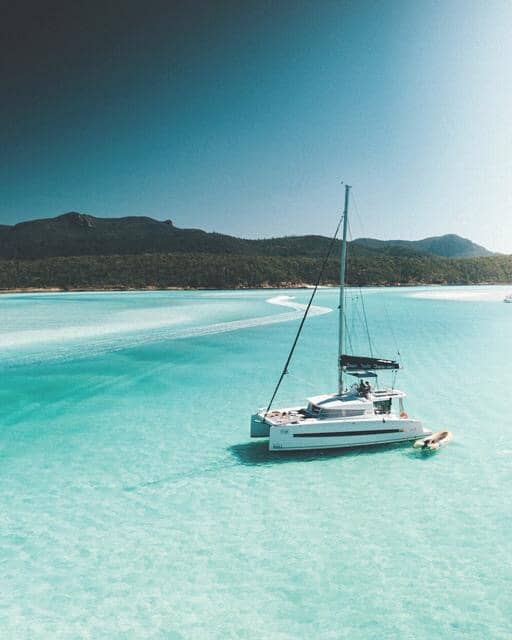
8. Dinghy Davits & Dinghy Size
All catamarans have a set of davits that make it very easy to raise and lower the dingy. Our monohull and most cruising monohulls do not have an efficient or easily accessible set of davits. This makes raising and lowering the dingy an elaborate production. Catamarans on the other hand, has davits systems easily accessible and some even have platforms to rest the dinghy on.
The lack of beam and difficulty of lifting the dinghy also limits the size and type of dingy that one can reasonably carry on a monohull. As we all know, the dingy is your transport to and from shore and diving or fishing spots, so the bigger and faster the dingy, the better off you are. A catamaran can carry both a heavier and bigger dinghy which makes the popular center consul dinghy so much more possible.
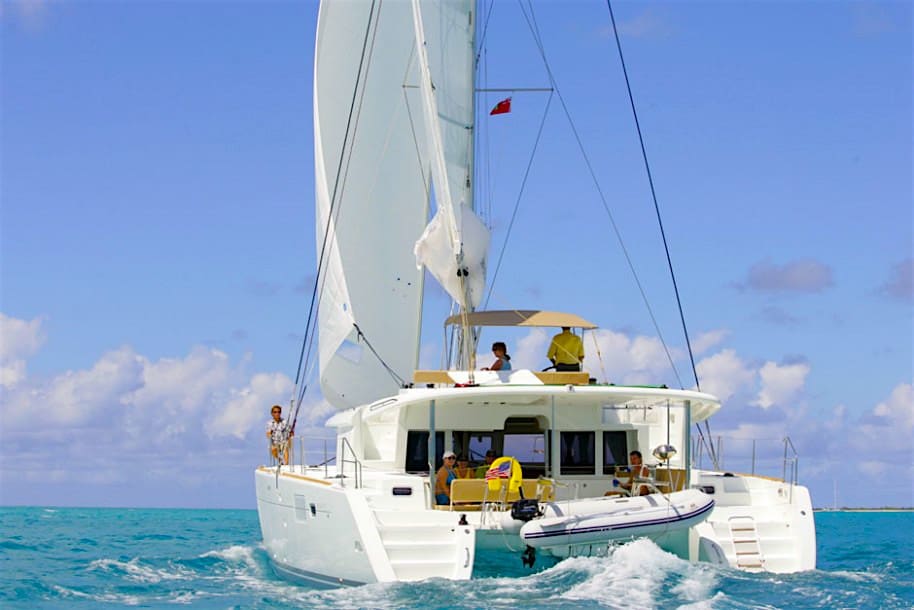
9. Interior Space and Comfort on a Catamaran
We sailed 32,000 NM on our 45-ft monohull, happy as clams, not realizing that sailing does not have to be done lying on your ear 24/7 while on passage or sitting knee-to-knee in the cockpit at anchor with your two other guests at the dinner table! One can liken sitting in a monohull cockpit to sitting in an empty Jacuzzi, you are always nice and close to the other folks.
Now that we are on our fourth catamaran, there are a few things that have become more evident to us than the incredible space and comfort of a catamaran, not only at anchor but also underway. The cockpit and living space in general are huge compared to a monohull, making for very comfortable and spacious living conditions. It feels more like you are at home, rather than just on a camping trip.
Knowing that one spends at least 90% of one’s cruising life at anchor, it’s important to have good open living space, which most modern cats nowadays offer. A lot of cats have walk around beds, lots of storage, every modern appliance including washer/dryer, etc. However, one has to fight the urge to fill the space if you want to keep the cat light and fast.
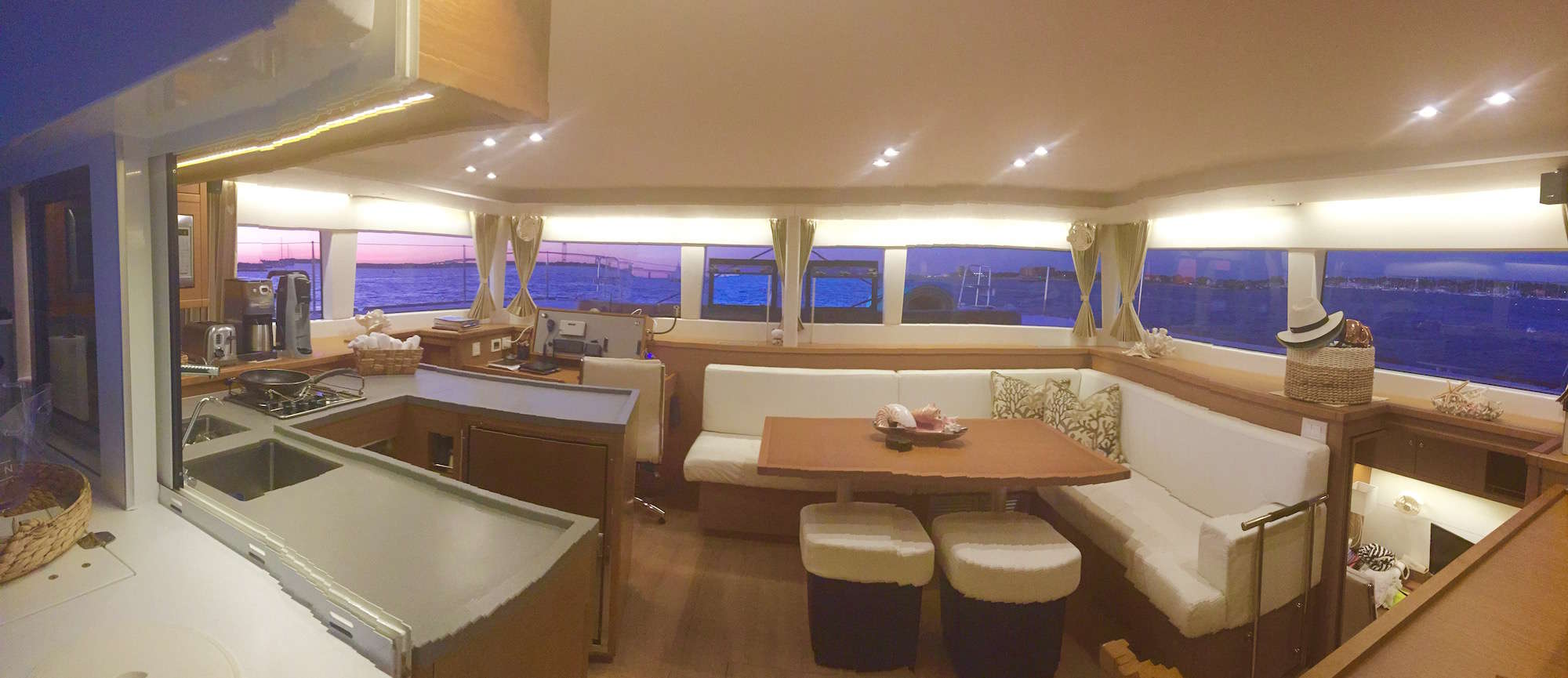
Sailing with guests onboard for extended periods of time, in close quarters can become claustrophobic but on a catamaran people are spread out and separated. With guests sleeping in one hull and the owners in another, catamarans offer much more privacy and separation. Some cats even have privacy doors that will close off the entire hull and has a separate entrance onto the deck, which really separates you from the guests completely.
There is very little heeling on a catamaran, so there is no need for hand grips and safety harnesses inside the boat. There is nothing better (and safer) than being able to walk from the cockpit into the living room (saloon) on one level or one step down at most. In a monohull, when heeling at a severe angle, you would have to claw your way from the companionway steps down to the living area, while fighting to stay upright, significantly tapping your energy.
Unless you hit extreme conditions, everything stays put on a catamaran reducing the anxiety before doing passages of having to stow and secure everything. This very issue makes a lot of cruisers reluctant to weigh anchor and explore more often. It is just too much effort to pack away all your stuff once comfortable in an anchorage!
One thing you will notice is that the stove on catamarans are not gimbaled like it is on monohulls and this should tell the story in itself. The stability and comfort on a catamaran is far superior. Cooking is easy and safer. I often open a nice cold beer, put it down to do something and forget about it only to find a warm beer later in the same place I left it. This is not something that happens on a monohull.
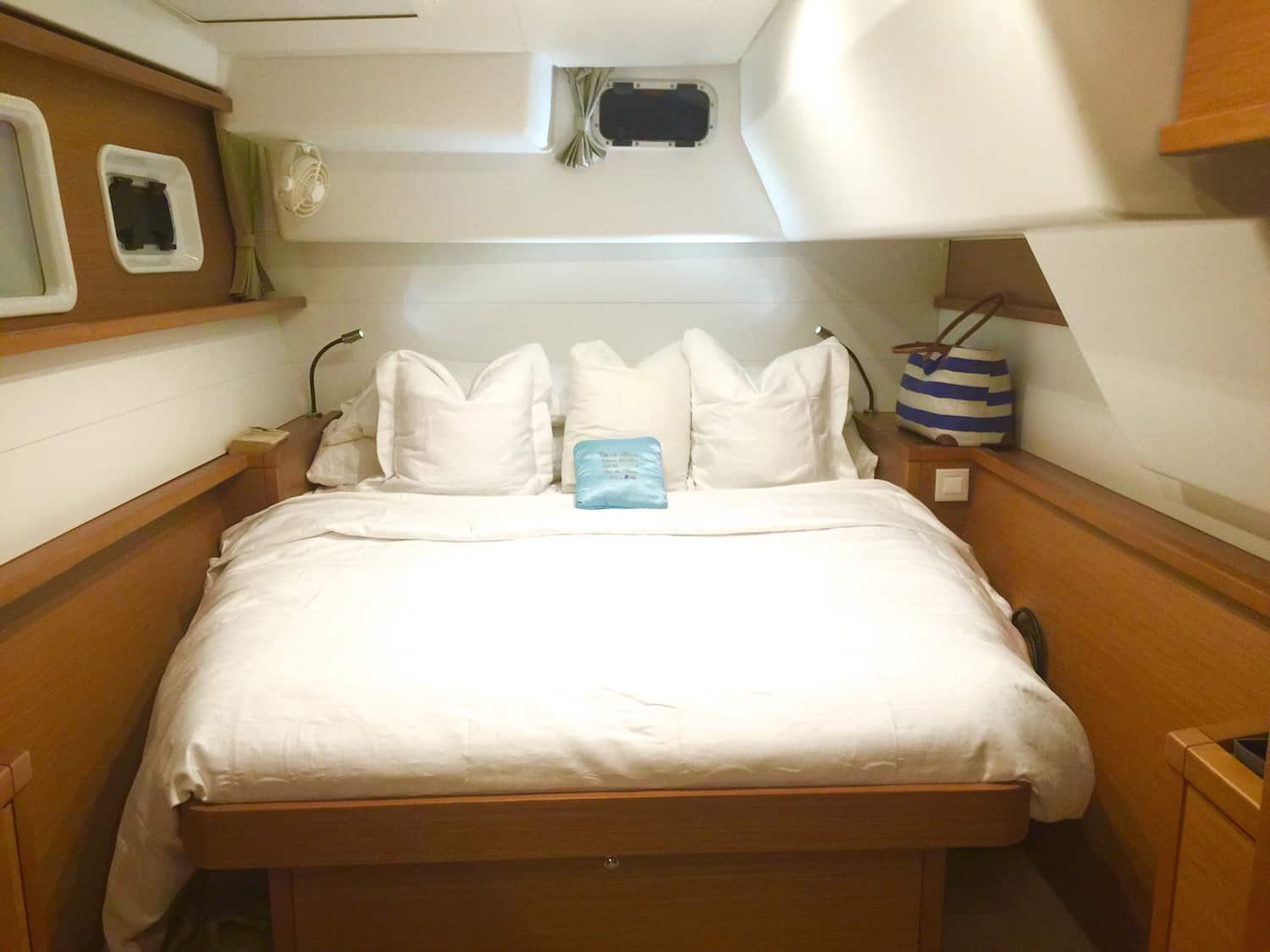
10. Redundancy on a Catamaran
Unlike monohulls, catamarans have a lot of critical redundancies. That of course means two hulls to clean and anti-foul, double the engine maintenance, etc. but having two of the critical equipment like engines for instance, outweighs the downside.
With two engines, if one fails you still have adequate propulsion to go anywhere. If by some fluke the second engine also fails, you have a full set of spares to fix at least one of them. Our friends once hit a sleeping whale off Tanzania, and when it dove, it hit the prop, bending it. They limped into the narrow channel on the one engine but at least they could make it to a safe harbor where we surveyed and repaired their damage.
We often only use one engine when motoring while making passage in order to conserve our fuel. The one engine is totally capable of moving the boat along at a good speed unless you are in heavy seas and you may need more power. Other than that we only use two engines to dock or maneuver the boat in close quarters.
Because there are two engines there are also two independent charging systems via the alternator on each engine. If one alternator goes out, there is still another complete charging system. There are two rudders and if one fails or falls off (as has happened to our friends on a monohull off Columbia, where they almost lost their boat) you have a second rudder that is completely capable of steering the boat by itself indefinitely. That holds true for several things on a catamaran!
11. Maneuverability
The engines are spaced far apart on a catamaran and it makes maneuvering much easier and more precise than monohulls, unless the monohull has a bow thruster. We did not have a bow thruster (not many monohulls do) and had to rely on prop-walk and using prop wash on the rudder. A modern catamaran can do a 360 turn on her own axis. A monohull cannot do this and have a bigger turning circle. However, a monohull under sail is much more maneuverable and certainly will tack a lot faster than a catamaran. The ease in maneuverability under engine on a catamaran in close quarters specifically, is vastly superior comparatively.
12. Rigging
Because of the beam on a catamaran the spinnaker pole has become unnecessary equipment. Hallelujah, I say. That pole on our monohull was a pain the behind and I always hated having to use it. On a catamaran, one can fly an asymmetrical cruising chute or spinnaker, using the bows to tack the clew or run a guy through a block so it is very much simplified, easier and safer.We also sail wing-on-wing with twin headsails when we sail downwind. We use our furling jib and furling Code Zero. It is as easy as one, two, three.
DISADVANTAGES OF A CATAMARAN
1. bridgedeck slamming.
One advantage most monohulls do have when underway is that they don’t slam. Catamarans with a low bridgedeck clearance can experience significant slamming in confused seas sailing upwind. This slamming can be quite disconcerting when you first experience it as we did on a Shuttleworth 44 design, our first ever catamaran experience, 20+ years ago. At times, it felt as though the boat was falling apart. Of course the boat was fine but nevertheless, the stress on the crew from the constant noise and discomfort was significant.
Monohulls don’t have a bridgedeck which means no slamming and are therefore a bit more comfortable than l ow bridgedeck catamarans when beating into severe confused conditions or “washing machine” conditions as we call it. Modern catamarans mostly have better bridgedeck clearance and the slamming is significantly less. However, not all cats have a good clear tunnel under the bridgedeck. Some manufacturers build beds into the bridge deck in order to make more space in the chest of the catamaran where the slamming occurs. These protuberances into the bridgedeck tunnel will likely increase slamming. So be mindful of that when selecting a catamaran. We currently own a Bali 5.4 and the bridgedeck clearance on this boat is more than adequate and the tunnel is clear. We therefor experience very little slamming compared to our Prout 45 that we previously owned (picture of sister ship below) with a much lower bridgedeck.
We Explain Bridgedeck Clearance
In the pictures below, the Bali 5.4 has very good clearance from the water to the bridgedeck and has a nice clean tunnel versus the very low bridgedeck of the Sunreef 50.
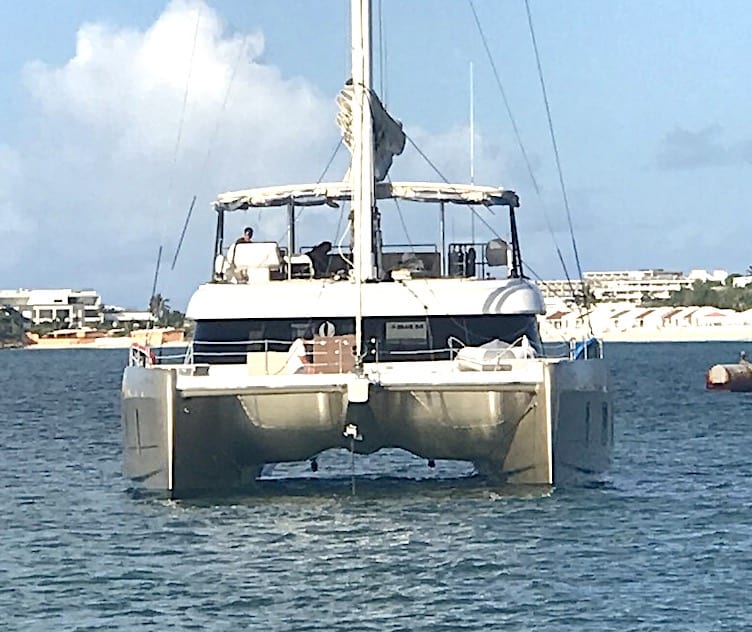
2. Sailing Downwind
Monohull spreaders are set at 90 degrees to the mast whereas a catamaran has to have backswept spreaders. The reason is that, on a monohull, there is a backstay and using this, plus the intermediates you can get a nice pre-bend in the mast (the pre-bend is to flatten out the main sail and allow for better performance).
On a catamaran with no back stay, you need to use the back swept spreaders and the diamonds to pre-bend the mast. The reason I point this out is because on a catamaran, if you want to broad reach or run, the mainsail cannot be let out all the way because the backswept spreader tips could punch holes in the fabric.
On a monohull, the spreaders are at 90 degrees so you can let the main and the boom out much further which is, of course, much more effective. This is one of the reasons it is better to broad reach and tack downwind on a catamaran.
Whether a monohull or multihull, sailing dead downwind doesn’t usually make great VMG. Therefor a regular cruising cat, much like a monohull, needs a lot of sail area and has to sail deep downwind if it is to achieve a decent speed made good (VMG). This video demonstrates how we achieve this by sailing wing-on-wing downwind.
It is more difficult to find a dock either as a transient or a permanent slip for a catamaran in general because of the wide beam. But this is changing fast and will soon not be too much of an issue. In the USA dockage is charged by the length of the boat in feet, so there is no disadvantage there but, in some places, (the Mediterranean for example), dockage is charged at length times one and a half because of the additional beam.
Since the catamaran is stable at anchor, we mostly anchor out. We have more privacy, a better breeze and usually a stunning view.We have a nice dinghy with a good outboard engine and is big and comfortable enough to get to shore fast and together with the modern conveniences like the generator, watermaker and washer/dryer, docking becomes a non-issue.
It is definitely more difficult to find a travel lift with enough beam for a catamaran for a haulout, while, for a monohull, there are absolutely no problems anywhere. The wide beam of cats also greatly limits the number of shipyards that can haul them out. Most catamarans over 40-ft must be hauled out with a 50-ton travel lift. This not only increases the cost of the haulout, but greatly limits the choice of the shipyards for repairs and maintenance. With limited choice, prices are high for shipyard services.
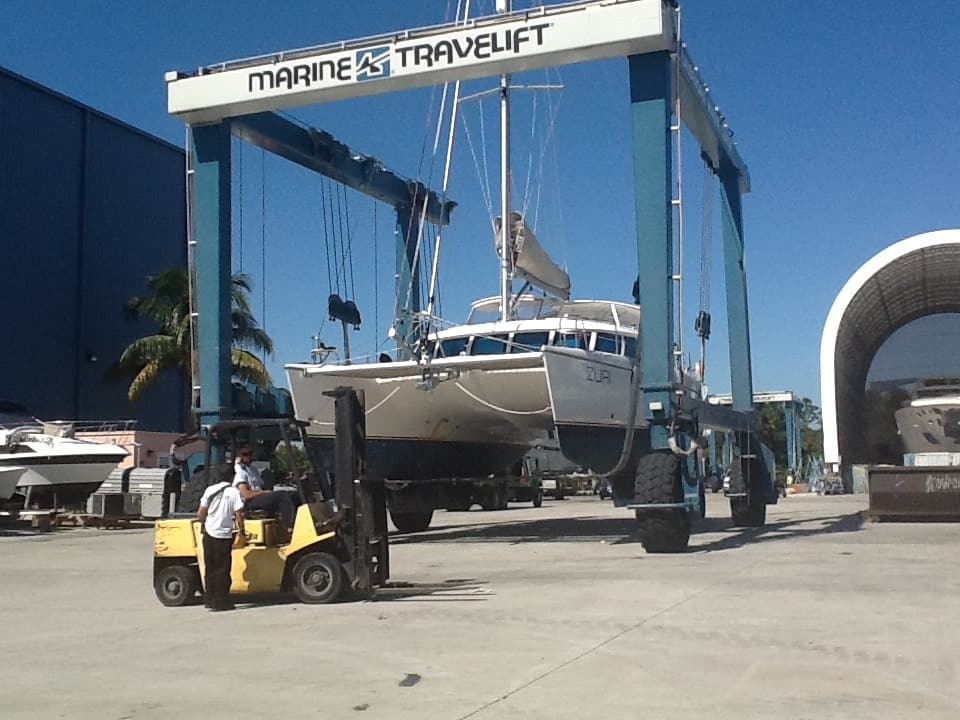
Catamarans do tend to have a lot more windage than monohulls. This can be an issue especially when maneuvering in close quarters with a strong wind. But I have found that, provided the engines are powerful enough for the size of catamaran, that twin engines negate this problem. Also, many modern large catamarans now have a bow thruster fitted. It is super easy to dock.
The cost of getting into a catamaran is much higher than that of monohulls. That could put a serious dent in your cruising kitty or require you to put your dream on hold a little longer. Pre-owned monohulls on the other hand are very cheap to buy comparatively, because the supply presently far outweighs the demand.
Catamarans are in high demand and they typically hold their value much better and longer and the trend is now heavily in favor of the catamaran market. When prospective buyers contact us for catamarans under $250,000 the choices are very limited and catamarans under $100,000 is near impossible to buy. In this case, your best bet is to go with a monohull unless you go with much older boats like the Prouts or the less expensive Geminis.
Our Own Catamarans & Monohulls
FYI: Royal Salute , a Bruce Roberts 45 monohull, was the first boat we owned and sailed approx. 30,000NM on. Mythral, a Seafarer 30, was our “toy boat” while we were waiting for our catamaran to be built. Even though this classic little monohull sailed around the world, it didn’t have much in modern conveniences like running water. Siyaya was an Island Spirit 40 catamaran that we sailed from Cape Town to Florida on and then taught live-aboard sailing classes for several years. Zuri I was a Prout 45, a beautifully crafted catamaran but by today’s standards is considered old technology. Our Lagoon 450 SporTop ( Zuri II ) is a fantastic live-aboard catamaran. We lived and taught aboard her for three years but sold her last year and we currently own a Bali 5.4 ( Zuri III or Z3 as we call her now). Read about our various boats .

CONCLUSION: CATAMARAN vs MONOHULL
We were dyed in the wool monohull sailors for 15+ years. We loved the pretty lines of monohulls, the sailing ability and what we believed at the time to be much safer vessels. However, now that we have been avid catamaran enthusiasts, we simply can never go back to monohulls. Catamarans have come of age and with modern technology have overcome most objections that sailors of old had against them. They are well designed and built, are safe, and we simply love that they sail fast and upright. There is not a whole lot to dislike about a catamaran when you live aboard. We have weighed all the pros and cons of catamarans and found that the pros far exceed the cons. We made the change to a catamaran and do not regret it one bit!
We hope that this article will clear things up for all the prospective catamaran owners out there.
Contact us if you have any questions regarding catamarans, Fractional Yacht Ownership or our Charter Management Programs .
Estelle Cockcroft
Join our community.
Get the latest on catamaran news, sailing events, buying and selling tips, community happenings, webinars & seminars, and much more!
4 thoughts on “Catamaran vs. Monohull: We Changed, Should You?”
I read that the engineering on the catamarans were improved over the years. Whats the oldest year would you recommend designwise?
Scott, my apologies for the late reply. We’ve been traveling in Africa. Anyway, catamarans have come a long way and improvements in technology is happening at lightning speed. I reckon that even the older model catamarans are good. It depends on what your needs are. If you want something a little better performance wise, I would go for something no older than 15 years.
After buying a catamaran what is the difference in expense of a catamaran vs a monohull. Many articles state that not only the initial cost of a catamaran is more it the operating cost as well.
Hi Todd, it is more expensive. The annual dockage and haul out as well as maintenance will be more expensive. You obviously have two engines to maintain and various other pieces of equipment to service in both hulls. While there is more equipment there is also more redundancy and of course you have the comfort factor. So, depending on your situation, it’s probably worth it.
Leave a Comment Cancel Reply
Your email address will not be published. Required fields are marked *
Save my name, email, and website in this browser for the next time I comment.
Recent Posts

First-Annual Virgin Islands Boating Exhibition (VIBE)
VIBE – It’s a Destination Boat Show! Join us May 10 – 12 at
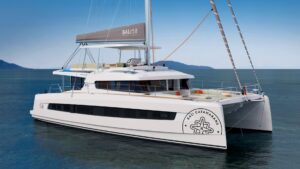
BALI Catamarans Unveils The New Bali 5.8 Flagship
CATANA GROUP launches its 14th BALI CATAMARAN model, the BALI 5.8, for the brand’s
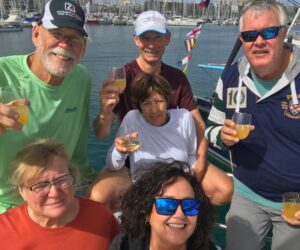
Love Stories At Sea…because it’s valentine’s day
Because it’s Valentine’s day, we wanted to celebrate all the couples that we helped
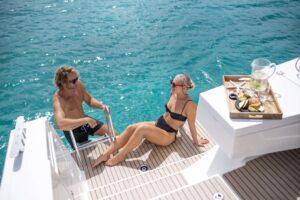
Your Go-To Resource for all your Catamaran Needs!
Check out our brochure to learn about all we have to offer and why

For more than 30 years, we have been a part of the catamaran community and created Catamaran Guru™ to encourage and educate all the aspiring sailing out there. We understand the dream of traveling the world by catamaran and created a one-stop-shop to make that dream a reality for you.

- Stephen & Estelle
- Testimonials
Get Started
- Yacht Sales
- Used Yachts
- Charter Management
- Boat as Business Programs
- Seminars & Events
- Marine Supplies
- Maintenance & Boating Guides
Catamaran vs Monohull: Pros, Cons & Main Differences
By: B.J. Porter Editor

The choice of catamaran vs monohull ultimately comes down to preference. What’s critical for one buyer may mean little to another. If your partner refuses to set foot on a boat which heels, that’s a deal-breaker for a monohull. But if you’re passionate about classic looks and styling, your quest for beauty may override other considerations and rule out catamarans.
We can’t tell you whether a catamaran or a monohull is right for you. But we can help you with the pros and cons of each for your search.
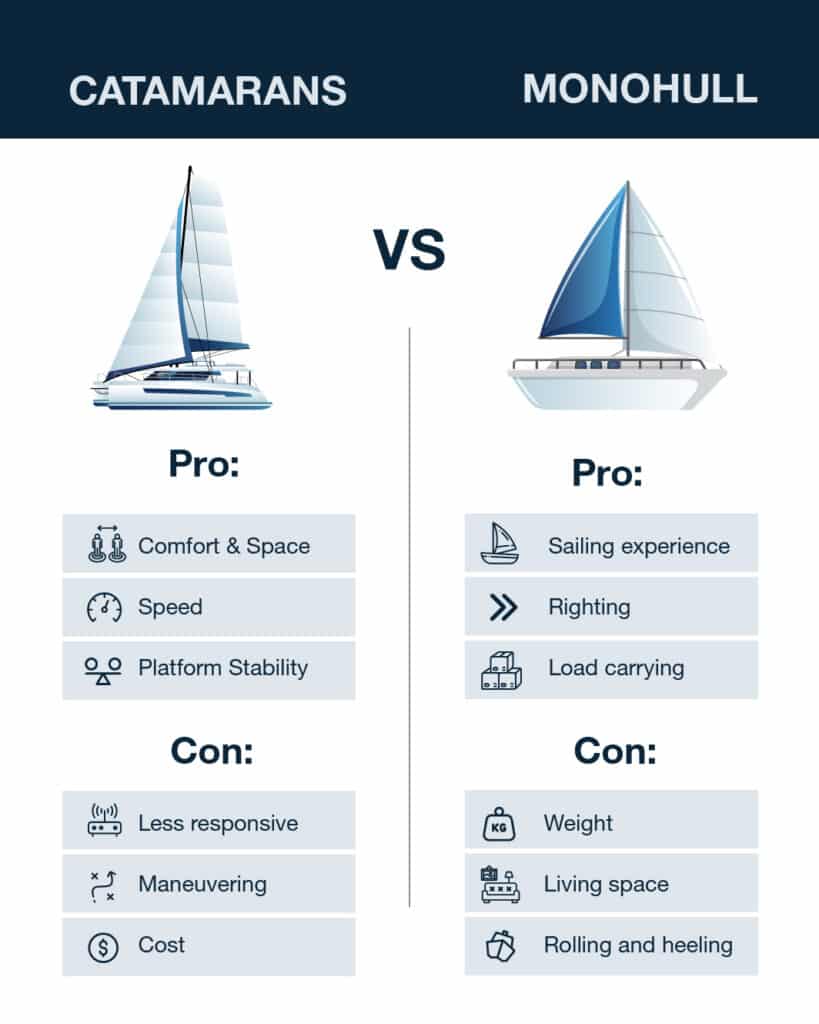
The Strengths and Pros
No matter your choice of monohull or catamaran, there are safe, comfortable, and excellent sailing boats of both types. Neither has an exclusive lock on any strength, and both sail safely and comfortably. But there’s a different emphasis on how they do it. No matter what you are trying to do – sail fast, cruise the world, or just host a crowd at the dock, there are monohulls and catamarans that can work for any requirement.
Catamaran advantages
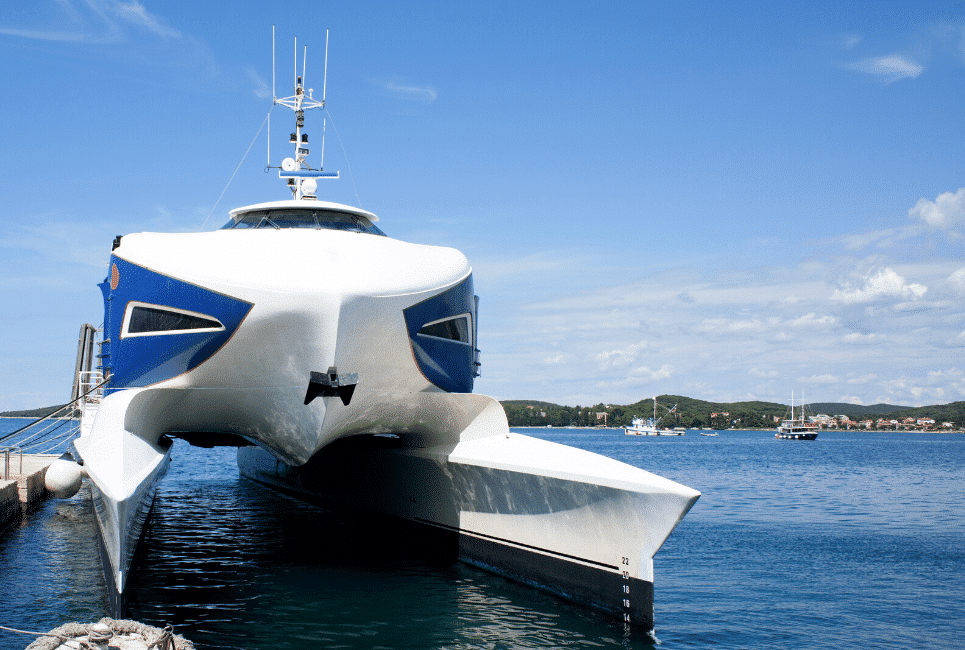
Space and comfort: Two hulls and a wide beam make a very stable platform with lots of volume in the saloon and cockpit. Most living space is above the waterline, with wonderful light and airflow. Cabins in the hulls offer better privacy and isolation, usually with standing headroom.
Straight line speed: Most catamarans are faster in straight-line sailing speed (1) that similar sized or even longer monohulls. Without a lead keel, they’re lighter, so more driving force from the sails converts to speed, and narrower hull forms may have less drag than wide hulls with deep keels. Some heavier cruising catamarans may not be faster, especially if they keep rig size small for ease of handling.
Stability : The beam of two hulls with a bridge deck leads to much higher stability and resistance to roll (2). Waves in an anchorage that induce violent roll in a monohull may make a catamaran bounce or bob. Under sail, catamarans do not heel appreciably even when powered up.
Twin engines. : With one engine in forward and balanced in reverse, most catamarans can spin in a circle in place and make sharp adjustments to the boat’s direction. If you have an engine failure, you also have a second engine, giving a safety edge when you can’t sail.
Monohull advantages

Upwind sailing performance: While catamarans have the edge at straight-line speed, monohulls sail closer to the wind. When you’re racing or you have to sail upwind to get to the next island, this can get you there faster.
Sailing feel and responsiveness : The “feel” of sailing a monohull is much better. With a single hull, you’ll feel wind pressure and trim adjustments immediately for a more responsive helm and a better ability to sail to the wind.
Maneuvering under sail: Monohulls are quite nimble tacking and turning under sail, and there’s less risk of slow or missed tacks.
Righting Moment: The primary offshore safety argument for monohulls is their ability to right when capsized. The heavy keel keeps the boat deck up when sailing, and most monohulls will come back upright even after a complete capsize.
Cargo and Loading: A higher displacement boat with thousands of pounds of lead hung from the bottom isn’t going to be as affected by loading as a relatively light multihull.
Aesthetics: This is subjective, as many catamaran enthusiasts love how they look. Classic sailboat styling, with swept sleek looks, springy sheer lines, and all the “right” proportions are more common on monohulls.
Also read: The 5 Best Electric Anchor Winches
Weaknesses and Cons
Like strengths, weaknesses are relative; just because one class has a strength doesn’t mean the other doesn’t. There are spacious monohulls and beautiful catamarans, just like there are cramped catamarans and unattractive monohulls. The differences have to be highlighted relative to each other, and the weaknesses of one are most apparent compared to the strengths of the other.
Catamaran Cons
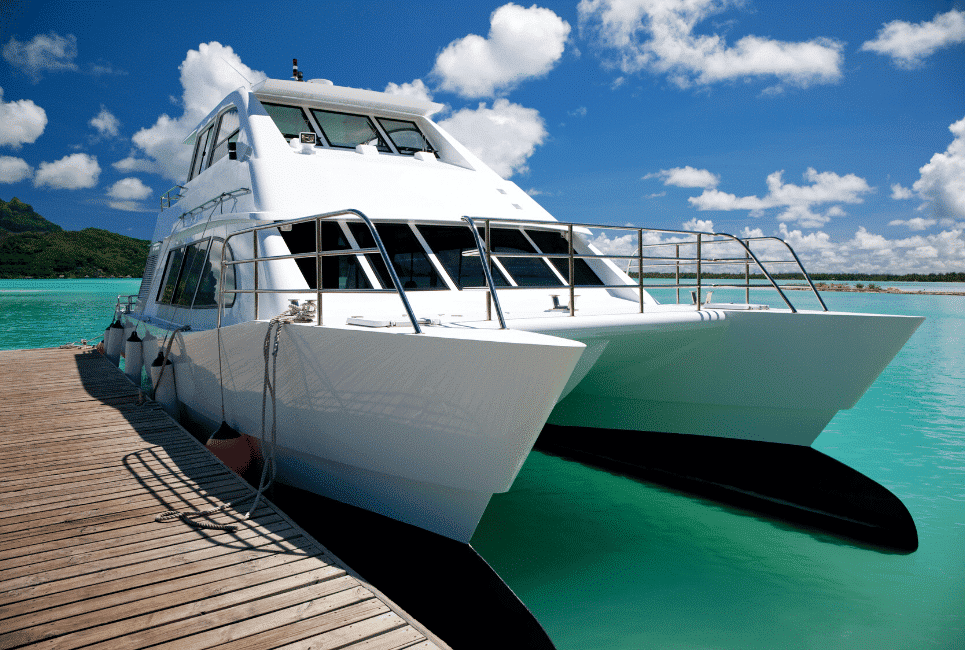
Upwind performance: Cats don’t sail as close to the wind, but they make up for it by sailing faster off the wind. You’ll sail a less direct course upwind. Even if you get in at the same time, you’ll have to sail farther.
Less responsive sailing: Two hulls with two rudders and a very broad platform reduce the helm feel when sailing, cutting responsiveness sailing in shifting wind and wave conditions. It also makes tacking slower.
No-flip zone: It is very difficult, but not impossible, to flip a large catamaran (3). But if a catamaran capsizes, it will not flip back over by itself.
Large in marina/close quarters: You have two problems in marinas. Beamy cats are tough to maneuver in tight spaces because they’re big and visibility is tough over the hulls. And many marinas charge extra because the wide beam extends into the next slip. The good news is that twin engines make tight maneuvering easier.
Price point: Catamarans are more difficult to build and need more materials. This is directly reflected in the cost of the boats.
Monohull Cons
They are heavier: Every large monohull needs a keel for stability (4). They can not sail or stay upright without thousands of pounds of ballast, and this makes them heavier and slows them down. Tiny monohulls can use a centerboard or daggerboard for stability, but most boats big enough to sleep on need ballast.
Darker interiors : Most monohull living space is lower in the boat, where you can’t put enormous windows for light and circulation. It’s very hard to get space as bright and airy as catamaran saloons.
Less living space: With one hull and no bridge deck saloon, most monohulls feel cramped compared to spacious catamarans.
More prone to rolling motions : Only one hull makes monohulls susceptible to rolling in waves, and the movement can be quite uncomfortable.
Heeling: Tipping is just part of sailing monohulls upwind and is unavoidable. It can be reduced on some other points of sail, but not eliminated. Many people, especially non-sailors and new sailors, find this movement uncomfortable or distressing.
You might also be interested in: How to Buff a Boat | A Detailed Guide by a Boating Expert

Troubleshooting Pontoon Boat Battery
Pontoon boats are a great way to enjoy the water and spend quality time with family and friends. But just like any other boat, they rely on a battery to power various systems, including navigation lights, trolling motors, and other…
Boat Accessories

Best Ice Fishing Fish Finders in 2023
In search of the best ice fishing fish finders in 2023? Not all fish finders are created equal, particularly when it comes to ice fishing. Specialized features are crucial to ensure successful outings in harsh winter conditions. You require a…

Best Side Imaging Fish Finders in 2023
Navigating the world of angling equipment can be challenging. That's especially true when it comes to side imaging fish finders, given the extensive range of options available in 2023. This post makes it easy for you to narrow down your…

How to Choose a Fishfinder for Your Boat: A Comprehensive Guide
Today, we embark on a journey to unravel the secrets of choosing the perfect fish finder for your boat. As we navigate through an ocean of options, we'll explore different types of fish finders, delve into their key features, and…
Accessories
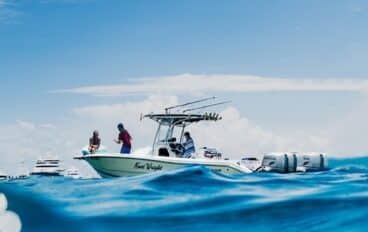
5 Best Portable Fish Finder in 2023
Looking for a portable fish finder for kayaking, ice fishing, or other activities? The good news is that there are a lot of solid products out there. The year 2023 has ushered in an array of advanced models, each brimming…
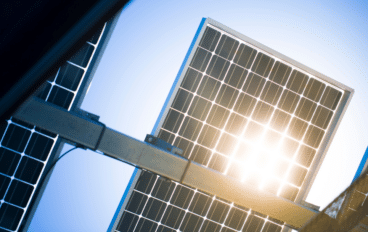
Charging Your Trolling Motor Battery with a Solar Panel
Charging your trolling motor battery with a solar panel is not just the right thing to do for the environment, it is extremely convenient. When you’re out on the boat, with any luck, you’ll have access to a good amount…
Don't miss out

Catamarans for Rough Seas: What Makes Them Great
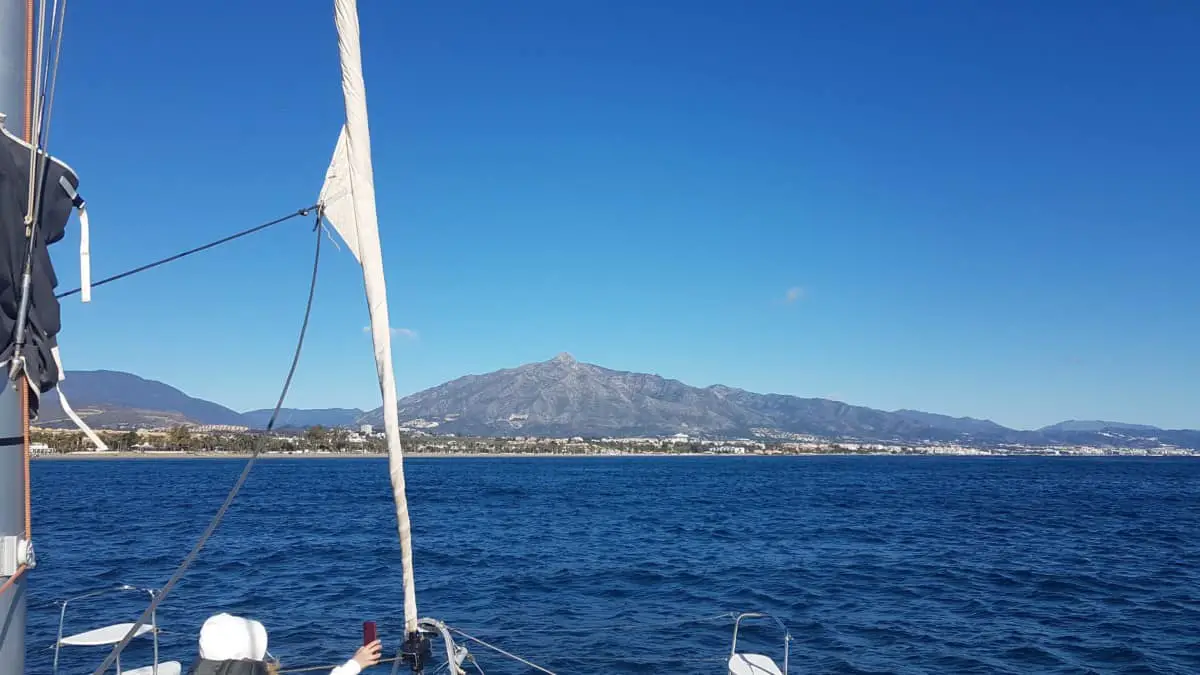
As an Amazon Associate, we earn from qualifying purchases. We may also earn commissions if you purchase products from other retailers after clicking on a link from our site.
Sailing a catamaran in rough seas is a whole different story from the comfortable, leisurely cruising with your friends and family. If your cat can’t take the pressure of high waves, things can get ugly fast. So, are catamarans good for rough seas, and which are the best ones?
Some of t he best catamarans for rough seas are Leopard 53, Magnum 46, Catana 53, Heliotrope 48, Lagoon 78, and 70 Sunreef. They all feature high performance to outrun heavy weather, have wide beams for added stability, low windage designs, and enough bridgedeck clearance to prevent pounding.
In this article, I’ll elaborate on the key features necessary for cats to handle rough seas and which ones are the best for taking on rough seas.
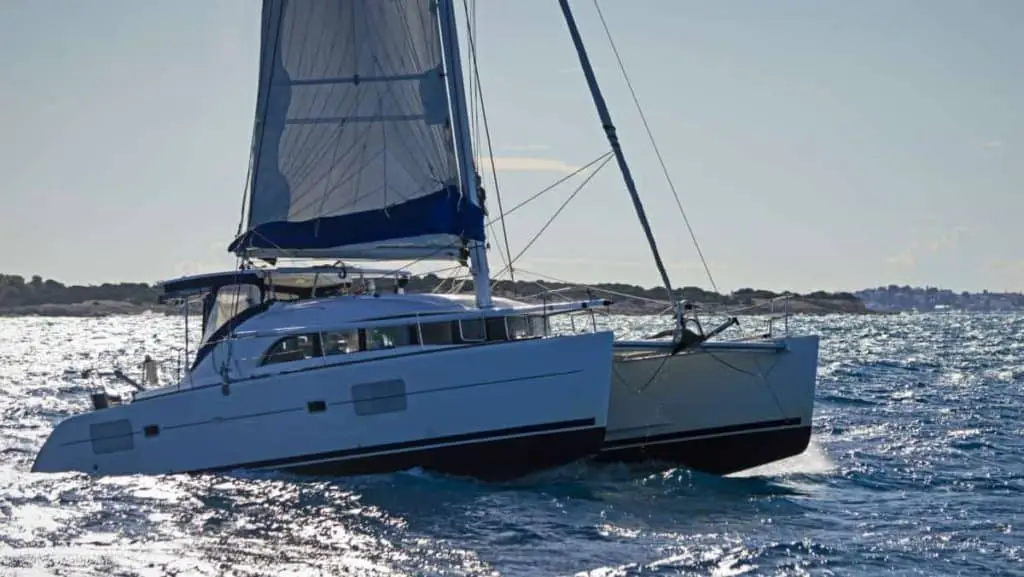
Table of Contents
A Common Myth Busted: Catamarans Aren’t Safe
There’s a myth among sailors (not cat sailors) that catamarans can’t handle rough seas because they’re designed for cruising or anchoring in shallow waters and will easily flip over. However, cats are, in many ways, safer than monohulls since they’re more stable, maneuverable, and faster due to having two hulls and two engines.
Plus, while both catamarans and monohulls can capsize, it’s easier for the latter to flip back over. However, multi-hulls are virtually unsinkable, making them safer in case of capsizing.
In addition, due to their high performance and lightweight, they’re faster than monohulls of the same length. This feature helps the sailor outrun any bad weather conditions and navigate the vessel to a safe place.
Features a Catamaran Needs to Handle Rough Seas
Not every cat is suitable to go to heavy seas, and before purchasing any boat, you should consider the necessary features that make it safe to use for offshore cruising, what specifications accommodate your cruising needs, and the price you’re spending.
Let’s take a look at the six critical features a catamaran needs to handle rough seas (blue water able) and how these features offer enhanced safety when sailing in unstable water conditions.
Daggerboards Help Prevent Sideways Slipping
A daggerboard is a retractable vertical keel put in the hull’s central part only seen in sailing boats. Since catamarans don’t have an adequate keel area, they need daggerboards to reduce leeward drift. The bigger the daggerboards are, the better the boat’s performance.
A boat without daggerboards has reduced pointing ability, more drag, less speed, and reduced safety. That’s why a daggerboard is one of the most crucial parts of a catamaran to sail to the wind.
Daggerboards boost the cat’s performance by preventing it from slipping to leeward and lifting the boat to windward. It works like an airplane wing, allowing you to operate the boat at higher upwind angles. This feature comes in handy in rough weather and high waves.
Deep Rudders For Better Offshore Steering Control
Rudders are parts of the boats in charge of steerage and directional stability. Since they’re essential for safe steerage, catamarans have twin rudders to provide more security and reduce the pressure on the helm (autopilot).
Because catamarans have a small draft, the rudders are sometimes more vulnerable to blows and impacts, especially in rough seas close to shore, where reefs and debris can be a problem. Longer, deeper rudders are more effective because they are stronger and more stable downwind.
Best Size Catamaran For Ocean Sailing and Rough Seas
The blue water catamaran’s length plays a major role in combating high winds. A longer cat can move easier, is more maneuverable, and naturally much heavier. Strong winds can toss about the boat easily, provided that its length is in a good proportion to other dimensions.
Most cat enthusiasts believe a minimum of 40 feet (12m) is optimal for a cat to survive in rough seas. As a general rule of thumb, the best length-width proportion is 45 to 22 feet (13.72 to 6.71 meters).
In addition to safety, a bigger boat will allow for more weight because it has more space, and you can arrange your gear in a more organized way. This also makes controlling them in emergencies much easier.
Enough Bridgedeck Clearance
Bridgedeck clearance refers to the space between the hulls. The bridgedeck height plays a crucial role in the cat’s ability to handle choppy seas in a comfortable and safe way. A high bridgedeck clearance gives waves enough headroom to flow between the hulls.
So, sailing in big waves causes slamming and pounding when there’s not enough bridgedeck clearance. The slamming can, in turn, lead to crew fatigue and loss of speed. Plus, it will lead to more wear and tear on the gear and equipment.
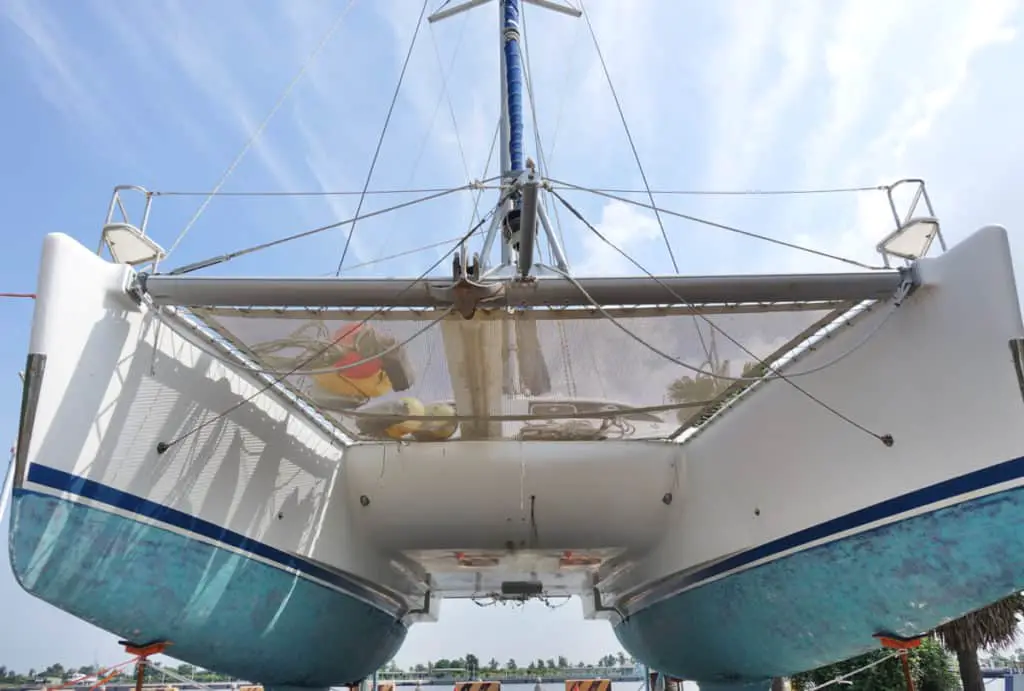
The bridgedeck clearance will be reduced when the boat is loaded heavy. So, the higher it is, the more freedom you have in loading your boat with gear, freshwater, and fuel (at least this is one aspect of the load-carrying capabilities). Although bridgedeck height is more of a comfort-related factor, the pounding under rough conditions can be stressful for both the boat and the crew.
The clearance should be between 5-6 percent of the catamaran’s LOA as a general rule of thumb. So, if the cat is 40ft (12m), the bridgedeck height should be around ~2ft (0.6m).
High Speed Get You to Safety Quicker
When at sea, you need to avoid dangerous conditions as much as possible. A high-speed catamaran helps you get out of the ugly situation faster. To avoid such bad conditions, you need to perform weather monitoring and smart routing.
A crucial factor that affects speed is displacement. Most modern cats have light displacement, leading to less hull drag and more speed.
Want to understand why catamarans are faster than monohulls I suggest you read two of my other articles:
- Why cats are so fast
- Catamaran hull speed calculator
- Why trimarans are faster than catamarans
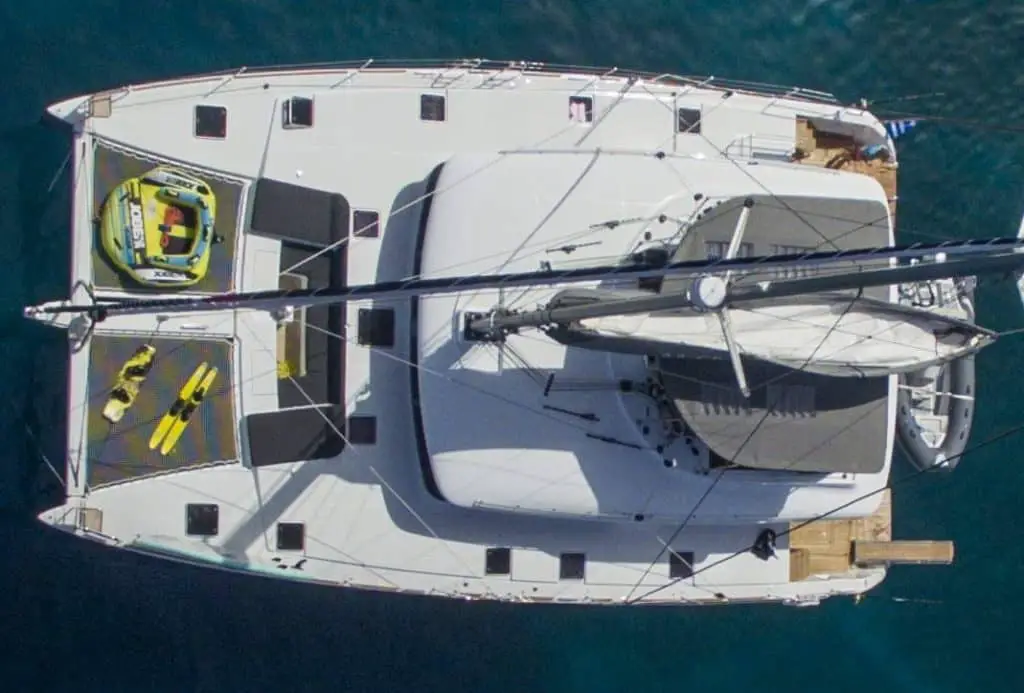
Wide Beam Adds Stability
One of the inherent advantages of catamarans is their stability compared to monohulls. So, no matter which cat you have, you can rest assured that it’s more stable due to its multi-hull structure, no more heeling.
Catamarans go through less rocking and rolling even in heavy seas, making the crew more comfortable and helping them deal with the situation better. Fatigue and even seasickness play an important role in the crew’s ability to control the vessel in rough conditions.
Unlike monohulls, catamarans don’t have ballast or lead-filled keels. So, their stability completely relies on their wide beam and buoyancy. A heavy-weight boat goes through the waves (lead-filled keel monohull) while a light vessel will go up and over (light displacement cat).
Improve Your Seamanship Before Tackling Rough Seas
The right cat that can navigate rough seas isn’t enough. You will also need the right seamanship and skillset, once you have acquired these skills you can navigate through any offshore situation.
If you don’t have enough knowledge and skills, you shouldn’t be careful of venturing out too far. You can educate yourself by taking courses or spending as much time sailing coastal waters as possible.
In addition to knowing how to sail, you should learn about different weather conditions and how to predict the weather as it changes.
You should also know how to take care of your crew and how to place your boat in the most comfortable and safest setup in high waves; know when to slow down or speed up and how to move with the sea.
Knowing how to calm down the cat by using the right amount of sail and proper angle is another key skill you should know before setting out blue waters.
Unlike the myth that cats can’t handle rough seas because they’re not safe enough, these vessels have proven to be stable and fast enough for any ocean!
Owner of CatamaranFreedom.com. A minimalist that has lived in a caravan in Sweden, 35ft Monohull in the Bahamas, and right now in his self-built Van. He just started the next adventure, to circumnavigate the world on a Catamaran!
Leave a Reply Cancel reply
Your email address will not be published. Required fields are marked *
Save my name and email in this browser for the next time I comment.
Recent Posts
Must-Have Boat Gear for Catamaran Sailors!
Sailing is probably the most gear-intensive activity I've ever done; there are so many decisions to be made about what gear to buy now, for tomorrow, and what to definitely never buy. The gear on...
6 Best Trailerable Trimarans For Bluewater and Coastal Sailing
Having a boat costs a lot of money, even when you are not using it, marina fees, etc. And once it is in the water most sailors never go very far from their "home marina" and sailing will be somewhat...

Can Catamarans Handle Rough Seas? Here’s What You Need To Know

Are you a boat enthusiast considering investing in a catamaran? Or perhaps you’re an experienced sailor looking to explore more remote destinations? If so, you may be asking yourself, “Can catamarans handle rough seas?” In this article, we’ll dive into the world of catamarans and explore all the details you need to know to be confident in your purchase.
We’ll look at what catamarans are, the benefits they offer, and how they handle rough seas.
Additionally, we’ll discuss how the low center of gravity and shallow draft contribute to their stability and safety, and we’ll compare catamarans to other boat options.
So, let’s get started!
Table of Contents
Short Answer
Yes, catamarans can typically handle rough seas better than monohulls due to their wide, stable platform.
They also have a shallow draft, which helps them to more easily maneuver through choppy waters.
The multiple hulls also give them greater buoyancy, meaning they can rise up with the waves easier.
However, like any boat, they still need to be handled with care in rough seas and should always be operated with safety in mind.
What Are Catamarans?
Catamarans are two-hulled vessels, usually made of wood, fiberglass, or aluminum, and they are used for recreational sailing and racing.
They are characterized by their two hulls, which are connected together by a platform, providing them with superior stability and maneuverability.
This makes them particularly suitable for navigating choppy waters.
Catamarans also boast a shallow draft, which helps them stay afloat in rougher conditions, as well as a low center of gravity, which helps them remain upright even in rough seas.
The two hulls of a catamaran are usually the same size and shape, and they are typically placed close together to reduce drag and increase speed.
Additionally, catamarans have a wide beam, which gives them an increased stability and helps them stay afloat in rougher waters.
Catamarans are becoming increasingly popular for recreational sailing and racing, thanks to their superior stability and maneuverability.
They are also an ideal choice for those who sail in choppier waters, as their two hulls and wide beam help them stay afloat and remain upright in rougher conditions.
The Benefits of Catamarans

Catamarans are an increasingly popular choice for recreational sailing and racing due to their superior stability and maneuverability.
The two hulls and wide beams of a catamaran give it an edge over other types of boats in rough seas, allowing it to stay afloat and remain upright in choppy waters.
Additionally, catamarans have a low center of gravity, which helps keep them stable and upright in rougher conditions.
These features make catamarans ideal for those who want to sail in rougher waters.
Catamarans also have a shallow draft, which means they dont need as much water to stay afloat.
This allows them to navigate more quickly and easily in shallow and rocky waters.
Additionally, the shallow draft also helps them stay upright in rough seas.
In addition to their superior stability and maneuverability, catamarans also offer more space than other types of boats.
Their two hulls provide plenty of deck space to move around, and their wide beams provide extra room for storage and other amenities.
This makes them great for larger groups or families who want to spend time on the water.
Overall, catamarans are a great choice for those who want to sail in rougher waters.
With their superior stability and maneuverability, shallow draft, and larger deck space, catamarans are well equipped to handle rough seas and provide a safe and enjoyable sailing experience.
How Do Catamarans Handle Rough Seas?
When it comes to sailing in rougher waters, catamarans are an excellent choice.
Thanks to their two hulls and wide beams, they are able to handle the choppy waters better than other types of boats.
The two hulls also provide extra stability, as the wide beam helps keep the boat upright in rougher waters.
The shallow draft of catamarans also helps them stay afloat in choppy waters, as the shallow draft allows them to ride over the waves more easily.
Additionally, the low center of gravity of catamarans helps keep them upright in rough seas, as the lower center of gravity makes it easier for them to stay on course.
In addition to their design features, catamarans are also equipped with a number of safety features that make them particularly well-suited for sailing in rougher waters.
These features include a higher freeboard, which helps keep the boat from taking on too much water in choppy waters, as well as a built-in flotation system which helps keep the boat afloat in the event of a capsize.
Catamarans are also designed to offer superior performance in rougher waters.
The two hulls provide increased speed and maneuverability, which makes it easier to navigate the choppy conditions.
The shallow draft also allows the boat to more easily ride over the waves, and the low center of gravity helps keep the boat on course in rougher seas.
Finally, catamarans are also equipped with a number of other features that make them particularly well-suited for sailing in rougher waters.
These include weather-proofing systems to keep the boat dry, reinforced hulls and frames to increase strength and durability, and improved sail systems to maximize performance in choppy conditions.
All in all, catamarans are an excellent choice for those looking to sail in rougher waters.
Thanks to their superior design features, safety features, and performance capabilities, they are well-equipped to handle the choppy waters with relative ease.
If youre looking for a boat that can handle rougher seas, a catamaran is definitely worth considering.
The Low Center of Gravity

When it comes to sailing in rough seas, one of the key advantages of catamarans is their low center of gravity.
This is because the two hulls of a catamaran are typically separated by a wider beam than other types of boats, allowing for a greater weight distribution.
This means that the hulls are better able to stay upright in choppy waters, as the weight is evenly distributed and the boat is not as susceptible to tipping over.
Additionally, catamarans have a shallow draft, meaning they don’t sit too deep in the water and can ride the waves more easily.
This also helps them stay afloat in rougher conditions, as the shallow draft allows the boat to stay on top of the water rather than being pulled down by higher waves.
All these features combine to make catamarans one of the best types of boats when it comes to sailing in rough seas.
The Shallow Draft
When it comes to navigating rough seas, the shallow draft of a catamaran is an important factor.
Catamarans usually have a draft of less than four feet, which helps them stay afloat in choppy waters.
This shallow draft also allows the catamaran to navigate shallow waters more safely than other types of boats, allowing it to travel to areas that are too shallow for other vessels.
Additionally, the shallow draft of the catamaran helps it to avoid hitting submerged objects, and makes it easier to maneuver in tight spaces.
The shallow draft of the catamaran is an important factor that makes it a great choice for navigating rough seas.
Additional Safety Measures For Rough Seas

When sailing in rough seas, it is important to take additional safety measures to ensure a safe trip.
Catamarans are equipped with two hulls and wide beams that allow them to handle the rough seas better than other types of boats, but they still need to be handled with care.
First, it is important to make sure that you have the right equipment for your trip.
This means having a life vest, safety equipment, and a radio onboard, as well as making sure all of your navigation equipment is up to date and functioning properly.
It is also important to have a knowledgeable crew who is familiar with the area and the conditions.
It is also important to be aware of the weather conditions before you set off and to pay attention to any changes in the weather.
It is best to avoid sailing in storms or in areas with heavy winds and waves.
If the weather does become too rough, it is important to turn back and find a safe harbor.
Finally, it is important to be prepared for any emergencies.
Make sure you have a first aid kit onboard and that everyone on board knows the safety protocols.
Knowing how to handle any emergency situation is key to staying safe in rough seas.
Catamarans vs. Other Boats
When it comes to handling rough seas, catamarans have a clear advantage over other types of boats.
This is due to a number of factors, including their two hulls and wide beams, their shallow draft, and their low center of gravity.
First, the two hulls and wide beams of catamarans provide superior stability, which is essential in choppy waters.
This is because the two hulls provide a larger surface area for the waves to push against, making it easier for the boat to remain upright.
Additionally, the wide beams provide a larger platform for the crew to stand and move around safely, helping to reduce the risk of capsizing in rough waters.
Second, the shallow draft of catamarans helps them stay afloat in choppy waters.
The shallow draft allows them to float on top of the waves rather than being pulled down by them, helping to keep the boat steady.
Finally, catamarans have a low center of gravity, which helps keep them upright in rough waters.
Due to the dual hulls and wide beams, the center of gravity of a catamaran is lower than that of a single-hull boat, making them less susceptible to tipping over in rough seas.
All of these factors make catamarans a great choice for sailing in rougher waters.
While they are not immune to rough seas, they are better equipped to handle them than many other types of boats, making them a popular choice for those who sail in rougher waters.
Final Thoughts
Catamarans are a popular choice for sailing in rough seas because of their two hulls, wide beams, shallow draft and low center of gravity.
They can handle choppy waters better than other boats, making them a great option for those who sail in rougher conditions.
To ensure your safety when sailing in rougher waters, be sure to take additional safety measures such as wearing a life jacket and staying aware of your surroundings.
With the right precautions, you can be sure that your catamaran will be able to handle the roughest of seas.
James Frami
At the age of 15, he and four other friends from his neighborhood constructed their first boat. He has been sailing for almost 30 years and has a wealth of knowledge that he wants to share with others.
Recent Posts
Does Your Boat License Expire? Here's What You Need to Know
Are you a boat owner looking to stay up-to-date on your license requirements? If so, youve come to the right place! In this article, well cover everything you need to know about boat license...
How to Put Skins on Your Boat in Sea of Thieves? (Complete Guide)
There is a unique sense of pride and accomplishment when you show off a boat you customized to your exact specifications. With Sea of Thieves, you can customize your boat to make it look like your...

Catamaran Or Monohull? 27 Important Facts (Explained)
Catamarans and monohull boats are two very different kinds of vessels. Each craft offers distinct advantages and disadvantages that you’ll want to consider before choosing between the two.
In this post, we’ll go over some of the important things to consider when choosing between catamarans and monohull boats:
Table of Contents
Cost & Availability
Both catamarans and monohull boats come in small recreational sailing versions, larger motorboat versions, and larger sailing models. In all cases, the catamarans will cost more and will be harder to find.
The reason catamarans are harder to find because there are not as many of them, and they’re mostly made overseas.
Also, there aren’t as many catamaran manufacturers, so sailors have fewer options when buying them.
On top of this, catamarans have only recently become popular in the United States and other areas of the developed world. This means the used market for boats doesn’t have as many catamarans on it. You might find that you have fewer options when making a used catamaran purchase, which could bring costs up to a premium.
Two Times The Fun with Catamarans

Another reason that catamarans are more expensive than monohulls is the fact that catamaran buyers have to purchase two hulls, two engines, and two of all of the components that help make an engine work.
Traditional sailboats and large powerboats with one engine don’t have this cost issue.
On top of this, a catamaran is much wider than a monohull, and thus you have more space to build and equip.
On the other hand, once you’ve purchased the boat, you do get to enjoy the benefits of having two of everything. We’ll talk about the advantages of this further down in this post.
Maintenance Cost Makes A Difference
The maintenance on a catamaran is also more expensive than the maintenance on a monohull boat. This goes back to the fact that there is twice as much of everything to maintain.
Catamaran owners will need to do preventative maintenance on two different engines, and they’ll have two hulls and a large deck area to clean and maintain as well. If they’re getting the bottom of the boat treated, they’ll have to do this twice (once for each hull).
Even the interior components can usually be found twice.
Each cabin will usually have a head in it, so you’ll have at least two toilets and sinks to maintain, which obviously has its plusses and minuses.
One positive aspect of this is that catamaran owners do have the option of deferring some of their maintenance. For example, if one head is no longer functioning properly, you always have the second one that you can use.
It also adds a bit of safety as well.
This is because while the catamaran does have two engines to maintain, the owner does have power even if one of the engines happens to go down.
Some catamaran owners also like to point out that maintenance may not have to be done as frequently. This is because the engines don’t have to work quite as hard, and other items like additional bathrooms and sinks might only be used half as much.
How Much Space Do You Need?

A catamaran has more space than a monohull. This is because the boat is wider, and it has a much larger deck area. It also has twice as many hulls, so you have more overall space between the two of them.
The additional space is great for people looking to throw parties on their boats.
Most boat owners would agree that the catamaran is usually the party boat of choice at the docks.
Even if you aren’t into throwing parties, the extra space can still be nice for relaxing on the deck or getting a suntan. The wide-open space also makes it easy to use the boat as a fishing platform.
Additionally, you have more space for stuff like surfboards, rafts, and other items that can easily clutter up the deck of a monohull. Even fishing can be easier from a catamaran as the deck provides plenty of space between different anglers.
Catamaran owners also have additional space for carrying fresh water and adding generators and solar panels.
Interior space is generally more plentiful on a catamaran, and luxury catamarans have an easier time fitting large items like washers and dryers inside of them. You can have these on larger monohulls as well, but it will be harder to make them fit than it is in a catamaran.
On the other hand, all of the additional space means the catamaran owner has more space to maintain and clean. Also, all of the additional items that can be brought onto the boat will make it heavier. A heavier boat will use more fuel, and it will travel more slowly.
Living Quarters Vary Between The Two
The living quarters on a catamaran are much different than they are on a monohull. Most people would agree that the berths in a monohull are much more spacious than in a catamaran.
A monohull offers people the opportunity to have a large bed with space on either side to walk around it. This is great for couples who want to get out of bed without waking up their partner.
Catamarans, on the other hand, have the advantage of being able to offer large above-deck salon areas. The galleys, the dining areas, and the living areas can all be above-deck, while the two hulls can provide heads and berths.
Some boat owners say that living in a monohull is akin to living in a basement apartment . Other boat owners prefer the monohull because it brings them closer to the water and gives them the feeling of being at sea.
Privacy Can Be Prioritized On Catamarans
A catamaran offers up many different living areas that people can take advantage of. For example, each hull will typically have its own bathroom and bedroom.
This gives each sleeping area complete privacy from the other.
The living quarters are usually up on the deck, so early risers can wake up and move to these quarters without waking up the others.
The same holds for night owls. A night owl can stay up late without bothering the people who want to retire to their beds earlier.
With two hulls, large catamaran owners can hire a crew and give them their own hull to live in so that there is separation between the cruisers and the crew. This is a wonderful advantage for honeymooners looking to have their own space.
The downside to all of this, of course, is that sometimes a family may not want the additional privacy. For example, a family with small children might not want their children in a different hull than they are.
Additionally, the extra privacy can make it hard for people on the boat to communicate. This could become a big problem in the event of an emergency.
For this reason, it is often recommended that each hull have a radio in it so that the occupants can quickly communicate with each other. Remember, even in inland areas, cell phone reception may not be very good inside the boat hulls.
Recreation In a Monohull vs. a Catamaran
Most sailors agree that sailing a monohull boat is much more exhilarating than sailing a catamaran. Traditional sailboats heel, and sailors get instant feedback while they’re sailing. For the most part, catamarans stay stable, and you don’t get the same feeling with the movement of the wind and the water.
When it comes to monohull powerboats, you have the advantage of being able to pull water skiers, kneeboarders, and tubers with ease, as long as the boat has the power and a planing hull. A power catamaran usually doesn’t have the speed or maneuverability to pull off these recreational opportunities because they are displacement hull designs.
Catamarans excel in more leisurely recreational activities. A catamaran makes a great party deck as well as a great cruising deck. Catamaran owners can comfortably walk around a catamaran without having to worry that the boat might knock them over the next time it decides to heel. This allows boaters to sit and talk with one another comfortably.
A catamaran can also be used as a beaching vessel. This makes it a great platform for people looking to go swimming or fishing around sand bars and other shallow water areas. It also makes it a great boat for sailors looking to sail a larger boat on a river or lake known for having shallow areas.
Swimming and Diving
Swimming and diving off of a catamaran are usually much easier than doing the same from a monohull. The wide stance of the two hulls offers boat designers the option to put in staircases at the back of both hulls.
In between these staircases, some boats will have an additional diving platform and/or a dedicated frame for pieces of equipment and dinghy storage. This makes catamarans great for swimmers, snorkelers, and divers.
On the other hand, modern monohull sailboats can also have good transom stairs for easy access to the dinghy and swimming. Both types of boats can easily travel far out to sea, giving boaters the option of diving in areas that can’t be accessed from beaches and developed areas.

Boat Draft In Shallow Waters
For the uninitiated, the boat’s draft refers to how deep the boat’s hull sits within the water.
A monohull typically sits deep within the water, while a catamaran sits much higher on the water. This is why we stated that a catamaran is good for shallow waters.
The advantage of having a boat that can go into shallow waters isn’t restricted to just recreational activities like swimming and fishing. A boat that can go into shallow water is safer to operate in areas where a boat with a deeper draft might become damaged.
Additionally, a catamaran has more stability on calm waters. This helps make a catamaran more comfortable to relax or sleep on while at anchor or the dock.
The deeper draft of a monohull boat has its advantages as well. A deeper draft provides more stability in rough waters and allows a boat to go further into the sea.
For this reason, many coastal cruisers will prefer catamarans, while many ocean voyagers will prefer monohull boats. In fact, some areas of the Caribbean and the Florida Keys can be off-limits to boats with deep drafts as it simply isn’t safe for the boat to navigate these waters.
This isn’t to say that you can’t navigate these waters in a monohull boat, but you will have to be cautious depending on how deep your monohull’s boat draft is. You wouldn’t have this issue in a catamaran.
Stability On The Sea

A catamaran offers a lot more stability in shallow waters, in calm waters, at the dock, and anchorage. This makes the boat great for cruising and for relaxing in port.
A monohull offers a lot more stability in rough waters.
This makes this boat great for heading out to sea and for navigating vast distances.
Safety Issues To Consider
Both catamarans and monohulls can be built to navigate the waters they were made for safely. This will be determined more by the boat’s category designation rather than the type of boat.
However, each boat deals with unsafe situations in different ways. For instance, a monohull boat is likely to right itself if it is capsized.
This means that even in rough seas, you’re unlikely to find yourself permanently capsized.
The downside to this is that should you become completely swamped from a capsize in a monohull boat, you are much more likely to sink. In fact, if there is a hull breach on a monohull boat, your boat could sink.
Catamarans are said to be unsinkable. This isn’t completely true, but it is very unlikely that a catamaran will sink. Even if a hull is breached, you still have a second hull to keep the catamaran afloat.
However, a catamaran can’t right itself. If you capsize your catamaran, it will stay capsized.
One other safety concern to consider is that a monohull sailboat will heel while a catamaran will not. This increases the chances that someone could fall off the boat or onto the deck in a monohull boat.
Catamarans Are Faster Than Monohull Boats
A catamaran is faster than the average monohull boat.
This is because they face less water resistance, and their narrow hulls don’t have to deal with their own bow waves as a monohull does.
Of course, catamarans aren’t always faster. Old cruising catamarans may not go faster than 8 knots, and modern monohulls can exceed 10 knots.
Monohull boats tend to sail downwind and in choppy seas better than catamarans. This gives them a speed advantage during ocean voyages.
We have a separate post with complete average speeds per type of catemaran . It’s a must read if you are at all concerned about speed!
Fuel Consumption Considerations
Catamarans have two engines to burn fuel, which can drive up fuel costs.
However, a catamaran is lighter on the water, so it usually takes less energy to move a catamaran. This means you’ll end up using less fuel in a catamaran than you would in a monohull.
On top of this, catamarans can decide to use just one engine in low wind areas. This further decreases the amount of fuel that a catamaran consumes.
These rules only apply to calm waters.
A monohull navigates waters with high waves and strong winds much more efficiently than a catamaran. In this case, you’ll use less fuel in a monohull than you would in a catamaran.
Sailing Differences To Notice
Sailing a monohull boat can be exhilarating. These boats can glide through choppy waters, and you get to feel the motion of the boat as the sea rushes by the cockpit and the wind causes you to heel.
This type of sailing also provides instant feedback as you’ll know what you need to do with the sails as you’ll feel what is going on through the boat’s motion.
Sailors all over the world have been using monohull sailboats for years, and you’ll find plenty of outlets for recreational sailing with a monohull sailboat.
Sailing catamarans do not heel like a monohull sailboat.
These boats, therefore, do not provide the sailor with instant feedback. Also, if you incorrectly sail a catamaran, you do risk capsizing the boat more easily.
Training Can Be Quite Hard
Sailing a catamaran and sailing a monohull boat are two different experiences. People looking to sail either should probably get professional training.
Obtaining this training will always be easier with a monohull boat.
This is because monohulls are more popular, so you’ll have more instructors available to you.
Do You (Or Your Friends) Get Seasick?
People who are prone to getting seasick easily might want to consider a catamaran. A catamaran provides much more stability in calm waters, and you get a lot less movement.
On the other hand, people who are not prone to getting seasick might prefer a monohull in choppy waters.
This is because a monohull will deal with deep and choppy waters with high waves much better than a catamaran will.
As a result, a catamarans movement can seem extreme under these types of conditions. People who have never gotten seasick before can end up sick under these conditions.
Here’s a separate article we wrote with everything you should know about seasickness on Catamarans . There are some things you can do and some things you should know!
Docking Is (Usually) Easier With A Monohull Boat
Docking a catamaran can be a difficult endeavor.
This is because catamarans are often too wide to be docked within the slips located in central areas of a marina.
Because of this, they need to be docked at the end of the dock. This leaves them with fewer spots to dock. It also makes docking more expensive.
Catamaran owners traveling through areas that are unlikely to have many catamarans in them may find it difficult to find a dock at all. This is true in areas of the northern Atlantic where monohulls are much more popular than catamarans.
Storage Issues To Consider
Even storing a catamaran can be more difficult. This is because storage facilities often do not have the equipment to get a catamaran out of the water.
The wide width of these boats requires special lifts, and not all boat marinas will have them.
Storage facilities that do get the catamaran out of the water will often charge more money for it. They’ll charge additional fees for taking the catamaran out of the water, and they’ll charge additional fees for the actual storage of the boat as well.
Redundancy And Backup Equipment
We touched upon this earlier, but it is worth repeating that catamarans have many redundancy built into them. This can be a big advantage when it comes to safety.
For example, if one rudder becomes inoperable, the boat can still be steered with the other one. If one engine becomes inoperable, the boat can still be driven with the other one.
In extreme cases, a hull could become damaged, and you could still stay afloat because the other hull will keep the boat safely above water. These safety advantages can save lives and keep people from becoming stranded out at sea.
The primary downside is the maintenance issue that we mentioned earlier. All of these redundant components will need to be maintained. As a result, maintenance costs will be close to twice as expensive in a catamaran.
Cooking Is Easier On Catamarans

Cooking on a catamaran is usually easier than it is on a monohull. The main reason for this is that a catamaran doesn’t heel like a monohull, so you don’t have to worry as much about things falling over.
This not only makes cooking easier, but it makes cooking safer as well.
Additionally, catamaran galleys tend to have more space in them to move around. Also, they are often up on the deck, so you don’t have to climb in and out of the hull with your dinner in hand.
Dinghy Storage
Monohulls and catamarans can both hold dinghies. The larger the boat, the larger the dinghy can be.
However, catamarans have a wide area at the rear of the boat that is perfect for holding dinghies.
This makes getting in and out of the dinghy easier. Also, people can often have larger dinghies on their catamarans because the boat’s stern is so accommodating.
Power Generation Is Easy On A Catamaran
A catamaran has a lot of space for solar panels and wind turbines. Rigid panels can be placed in areas that won’t be walked on, like overtop of the bimini, and flexible panels can be placed in areas where the panels might end up getting stepped on.
The width of a catamaran even gives them more opportunities to put hydro generators into the water.
This means catamarans can generate more power than the average monohull boat can generate.
On the other hand, a monohull usually has less powered items to worry about. Monohulls need less power to operate at full capacity, so you may not need all of the additional space for generating power.
Ventilation Issues To Think About
Some people feel that monohull boats don’t offer enough ventilation. This is especially true in warmer areas of the world.
Catamarans also lack ventilation within their hulls, but fortunately for them, much of the living space is located up on deck. This gives catamarans an edge when it comes to cruising in warm weather.
On the other hand, monohull owners aren’t exposed to the cold winds that you might find up on deck in harsher climates.
This lack of airflow may actually be of benefit in this instance.
Some people find monohulls to be better looking than catamarans and vice versa.
This all comes down to personal preference, so you’ll have to decide for yourself which type of boat has the advantage in this case.
Some people think catamarans are the most elegant thing in the world while others prefer monohull boats as they look more classic.
Resale Value Is An Important Factor
If you read our extensive guide to boat depreciation per boat type , you know that no matter what boat you buy, it will always go down in value. This is just a sad fact of boat ownership that people need to consider before buying a boat.
Many factors go into how much you’ll be able to get for your boat when you resell it. These factors are the condition of the boat, the age of the boat, and the economy in general. For example, people are less likely to want to buy boats during a recession. This is especially true when it comes to smaller boats.
However, one additional factor that catamaran owners need to consider when thinking about resale value is the value of the dollar.
People from the United States don’t have many American catamarans to choose from and will usually need to buy these overseas.
This means that a catamaran will be less expensive to buy when the dollar is strong compared to the Euro and more expensive to buy when the dollar is weaker in comparison. This will affect the used market as well because higher values on new catamarans can help to bring up the value on the used market.
With a monohull boat, you may not have to consider situations like this as there are makers of monohull boats all over the world.
Don’t Let The Length Trick You!
One thought to keep in mind when comparing monohull boats and catamarans is that their different shapes account for different space advantages.
For example, a 40-foot long catamaran will have much more cubic space than a 40-foot long monohull.
Because of this, when comparing boats, you should look at the cubic space rather than the length. In this case, you may be comparing a 48-foot long monohull with a 40-foot long catamaran.
When you compare the two types of boats in this manner, the price differences aren’t quite as large, and the comparison is fairer. It also may make the operating and maintenance costs more similar.
This is an important distinction to make because the length of the boats can trick you!
Consider Trying Both (Before Buying)
Boats can be an expensive purchase, so it makes sense to try them out before you decide to make your purchase.
Rent each type of boat and use it on the types of waters that you intend to cruise on the most.
Try the boat out in different weather conditions as well, and don’t be afraid to do multiple rentals before you make your final choice. The time and money invested into making sure you get the boat you really want will be more than worth it in the end.
Click to share...
Better Sailing

Catamarans vs Monohulls: Which is Better a Better Sailboat For You?
The question of whether to choose a monohull vessel or a catamaran is an eternal dispute between boat lovers. These arguments are usually based on one’s preferences and philosophy. In fact, the popularity of catamarans has grown significantly since their design facilitates many aspects of sailing. But, both mono-hulls and multi-hulls have their advantages and disadvantages. So, in this article, I’m going to list some details about both cats and monohulls so as to help you understand which one is better for you. Remember it all depends on what sort of experience you are looking for. Keep reading!
What is a Monohull?
In general, boats float due to the fact that they displace more water than they weigh. The hull is in “displacement mode” while a boat is stationary or moving slowly. That is, all of the upward forces that keep it afloat come from flotation, which is achieved by displacing water. With certain hulls, increasing the boat’s speed beyond a particular point causes the hull to lift up and skim along on top of the water. This is referred to as “planning.” Monohulls can be divided into two types; displacement and planing hulls.
Some hulls are only capable of moving at displacement speeds . This style of boat has generally slow speed, but it is incredibly efficient to operate. While moving, most have a smooth motion , though rolling (side-to-side movement) might be an issue. On the other hand, while on the sea, achieving fast speeds requires a hull that can readily transition onto a plane. Flat bottom surfaces from amidships aft, or from the middle to the back of the bottom, and a flat transom, or the back of the hull, are the main characteristics of a planing hull. Keep in mind that at a sharp angle, the transom must contact the bottom.
What is a Catamaran?
Nowadays, catamarans are becoming more and more popular. They’re particularly appealing to fishermen since they combine high-speed performance and a smooth rough-water ride with a solid angling platform. Catamarans have two primary disadvantages . Firstly, they require twin engines. Also, larger catamarans may be too broad to fit into standard marina docks. Another disadvantage is that there is less usable interior space than on a monohull of comparable length.
The two hulls of a catamaran are known as amas. These days, the popular phrase is “sponson,” but ama is still acceptable. Note that in comparison to its entire length, each ama is quite short. The narrow amas of a catamaran travel quickly through the water with little power. This allows for fast speeds even when the amas aren’t actively planning.
Trimarans on the other hand have three separate hulls. Sailboat designers have successfully employed this design to provide a large central hull for cabins. But, also for two outrigger amas for stability. The trimaran concept hasn’t been used much in powerboats, despite the fact that several “cathedral” hulls are related. Instead of three independent hulls, a cathedral design squishes them together to the point that they often share a similar planing surface near the transom.

Monohull or Catamaran? Let’s Take a Look at Their Pros and Cons
Catamarans are unsinkable because they are incredibly stable and have natural buoyancy. Yes, they can capsize in a major accident. But, being rescued while floating on the water’s surface is preferable to plunging to the bottom in a monohull. Furthermore, moving around on a flat deck is far safer than on an angled deck.
Classicists have long claimed that catamarans are not as safe as their keelboat counterparts. However, this remark is now regarded as archaic. Since it dates from the mid-nineteenth century when the majority of catamarans were made by amateurs. They could readily tip over even in calm weather, especially if one of their bodies became leakproof owing to damage. Sinking is extremely difficult, if not impossible, for a well-built modern catamaran. Modern structures are designed using computer simulations of various water conditions. Bear in mind that the maximum potential safe sail area is available to cruisers and charter possibilities in particular.
Monohulls , particularly sailboats, offer significantly stronger “self-righting” capabilities in the event of a worst-case knockdown situation. In a catamaran, once you’re upside down, you’re stuck there…And, who wants to be upside down in the middle of the ocean? Returning to an upright position gives you complete access to onboard safety equipment. This includes a liferaft, dinghy, flotation devices, EPIRBs, and strobe lights, which can save you if the boat sinks.
Generally, a catamaran’s high speed allows it to avoid adverse weather . While catamarans do not point as high into the wind as monohulls they are around 20% faster . Or, if they do, they create more leeway or slide sideways. This means that even if you sail upwind at a slightly broader angle to the wind than a monohull and cover a more distance, you will arrive at your destination sooner than a monohull.
A modern performance catamaran with daggerboards and strong sails may point as high as a monohull of comparable size. It will point similar to a comparable monohull but will sail far faster. This allows it to reach an upwind position far sooner than a monohull. However, it’s worth noting that the majority of production cats on the market are underpowered and have standard smaller sails. Many of these designs perform poorly in light breezes. Unless they’re equipped with larger headsails, a Code Zero, and a square-top mainsail.
While cats are more comfortable and safer in rough weather, we must admit that if the weather gets extremely terrible (60 knots of wind or more), it’s better to be on a monohull for survival reasons. For serious offshore single-handed sailing, I believe a monohull is superior since it is easier to hove-to in it. Bear in mind that when you’re in a cat during severe storms you won’t feel any danger, but it demands some nifty seamanship. And, keep in mind that even though a monohull can capsize in bad weather or even roll in a storm, they usually right themselves. A catamaran , on the other hand, is incapable of self-righting . However, the cat will usually stay afloat, providing a safe haven to wait out until aid arrives. Modern catamarans, on the other hand, are extremely difficult to capsize.
That being said, most catamarans can travel 200 to 250 miles per day, and with contemporary technology allowing one to control weather, it’s difficult not to deal with bad weather. In many circumstances, a faster boat is a safer boat because it can outrun heavy weather. A catamaran can avoid the worst weather and, at worst, put itself in the best position to avoid the brunt of a storm if there’s good weather routing information.
So, to sum up, cruising catamarans are quicker than monohulls, and sailing catamarans, depending on their angle, can sail at half the speed of the wind. It’s great to be on a boat that can swiftly attain high speeds and get you to your destination safely and on time. However, catamarans are faster because of their lower surface area , but their prices are generally higher than those of monohulls. Instead of fighting the elements, monohull designs operate in harmony with them . In addition, keep in mind that when sailing upwind, sailing catamarans are inefficient and tack slowly.
Fuel Consumption
Do you want to save money on gas? Then, in most cases, catamarans have less fuel consumption than monohull boats. Catamarans save a lot of gasoline since they have a less wetted surface area on their hulls. They can propel the boat with just one engine in weak winds. Also in flat water, and if the engines have the same number and horsepower. However, in heavier weather , where the higher efficiency of a monohull design provides less resistance , this is not the case.
Generally, catamarans have two fuel-burning engines, which can raise fuel expenses . However, because a catamaran is lighter on the water, it requires less energy to move. In a catamaran, you’ll use less fuel than you would in a monohull. Furthermore, in low-wind areas, catamarans might choose to use only one engine. This reduces the amount of fuel consumed by a catamaran even more . But, only calm waters are subject to these laws. A monohull is far more efficient than a catamaran in navigating waters with heavy waves and heavy winds. A monohull will consume less fuel than a catamaran in this situation.
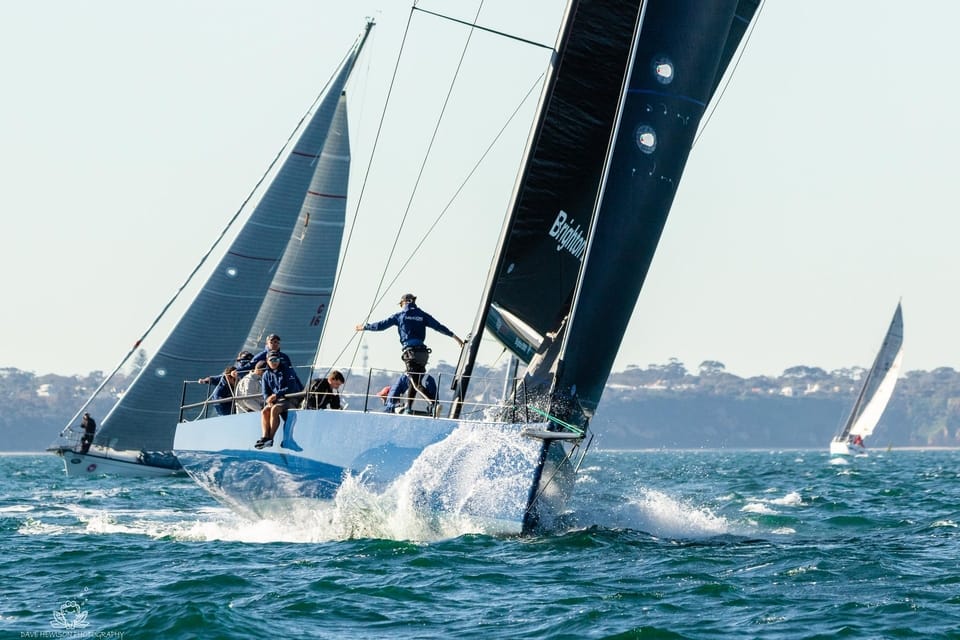
The best feature of catamarans is that all of the rooms are on the same level. The four-cabin arrangement is common with sailing cats and is popular among charter companies. Owner versions usually feature three staterooms, with one hull serving as a big cabin for entertaining. Most catamarans have a big central living room with not one, but two narrow staircases leading down into the hulls—one on each side. It’s a little like living in a tube in the hulls. They’re too thin to accommodate walkaround double/queen berths like those found in monohulls. But, in case of an emergency, it would be impossible to communicate with someone in the opposite hull.
Obviously, a monohull has less space than a catamaran. This is due to the fact that a cat is broader and has a larger deck surface. It also has twice as many hulls as the other, giving you greater total space between them. People who want to host parties on their boats will appreciate the extra space. The catamaran is usually the party boat of choice at the docks, according to most boat owners. Even if you don’t like to host parties, the extra room might be useful for lounging on the balcony or tanning. The boat’s large open space also makes it simple to utilize as a fishing platform.
You also have more room for equipment like surfboards, rafts, and other equipment that can easily clutter a monohull’s deck. Even fishing from a catamaran can be easier because the deck allows for plenty of space between anglers. Owners of catamarans also have more room for carrying fresh water and installing generators and solar panels. A catamaran’s interior room is often larger, and in luxury catamarans, it’s easier to install heavy appliances like washers and dryers inside. These can be fitted to larger monohulls as well, though it will be more difficult than on a catamaran.
All of the extra space, on the other hand, means the catamaran owner has more room to maintain and clean. Furthermore, all of the other stuff that can be brought into the boat will add to its weight . And, as well all know, a heavier boat will consume more fuel and move at a slower speed.
Maneuverability
With their twin motors, catamarans are incredibly agile . On a catamaran, the engines are widely apart, making navigating more easier and more precise than on a monohull, unless the monohull incorporates a bow thruster. Most of the time, a bow thruster isn’t required because the engines are around 20 feet apart. When there’s no bow thruster (as do few monohulls) you have to rely on prop-walk and prop wash on the rudder. On her own axis, a contemporary catamaran can turn 360 degrees. A monohull would be unable to accomplish this while it has a larger turning circle.
A monohull under sail, on the other hand, is far more maneuverable and will tack much faster than a catamaran. But, the ease of movement under motor on a catamaran, especially in close quarters, is substantially superior. They also feature shallow drafts , allowing you to maneuver into areas that a monohull cannot, as well as anchor closer to shore . However, monohulls are more maneuverable as you don’t have to deal with two hulls. They can make sharper turns and travel through small channels and small areas easier than cats. In addition, their hull displacements lessen the negative impacts of crosswinds in confined spaces.
Anchoring and Docking
While docking a catamaran is simple, its big size makes it difficult to fit into a standard slip. However, with some skill and good planning, finding room should be no problem. You may even anchor or moor the boat and dock it with the dinghy, which is much easier than a monohull. However, keep in mind that in most cases docking, hauling, and slipping a monohull is significantly easier, takes up less room, and is far less expensive.
Moreover, docking a catamaran can be a challenging task. This is due to the fact that catamarans are frequently too wide to dock in the marina’s core regions. As a result, they must be docked at the far end of the dock. Therefore they have fewer docking options and raise the cost of docking. Owners of catamarans sailing through places where there aren’t many catamarans may find it difficult to find a dock at all. This is especially true in the northern Atlantic, where monohulls outnumber catamarans.
Keep in mind that one of the most significant advantages of a sailing multihull is its stability . Not only at sea, when heeling simply does not – or should not – occur to any significant extent, but also at anchor. It also greatly expands one’s anchorage options to include areas influenced by the swell. This is quite common in the Caribbean, where a slight shift in wind direction may make a previously flat, quiet anchorage intolerable in a monohull. In addition, its fairly shoal draught expands the options even more.
Catamarans have a large platform, making them ideal for relaxing at anchor without the rolling motion that monohulls are prone to in a swell. Many monohull sailors had to leave anchorages because of the uncomfortable anchoring. This is because large rollers or swells entering an anchorage can make the situation extremely uncomfortable and dangerous.
Also, a bridle is tied to both bows and down to the anchor chain on catamarans , resulting in a fairly secure position at anchor . In heavy winds, many monohulls tend to sail at anchor since the bow acted as a sail (due to the high freeboard). They sail in one direction until the chain snatches, then tack across and sail in the opposite direction, almost completely dislodging the anchor. The catamaran, on the other hand, is much more stable at anchor and does not sway as much.
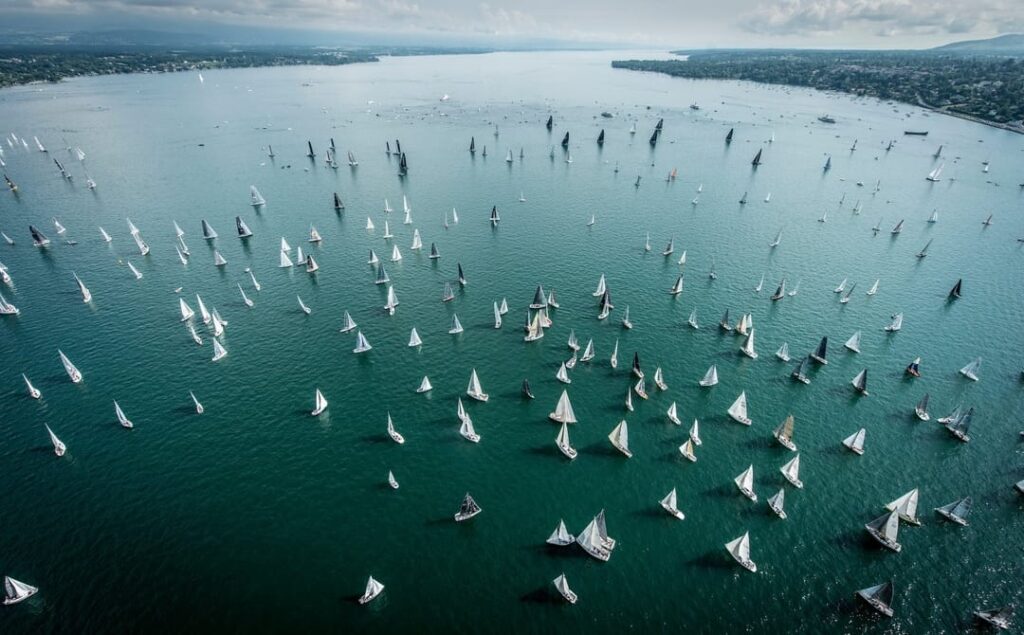
Sailing Abilities
Most cruising multihulls won’t point like a monohull with a deeper keel upwind, and the motion may be rather unpleasant when sailing in rough weather. You must also keep a close eye on the sail area, but we’ll analyze this further below.
Moreover, catamarans are not suitable for racing and sailing sports. They can be fantastic for a holiday or even living aboard, but most racers would never buy one because of the stability. There is no sense of wind, waves, flying, or the boat itself on a catamaran. It’s quite tough to tell when it’s time to reef. While this can be done by feel on a monohull, there is specific instruction for catamarans as to what winds the sail area should be reduced.
When sailing to higher latitudes, like the North Atlantic, then a monohull would be a better solution than a catamaran. Residential areas are easy to heat and keep warm, and traditional metal may even melt thin ice. The contrary is true in the tropical zone, where huge catamaran salons would be unbeatable.
Monohulls can sail higher into the wind than most catamarans due to their keel. Daggerboards, which serve the same role as a keel and boost windward performance significantly, are common in some catamarans. However, daggerboards are not seen on 95 percent of cruising cats (those available for charter). Also, a monohull will be much easier to tack than a catamaran and glide lightly through the water. Moreover, in rougher seas, certain catamarans experience an annoying slapping of water on the bridge decks. A monohull responds to the helm more quickly than a multihull (in other words, they turn faster). This is due to the fact that most cruising cats have small “spade rudders” whose depth is dictated by the need for a modest draft. While with a keel, a monohull can have a more responsive rudder for its draft.
Monohull spreaders are 90 degrees to the mast, however, catamaran spreaders must be backswept. The reason for this is that a monohull has a backstay, and by combining it with the intermediates, you can achieve a lovely pre-bend in the mast. Keep in mind that the pre-bend is to flatten out the mainsail and allow for better performance.
Also, in order to pre-bend the mast on a catamaran without a backstay, you’ll have to utilize the backswept spreaders and diamonds. The reason I bring this up is that if you want to broad reach or run on a catamaran, you can’t let the mainsail out all the way because the backswept spreader tips could puncture the cloth. Because the spreaders on a monohull are at 90 degrees, you can let the main and boom out much wider, which is obviously more effective. This is one of the reasons why a catamaran should broad reach and tack downwind.
- Maintenance
Because catamarans have two of everything, there is a clear trade-off between maintenance costs, reliability, and redundancy. One of the most significant advantages of having two of everything is that you have a backup . As a result, even if one component fails, you can typically still utilize the boat, such as running on one engine while the other fails. While redundancy is fine, lower maintenance and repair costs are generally preferable. Although having two of everything provides you some redundancy, I doubt you’ll want to take the boat out if one of the two hulls “fails.” Of course, this means two hulls to clean and antifoul, double the engine maintenance, and so on , but having two of the important pieces of equipment, such as engines, outweighs the disadvantages.
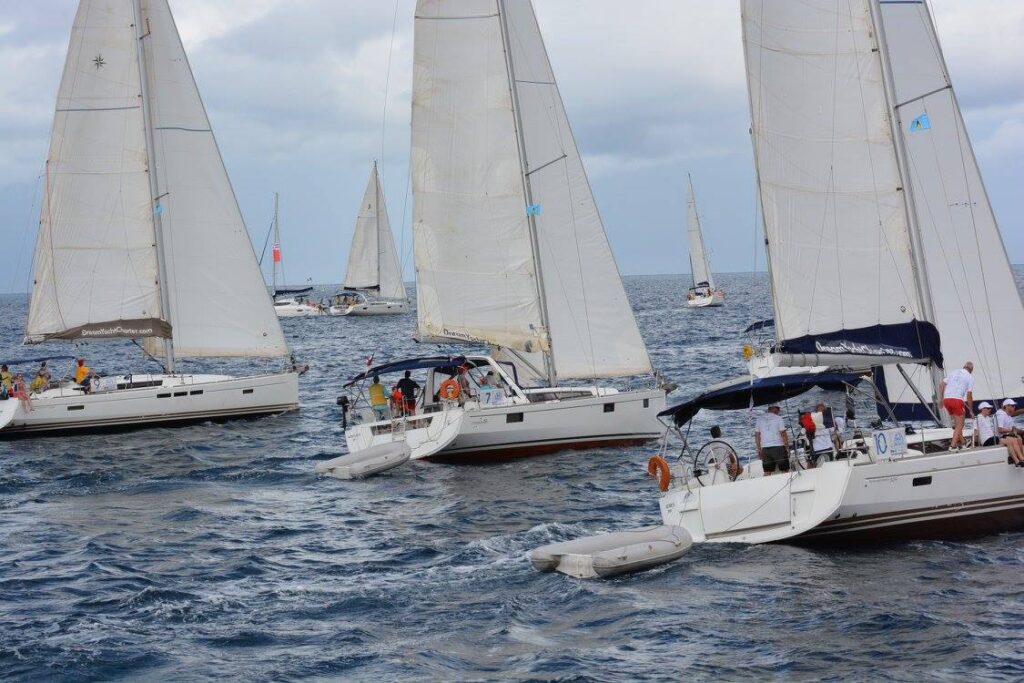
Due to their weight-bearing, catamarans have minimal to no heeling and do not roll at anchor. With sudden gusts, heeling on a monohull can be dangerous and uncomfortable, not to mention seasickness. Again, the trade-off is a noisy ride and fast movement, which many people find uncomfortable in bad weather. However, the heeling action of a monohull sailboat offers stability, spills wind from the sails, and provides safety.
Catamarans, unlike monohulls, do not have ballast in their keels, therefore they rely on beam and buoyancy for stability. Typical cruising catamarans have a beam-to-length ratio of around 50%, while several modern designs exceed this figure. A 45-foot catamaran will be around 22 feet wide, offering a highly solid sailing platform. Monohulls, unlike catamarans, cannot overcome rolling and pitching because of their narrow beam and lead ballast.
Rolling and pitching on a monohull while underway is quite dangerous. But, walking around on the deck of a catamaran while underway is easier because the boat is considerably more stable and does not heel. Sail adjustments and reefing are also significantly easier and safer for the crew as a result of this. The risk of falling overboard on a catamaran is far lower than on a monohull because of the rolling and pitching motion.
Generally, buying a catamaran is substantially more expensive than a monohull. So, if you opt for a cat you should also consider your budget before even starting your research. Pre-owned monohulls, on the other hand, are extremely inexpensive to purchase due to a current supply that considerably outnumbers the demand.
Nowadays, catamarans are in high demand , and they normally keep their worth far better and longer than other types of boats. And that’s why the market is currently centered to manufacture lots of them. Bear in mind that looking for a catamaran under $250,000 your options will be limited, and finding a catamaran under $100,000 is nearly difficult. Unless you opt with older boats like the Prouts or the less priced Geminis, a monohull is your best bet in this instance.
The cost of a cat rises if you need at least two of everything. But, keep in mind that due to their popularity, catamarans have a high resale value and a low depreciation rate , and they normally sell faster than monohulls. Due to the fact that most catamarans are not made in the United States, delivery expenses must be considered when purchasing the boat. Multihulls are becoming more popular, and as a result of the increased demand, they command greater prices in both the new and brokerage markets. Lastly, when considering a purchase, keep in mind that maintenance costs are substantially higher than on a monohull.
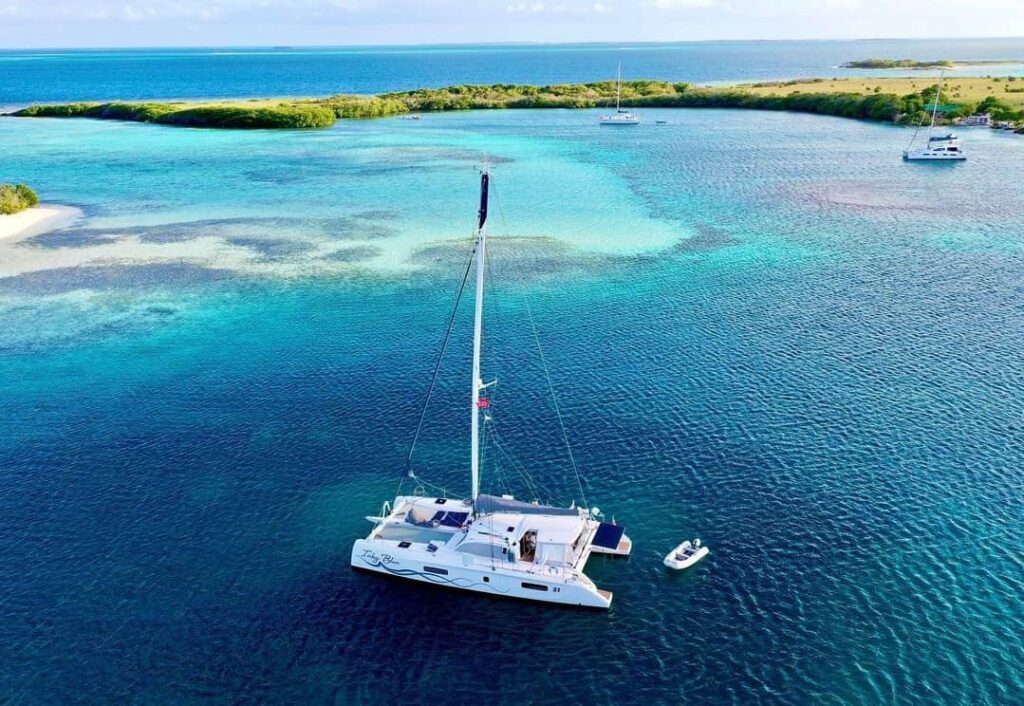
Catamarans vs Monohulls – The Bottom Line
So, this is it! We’ve come to the end of this highly discussed topic among sailors. Obviously, everything would be determined by two basic factors: personal preferences and budget considerations. Both monohulls and multihulls have their pros and cons and it’s totally up to you to decide which one suits you best. Because the two types of vessels provide such a different experience, it is highly recommended that you rent and test each one before purchasing to compare everything. In any event, it’s reasonable to say that a catamaran is an excellent choice for a charter, if not for purchase. Despite its high price, it provides comfort, space, and stability but you have a better overall sailing experience with a monohull. So, I hope that this article will help you make the right choice according to your needs. I wish you good luck with your research!
Peter is the editor of Better Sailing. He has sailed for countless hours and has maintained his own boats and sailboats for years. After years of trial and error, he decided to start this website to share the knowledge.
Related Posts

The Ultimate Guide to Choosing the Best Fishing Line for Trolling

Lagoon Catamaran Review: Are Lagoon Catamarans Good?

Best Inboard Boat Engine Brands

Are O’Day Sailboats Good? A Closer Look at a Classic Brand
- Buyer's Guide
- Destinations
- Sailing Info
Hit enter to search or ESC to close.

Are Catamarans Sable in Rough Seas?
Sailing a catamaran in rough seas is not an easy task. Actually, sailing any boat in big waves is not easy . It requires a lot of knowledge , determination of the crew and stability of the boat. So, are catamarans safe for ocean crossing when you have to sail in heavy seas?

What Is It That You Need to Know?
There are a few things you need to know when it comes to power catamaran in rough seas:
1. Drogue slows down, Sea Anchor Moors You With Minimal Drift
When sailing catamaran in heavy seas, you need yo know what you need to use depending on the sea room. If drogue will slow your boat down, the sea anchor will moor you to the middle of the sea with minimal drift. However, at the end of the day, what you are looking for is control. Using whichever means of slowing the boat to be in sync with the seas will create much less stress on boat fittings in comparison with sea anchors, because that way, you would be running with the wind and the seas.
2. When Running, A Cat Should Be Taken Downwind
It is more beneficial to run downwind at a slight angle when cruising a catamaran in heavy seas because this will increase the effective length of the cat by presenting its diagonal distance. This distance is longer than the overall height of the boat, to following seas. Moreover, this diagonal distance is the most important aspect of multihull stability. By running at a slight angle, the bows will bury less, and the risk of pitchpoling is minimized.
3. Run Before Seas and Wind With Minimal Sail

This is the preferred tactic to many sailors when it comes to calming down catamaran in big waves. You may not have the need to touch the helm, because the autopilot will do its job without any mistake. You should keep your cat’s twin non-yawing, always-vertical rudder and keels will keep the boat on track, making it much easier for the autopilot to cope with the seas.
Catamaran VS Monohull in Rough Seas
1. Deploying Sea Anchor
In order to keep chafe to a minimum, the most important aspect in deploying a sea anchor is the ability to control the angle, otherwise, the vessel will have the wind and prevailing seas without putting too much strain on fittings. The wide beam of a catamaran when in rough seas will give the boat an advantage over monohull, since the bigger bridle angle will reduce strain and improve attitude leverage, which facilitates boat rotation in respect to the sea anchor. However, an important note is that sea anchors should be used as a very last resort on a catamaran.
2. Seaworthiness
When it comes to seaworthiness, it is just a combination of seamanship, construction, and boat design. If monohulls often can fend for herself in a storm, a multihull requires more attention. Higher speeds and loads will demand a vigilant crew who need to dial in the cat in order to find the safest and most comfortable setup. Luckily, fast cats have an edge in speed over monohulls with equal length and can avoid bad conditions by smart weather monitoring and routing.
These boats are stiffer than keelboats thanks to their extensive righting moment, which is many times that of a monohull. A well-designed cruising catamaran is unsinkable , sheltering the crew in a catastrophic event, whereas the monohull would disappear from sight, forcing the crew into a miniature rubber raft.

Book2Sail™ © 2024 All Rights Reserved - Book2Sail and the Book2Sail logo are registered trademarks of SAS Marine Services Ltd. in Malta
- Travel Resources
- Destination Inspiration
- Tips & Advice
- Did You Know?
- Conservation

- Action & Adventure
Are Catamarans Safe in Rough Seas?
- January 13, 2021

Trying to sail any boat in rough seas will take a lot of effort, even with these catamarans . Several factors work together to keep you safe should you encounter a gale or choppy waters. Fortunately, modern catamarans have seen significant improvements that make them safer than ever before in rough seas.
Modern Catamaran Improvements
Today, there are two main types of catamarans you might find yourself on, one being charter or cruising catamarans, and the other is high-performance.
As you can likely tell, the high-performance models are bound to be substantially better in rough seas and give you the ability to outrun poor weather. These days boat fitters are always improving the spec on all types of boats especially catamarans. However, they can also be challenging for beginners since they’re designed for higher speeds.
Charter or Cruising Catamarans
If you’ve recently been on vacation, you’ve likely seen a charter catamaran or hybrid catamarans . These boats are specifically designed for charter cruises and often feature low-aspect rudders, fixed keels, and high-wind flybridges. They also have significantly heavier displacement as well as shorter bows.
Charter catamarans can be challenging to use at high speeds, even if you’re navigating on flat water. When traveling windward, they’re ideal for close-hauled sailing at up to 60-degree angles.
If you were to encounter rough seas in these boats, there are two main concepts to remember: maintain control and speed. You won’t want to pick up too much speed because it can be more challenging to control. It could also endanger both the crew and the boat, which is why they’re not ideal for choppy conditions.
High-Performance Catamarans
These boats are designed with special techniques that make them ideal for traveling at higher speeds. They feature rudders deeper than charter models, which also creates less displacement and windage.
Another benefit is that they have highly efficient centerboards and daggerboards. When sailing, you’ll notice high-performance models can outsail nearly any keelboats while traveling windward.
In addition to their impressive speeds, they are also known to be more lightweight, making them easier to maneuver. If you’re caught in rough seas in a high-performance catamaran, you’re more likely to navigate through the storm successfully.
Not only will you be able to manage the storm conditions securely, but you could also outrun inclement weather. By maintaining your balance while using lower loads and traveling at higher speeds, you can be safe.
How To Handle Catamarans in Rough Seas
Let’s say you’re stuck in a situation where you have no choice but to sail through rough seas with your catamaran. Consider these tips because they could significantly improve your chances of a safe return to port.
Reading the Sea Room
Having a good idea of the sea room can give you the information you need to navigate the boat safely. You’ll be able to determine the appropriate speed to sail with the sea, allowing you to maintain the most control.
Depending on the conditions, you have to determine whether slowing down or speeding up is ideal. Remember, drogue slows the catamaran down while the sea anchor is best for mooring with minimal drift. The more effective you are at moving with the sea, the less stress the boat will experience.
Opting for Downwind Travel
When sailing in heavy seas, consider sailing at a slight angle because it improves the boat’s sufficient length. The catamaran will have access to diagonal distance, which is longer than the boat’s total length. The more length you have access to, the easier it will be to follow the sea.
Another important aspect of taking advantage of diagonal distance is that it keeps your hull stable. With the proper angle, pitchpoling is far less likely, and the bows won’t bury as much.
Using Minimal Sail
One of the most important factors to consider is the amount of sail you should be using when you encounter rough conditions. Sailors most often prefer to use minimal sail since it calms the catamaran and allows the boat to autopilot easier.
By encouraging non-yawing and vertical rudders and keels, the boat will find it easier to handle the brunt of navigation.
The Advantages of Catamarans in Rough Seas
There is an incredible number of myths about catamarans, especially among monohull owners. These boats are one of the superior options for tackling rough seas, especially with anglers. A few essential advantages to note are:
High-Speed Sailing
The higher speeds of performance catamarans have made them a popular topic of discussion among Naval scientists . Their hull energy allows sailors to travel extensive distances in a limited amount of time. With this amount of power, you can quickly navigate through heavy waters or avoid them entirely.
Added Stability
One of the primary reasons to consider a catamaran for rough seas is its inherent stability. They are often preferred for families and senior sailors who find it tough to find their sea legs. The boat’s size and design make it far less susceptible to wave action, especially compared to a monohull.
Reduced Seasickness
Becoming seasick can disrupt your entire trip on the water, which is another reason to consider catamarans. With their improved stability, you’ll feel far less motion aboard a catamaran than other boats. There’s far less rocking and rolling, which makes it a more comfortable experience for everyone.
Impressive Buoyancy
For as large as they are, catamarans are ideal for their buoyancy. Since they aren’t designed with a lead-filled keel, your boat will float even if it’s holed. Some of the more modern high-performance catamarans are so buoyant; they’re relatively impossible to sink.
Catamarans are safe to navigate in rough waters, as long as you can maintain control of the craft. They have remarkable buoyancy, inherent stability, and high speeds to outrun inclement weather.
Related Topics
- are catamarans safe in rough seas
- sailing holidays
Vacationing in Colorado

Qualities to Look For in a Trailer
- January 14, 2021
You May Also Like

Springtime in Gatlinburg: 7 Fun Things to Do
- March 21, 2024

Top 7 Holiday Adventures to Try

Best Spots In France For A Walking Holiday
- March 20, 2024

How to Have an Exhilarating Experience on a Yacht Rental in Dubai?
- March 18, 2024

Best Places to Visit in China

Summer Adventures You Should Organize This Year
- March 15, 2024

The Italian Lakes: An Adventure Holiday Waiting To Be Had

11 Key Questions To Ask Yourself When Planning Your Next Travel Adventure
- March 13, 2024
Input your search keywords and press Enter.

Catamaran Vs Monohull

Last Updated by
Daniel Wade
August 30, 2022
Monohulls and traditional sailboats, once ubiquitous, are giving way to modern catamarans. But how do these designs differ?
Monohulls have a single hull, and catamarans have two hulls side-by-side. Catamarans are faster than monohulls of the same length and displacement, but monohulls are stronger and more spacious. Monohulls are also cheaper and easier to build than multi-hulls.
In this article, we’ll cover the differences between catamarans and monohulls, along with the benefits and drawbacks of each design. We’ll also cover the sailing characteristics of each and why catamarans so easily outrun equivalently-sized monohulls.
We sourced the information used in this article from trusted sailboat design resources, along with manufacturer specifications and boat market analysis.
Table of contents
What is a Catamaran?
Catamarans are a kind of multi-hull sailboat with two hulls joined together. They are often short and wide, resembling a square or rectangle from above.
Catamarans are colloquially distinct from outriggers, which are double-hulled vessels with one large primary hull and a small outboard stabilizing hull.
Catamarans usually have hulls that mirror each other, both in size and arrangement. Sometimes, the interior layouts are mirrored, too—but this varies between designs and manufacturers. Catamaran hulls are narrower and taller than most monohull designs of equal lengths.
Catamarans have limited commercial and military utility, as these applications favor space and ease-of-construction over handling characteristics. That said, there are some commercial uses for catamaran designs—most commonly passenger and car ferries.
What is a Monohull Sailboat?
A monohull is probably what you traditionally think of as a boat. Monohulls are longer than they are wide. It features a single hull—it’s that simple. Sailing monohull designs have evolved over the centuries into many distinct types, usually distinguished by keel type.
Monohulls come in many shapes and sizes . For example, sailing monohulls designed for offshore use have long keels that sometimes extend much further below the waterline than the freeboard and cabin extend above it.
Monohull sailboats are also designed for other purposes, such as inland sailing and racing. These vessels have more contemporary characteristics, such as rounded shallow ‘canoe’ bottoms, V-bottoms, and fin keels.
Monohulls aren’t just sailboats. Virtually every cargo and container ship, warship, and many passenger ships are monohulls due to their strength, ease of construction, and high cargo capacity.
Are Monohull Sailboats More Common?
Monohulls are more common in every application, though multi-hulls are becoming more common for ferries. Monohulls have numerous benefits over multi-hulls, and these benefits only increase with scale.
Monohulls are easy to construct. They’re also cheap. Large monohull ships, such as container ships, can be built with very little material and effort. This is because the vast majority of the length of a monohull is just a box, with a bow and stern welded onto the end.
Sailboat construction is more intricate, but the costs are still lower. Plus, monohull designs are robust, and cabin space is plentiful. There’s a lot more study in the field of monohull design, which was the universal truth until somewhat recently.
But all in all, the reason why monohull sailboats are more common is that they work just fine. Most sailboat owners aren’t interested in breaking speed records or hosting dozens of people aboard their boats. As a result, a standard, simple, and easy-to-control monohull are more than sufficient.
Are Catamarans Faster than Monohulls?
Catamarans are most certainly faster than monohulls. This is almost always the case. Even the fastest production monohulls can’t hold a candle to the average cruising catamaran.
But why is this the case? Aren’t catamarans restricted by the same hydrodynamic forces as monohulls? As it turns out, they aren’t. This has to do with the unusual way hull waves impact speed.
Hull Speed Limitations
Monohull speed is limited by something called hull speed. Hull speed is determined using a formula that calculates the maximum speed a displacement hull can travel under normal power and conditions.
When a displacement hull moves through the water, it kicks up a set of waves at the bow and stern. These waves travel along the side of the vessel and create drag, which slows down the boat. Normally, the power of the wind can overcome this drag—but only to a point.
At a certain speed, the waves kicked up by the bow will sync with the waves kicked up at the stern and begin ‘working together’ against the boat. The speed at which this occurs is the hull speed, which is calculated from the length of the boat.
Hull speed limitations for monohulls aren’t universally true all the time. Some vessels exceed it, and some don’t—but the number is a useful estimate of the limitations of monohull designs. Modern monohulls with clever hull shapes can defeat hull speed calculations.
Do Hull Speed Limitations Apply to Catamarans?
Surprisingly no—hull speed calculations don’t work for catamarans. This is because, for one, the hulls are shaped differently. Alone, catamaran hulls wouldn’t float correctly. But together, they create different hydrodynamic effects and cancel out the effects of hull speed.
This means that catamarans can easily exceed the speeds of even the fastest monohulls of equal length—and sometimes beat them by a margin of 50% or more. It’s not unheard of for 40-foot catamarans to exceed 20 knots, whereas 40-foot monohulls rarely get past 10.
Are Catamarans More Comfortable than Monohulls?
Catamarans can be much more comfortable than equivalently-sized monohulls—up to a point. This is because catamarans engage in ‘wave piercing’ and have a wider and more stable footprint on the water.
Catamaran hulls, when properly designed, can slice through parts of a wave instead of riding over every peak and trough. This effectively reduces the height of the weight, which reduces the amount the boat rolls.
Additionally, the wide footprint of a catamaran allows some waves to simply pass right under it, keeping the boat level for longer durations. Catamarans also don’t heel under sail—instead, they plane slightly, raising the bows out of the water and reducing bumps.
Monohull Benefits
Monohulls are proven in all conditions. A well-designed displacement monohull sailboat can ride out the strongest storms, and monohull workboats can support enormous loads and move them efficiently. They can be fast, comfortable, and also easy to sail (even for beginners).
Monohulls are cheap to build and forgiving, as precision doesn’t have to be microscopic to get them to sail right. They’re robust and strong, featuring a naturally stress-resistant hull shape. They’re also easy to modify and aren’t required to meet as strict of dimensional ratios to operate.
With a monohull sailboat, you have a lot of interior room to work with. This means that monohulls are available in numerous cabin layouts and are just as easy to modify as they are to build. Monohulls often have a center of gravity at or below the waterline, which enhances stability at steep heel angles.
On the water, displacement monohulls can weather extreme conditions with ease. They lack the initial stability of multi-hulls, but they can recover from knockdowns on their own, and they’re very difficult to push past their rollover point.
Why do Catamarans Cost More than Monohulls?
Catamarans cost more than monohulls because they’re more expensive to build, more complex to engineer, and require more material. This isn’t always the case, but the design of catamarans requires much more careful engineering and strength-of-materials analysis than comparatively simple monohulls.
There are several critical structural points on catamarans that monohulls lack. In fact, the very shape of a monohull is physically strong—so it has inherent durability. Catamaran hulls must be joined in the middle, and the mast must have a strong point far from the inherently sturdy hulls.
This requires stronger materials and more care during design or construction. This is why catamarans remain a premium part of the sailboat market and why they still aren’t the most popular sailboats despite their numerous performance and comfort benefits.
Catamaran Cabin Layout
Catamaran cabins are split between the two hulls, and there’s usually a large pilothouse in the center. Pilothouse catamarans can be quite spacious, primarily due to the large space between the hulls.
The pilothouse is usually where kitchen and sitting areas are located, along with cockpit access and the controls of the sailboat. The mast is also located in this area.
Catamaran cabins sometimes mirror each other. For example, each hull may contain two identical bedroom/bathroom combos, while the center console area contains the kitchen and living spaces.
The two identical hulls sometimes make for unusual design decisions (such as small catamarans with four master bedrooms), but owners say this gives their passengers a much better experience than a monohull cabin.
Monohull Cabin Layout
Monohull cabins, with the exception of split-cabin sailboats with a center cockpit, have only one large interior space to work with. It’s usually much wider than catamarans of equal length.
Monohull cabins are usually accessible from the bow (via a flush deck hatch) and the stern via a traditional companionway. They run the span of the hull between the bow and the cockpit and sometimes include spare berths under the cockpit seats.
These spare berths are often used as convenient sea cabins, as they offer quick access to controls in case of an emergency. Catamarans often have convertible berths in the center console for the same reason.
Monohull cabins are traditional and include everything that catamaran cabins do—albeit with slightly less room overall. That said, individual spaces are often much wider, and facilities are more appropriate.
Related Articles
I've personally had thousands of questions about sailing and sailboats over the years. As I learn and experience sailing, and the community, I share the answers that work and make sense to me, here on Life of Sailing.
by this author
Learn About Sailboats
Most Recent

What Does "Sailing By The Lee" Mean?
October 3, 2023

The Best Sailing Schools And Programs: Reviews & Ratings
September 26, 2023
Important Legal Info
Lifeofsailing.com is a participant in the Amazon Services LLC Associates Program, an affiliate advertising program designed to provide a means for sites to earn advertising fees by advertising and linking to Amazon. This site also participates in other affiliate programs and is compensated for referring traffic and business to these companies.
Similar Posts

Affordable Sailboats You Can Build at Home
September 13, 2023

Best Small Sailboat Ornaments
September 12, 2023

Discover the Magic of Hydrofoil Sailboats
December 11, 2023
Popular Posts

Best Liveaboard Catamaran Sailboats
December 28, 2023

Can a Novice Sail Around the World?
Elizabeth O'Malley
June 15, 2022

4 Best Electric Outboard Motors

How Long Did It Take The Vikings To Sail To England?

10 Best Sailboat Brands (And Why)
December 20, 2023

7 Best Places To Liveaboard A Sailboat
Get the best sailing content.
Top Rated Posts
Lifeofsailing.com is a participant in the Amazon Services LLC Associates Program, an affiliate advertising program designed to provide a means for sites to earn advertising fees by advertising and linking to Amazon. This site also participates in other affiliate programs and is compensated for referring traffic and business to these companies. (866) 342-SAIL
© 2024 Life of Sailing Email: [email protected] Address: 11816 Inwood Rd #3024 Dallas, TX 75244 Disclaimer Privacy Policy
- Articles and Guides
Catamaran vs Monohull: The Great Sailboat Debate
16th jun 2023 by john burnham.

Do you love the natural sounds of water sliding past the boat’s hull and a breeze blowing across your rigging and sails while gliding ahead powered only by the force of the wind? If yes, you are well-suited to spending plenty of time on a sailboat, like so many generations of boat people before you.
But do you take your lead from the Egyptians who rigged sails on their boats built of reeds along the Nile River or follow the path of the Polynesians, who used an outrigger for extra stability and sailed from one Pacific island to the next in the earliest catamarans?
The question of which is better for sailing, one hull or two, has been a matter of debate over thousands of years. Today, let’s explore these two basic types of sailboat, and while we may not settle the argument once and for all, hopefully in the process you will begin to discover which option is better for you.
What Are the Differences Between Catamaran and Monohull Boats?
The monohull and the catamaran (often referred to as “cat”) are the two most common categories of sailboats, and of the two, the monohull far outnumbers the catamaran in popularity due to its simplicity and sturdiness. Advocates of the catamaran, however, are typically even more convinced than monohull sailors that their boats are best due to performance potential and overall spaciousness.
What are catamaran-style boats?
Catamarans are easily identified by their two-hull design. Two hulls sit side by side with an interconnecting deck or structural beams across the bap in the middle. Catamarans have been around since Pacific Islanders and other Austronesian people sailed them centuries ago, and they continue to gain popularity in a wide range of designs both as high-performance racing boats and ocean-cruising designs.
Although not part of this debate, a third sailboat type comparable to a catamaran is a trimaran. Trimaran sailboats are constructed similarly to catamarans but have three parallel hulls rather than two. Collectively, catamarans and trimarans are referred to as multihulls, and sailors of both types often refer lightheartedly to monohulls as “monomarans.”
What are monohull-style boats?
Monohull sailboats are the most common boat type because they feature a single hull, typically with a single mast and two sails. Rather than maintaining stability with a second hull creating a wider beam, monohull boats usually carry lead or other heavy ballast in their keel, or are stabilized by human weight as their crews lean out to counter the force of the wind. Monohulls can also be excellent racers and cruisers, depending on their size, volume, sail area, and displacement or weight.
Where Catamarans and Monohulls Excel
Each type of boat has its advantages, depending on what the owner wants in a boat. Here are the main advantages of each type.
Catamaran advantages
• More space . Catamarans have greater beam for a given length, which provides more space for the crew on a daysailer and larger living quarters on cruising designs, which are often laid out with berths in each hull and living quarters across the bridgedeck between hulls.
• Faster hull . If they are light enough, the sleeker shape and reduced wetted surface of two narrow, shallow hulls can produce quicker straight-line sailing speed than a single, deeper and wider hull.
• Comfort and stability . Two hulls provide better initial stability and generally heel less than monohulls, especially in light- or medium-strength winds and waves.
Monohull advantages
• Upwind sailing . When sailing against the wind, monohulls often sail at a closer angle to the wind and arrive more quickly at their destination.
• Easier motion . Heavier monohulls often have a slower, gentler motion in waves than a lighter catamaran.
• Load carrying capability . A monohull’s performance is reduced less than a catamaran’s when the boat is loaded heavily with cargo or crew.
• Righting characteristics . Larger monohulls have weighted keels that provide increased resistance to a capsize when the boat is heeled far over by wind or a wave and if capsized will return the boat to an upright position.

Catamaran vs. Monohull Sailing Speed
There are several reasons why a catamaran is often faster than a monohull boat. These include the fact that most catamaran hulls have less water resistance than monohulls, they are often lighter, and they can be more easily driven by a relatively small sailplan. At similar lengths, a catamaran can be dramatically faster than a monohull under similar sea conditions. However, weight is the enemy of a catamaran’s speed; a heavy or heavily loaded catamaran may be much slower than a lightweight monohull.
Catamaran vs. monohull power
A monohull under auxiliary power may be faster than a catamaran in certain conditions, like powering against a strong wind. In other wind and wave conditions, the catamaran is often faster. Also, with an engines on each hull, the cat is often much more maneuverable in close quarters or at the marina. While it may seem counter-intuitive, turning and controlling the boat is often less challenging than when sailing a monohull boat with the typical single engine. Monohull boats require more finesse when in tight quarters like berthing in a marina.
Catamaran vs. Monohull Efficiency
A sleek monohull may sail against the wind super efficiently, pointing close to the wind and making an excellent speed. However, the power-to-weight ratio of the catamaran allows it to make good use of whatever wind it has. Some fast, light catamarans can travel at speeds equal to or faster than the wind, something very few monohulls can achieve. When the wave action increases and you start sailing into the wind, the catamaran may lose its advantage, and in strong winds, the greater windage of the wide catamaran may have a pronounced slow-down effect compared to the sleeker monohull.
Catamaran vs. Monohull Stability
Despite not having a weighted keel, a catamaran design is able to avoid heeling over in strong winds or bad weather due to its greater width or beam. As a result, the multihull also tends to be more stable at anchor and any time in calmer seas. However, if the winds are strong and the waves are large, a monohull, with its keel weight and ability to sail against the wind while controlling the sails, is sometimes the steadier of the two types. While a monohull with weighted keel can be knocked down by strong gusts of wind, it will only capsize in extremely large waves. Likewise, a cruising catamaran can only capsize in large ocean waves, unless it is a fast, lightweight catamaran, that can more easily tip over in gusty winds and waves.
Catamaran vs. Monohull Safety
Power catamarans and power monohulls are relatively comparable in terms of safety. But depending on the size of the mast and sails, the weight of the boat, and the wind and wave conditions experienced, many sailors believe that a monohull configuration is safer than a catamaran for a sailboat. That’s mainly because while a monohull will initially heel over further in a strong gust of wind, the weight of its keel provides increasing stability as described above and if completely capsized, the keel typically helps the boat self rescue.
It should be clarified that many sailing catamaran designs are conservatively configured and difficult to capsize except in extreme ocean wave conditions—and the same can be said for larger power catamarans.
In terms of ultimate safety in the event of a capsize, however, the catamaran is considered safer because even should it turn once upside down, even if damaged, the catamaran with its two hulls and minimal ballast typically remains buoyant and provides a safer configuration in which to await rescue. By contrast, if a monohull’s hatches and port windows suffer damage in a knockdown, the boat can more quickly take on water and, weighed down by its keel or other ballast, be more difficult to keep afloat in extreme conditions.
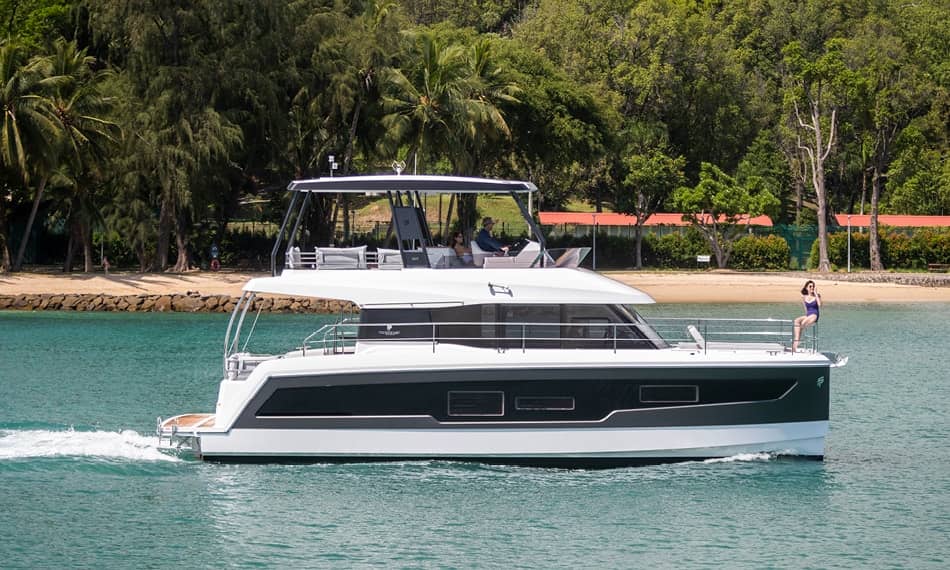
Photo credit: Fountaine Pajot
Monohull vs. Catamaran Maintenance
Depending on size, age, and type of hull construction, maintenance costs will vary, but when comparing two fiberglass sailboats of similar length, the catamaran typically costs more to maintain. That’s because there are two hulls to care for, two engines, connecting structures that align the two hulls, and an overall larger boat due to the catamaran’s greater beam. Hauling and launching a catamaran can be more expensive at many boatyards, as well.
However, smaller catamarans of about 20 feet in length or less are often more comparable and sometimes cheaper to maintain than a similar length monohull. That’s because cats are often lighter and suitable for keeping on a trailer rather than in a slip or on a mooring.
Catamaran vs. Monohull Cost
Compared to similar length monohulls, a catamaran will likely cost more than a monohull boat. That’s mainly because when you purchase a 40-foot catamaran, you are buying two hulls and two engines, but you are also buying a bigger boat that typically has much more volume. In the case of a 40-footer, you end up with a boat that has a large saloon and three or four private cabins, whereas in the monohull, the saloon is smaller and you’ll have three smaller sleeping cabins. Annual maintenance will also be greater, as described above.
Among smaller catamarans and monohulls, pricing will vary, and a lightweight beach cat may be less expensive than a heavier monohull keelboat of similar length.
Catamaran vs. Monohull, Pros and Cons
Depending on a variety of factors, there are plenty of catamaran and monohull pros and cons. These are some to keep in mind when comparing the two boat types.
Catamaran pros
• Comfort . On a cruising designed catamaran, two hulls with a wide beam create a stable and comfortable living environment with open spaces and plenty of standing room.
• Speed . Smaller, lighter catamarans are speed champions, especially in a moderate wind and modest waves. Cruising cats are often fast when sailing at reaching angles.
• Maneuverability . When equipped with two engines, a catamaran is highly maneuverable under power.
Monohull pros
• Upwind sailing . Although catamarans are often faster when sailing in a straight line, monohulls typically perform better against the wind.
• Self-righting . Except for unballasted monohulls that rely on crew weight for stability, the ballasted keel of a monohull prevents capsizing in most circumstances and the keel makes the boat self-righting.
• Maneuvering under sail . Monohulls turn more easily due to their shape, maneuvering in close quarters or tacking when sailing against the wind.
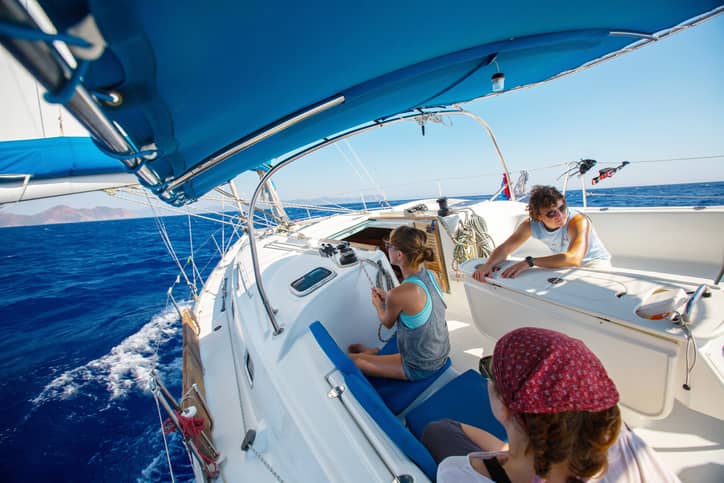
Catamaran cons
• Lack of feel when steering . Except in lighter, more performance-oriented catamarans, the broad platform with two rudders and two hulls sometimes isolates the sailor and provides little feedback through the helm when under sail.
• Sailing against the wind . Upwind sailing is generally not a catamaran’s best point of sail, but its straight-line speed can be such that it may arrive quickly at its destination, even though you will have traveled much farther than in a monohull.
• Pricing . Catamarans are typically more expensive than monohull boats due to their two hulls and other required build components and complexity.
• Not self-righting . Thanks to its wide beam and two-hull design, a catamaran is more difficult to flip, but it is not designed to right itself except for small beach cats where the crew can use their weight to re-right the boat.
Monohull cons
• Weight . Most monohulls have thousands of pounds of weight in the keel for ballast that is vital to its stability but can degrade performance.
• Wave motions . Monohull boats are much more susceptible to rolling wave motions.
• Cabin . With the monohull cruising design, you'll typically find a darker interior with smaller port windows and fewer space options.
• Heeling effect . Monohulls will heel over in a moderate wind, which is normal but often uncomfortable for newer sailors.
Written By: John Burnham
John Burnham is a marine editor and writer with decades of journalism experience as Chief Editor of boats.com, Sailing World, Cruising World, and other boating websites. As a competitive sailor, he has led teams to world and national titles in the International One-Design, Shields, and other classes. Based in Newport, Rhode Island, John is a PCC leadership coach, a member of the America’s Cup Hall of Fame Selection Committee, and a past board member of Sail America and US Sailing. For more, see johnsburnham.com .

More from: John Burnham
Related Articles and Guides

26th Mar 2024
Best Sport Fishing Boats, Convertible and Express to Center Console
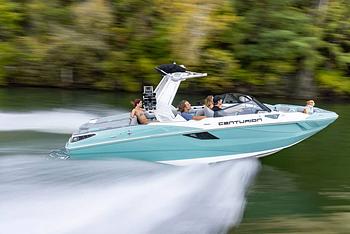
20th Mar 2024
Best Wakesurf Boat Brands, V-Drive, Jet-Drive, Forward-Drive & More
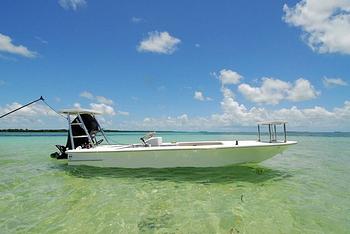
4th Mar 2024
The Best Flats Boats Brands, Special Boats for Skinny Waters
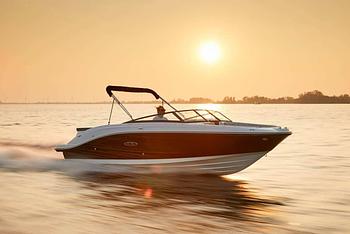
21st Feb 2024
Best Lake Boat Brands for Fishing, Cruising, and Watersports
- Explore Rightboat
- Boats for Sale
- Boating Articles
- Buyers Guide
- About RightBoat
- Sell Your Boat
- Boat Selling Advice
Enter your email to keep up to date with the latest news
Join for free
Sign up now for free and discover how easy it is to keep up to date with THE latest boats for sale. Find your right boat, and tailor your voyage to finding your next boat.
Benefits of becoming a member:
- Set up tailored alerts
- Personalise your experience
- Download full specifications and broker details
- Keep tabs on your favourite boats
Are you a broker? Join as a Broker
Rightboat - join for free.
Do you have an account already? Login
Save this search
Save your search and receive new boats in your email..
You can unsubscribe from your alerts whenever you like. By pressing the button you accept the Legal Terms and conditions

Catamaran vs monohull

COVID 19: You can change your booking on most of our boats if your travel plans are affected by coronavirus. See here for more details
Let us help you plan the perfect sailing trip
Provide your travel details, receive free offer and enjoy your holiday!
A Catamaran sailboat has become a very popular type of boat to charter, offering comfort and a laid-back experience. But if you’re more interested in traditional sailing, you might want to consider a monohull sailboat. Adrenaline seekers will also have more fun sailing a monohull, especially under full sails. Read on to find out more about the difference between catamarans and monohulls.
Catamarans
A catamaran hull is the water tight body of the boat that allows it to float. Catamarans are multi-hulled vessels, which means they combine two or more hulls, also known as pontoons. A catamaran’s two-hull design offers a higher degree of stability and comfort in comparison to a monohull boat, which also helps in reducing seasickness. Catamaran sailboats are propelled by the wind, and can travel a lot faster than traditional sailing boats due to the needle-like monohulls or multihulls. A catamaran charter offers a great balance between sailing performance and comfort.
A Catamaran yacht offers more space both on deck and inside, making it an ideal choice for larger groups. A no sail catamaran, i.e. power catamaran, often offers a grand sundeck and sky lounge with a panoramic view of the sea. It also allows easy access to the water through the stern of the catamaran, which is great for all kinds of watersports. Catamarans offer a good level of stability thanks to the two hull design.
You don’t have to be a professional sailor to maneuver a catamaran. Its twin propellers and light weight make it very easy to handle. A catamaran sailboat usually has a smaller draft and is able to sail in shallow bays or closer to the beach. Another advantage of catamarans is that they have two separate engines which allow you to easily turn the boat around, and can come in handy in the unlikely event one of the engines fails. Catamaran sailing is as dangerous as sailing any type of sailboat if not handled properly, but if you’re a skillful sailor or have a knowledgeable skipper onboard, sailing a catamaran is a walk in the park.
Some monohull sailors claim that sailing a catamaran isn’t an authentic sailing experience. Unlike a monohull boat, catamarans won’t heel, which might be seen as a disadvantage if you’re a thrill seeker. Catamarans can be difficult to anchor, and take twice as much docking space as a monohull. Although catamarans are fast when sailing downwind, monohulls can be faster sailing upwind. Catamarans are usually more expensive to buy or rent and to moor and dock than monohull sailboats, but they do offer a lot for their price.
Monohull sailboats
Monohull sailboats are the most widespread type of boats out there. An important characteristic is their stability. A monohull sailing boat is almost impossible to capsize, making it extremely safe at sea. This stability is provided by the keel and ballast.
Sailboats are mostly equipped with one mast and two sails, but depending on the size of the sailboat can have more. The front sail can be rolled up and is called the genoa, jib, (genny jib) or rolfok. The rear sail is the main sail and can either be a conventional sail that is hoisted up the mast or a roll main sail that is rolled into the mast.
A big pro many monohulls have compared to catamarans is that when in motion they don’t pound or slap against the water. Catamarans with low bridge deck clearance from the water tend to hit and slap on the undercarriage in lumpy seas when sailing upwind. This can sometimes feel as though the boat is getting a beating.
When not using the sail, monohull sailing yachts are propelled by just one engine which can combine with a bow thruster on the front. The bow thruster is a small electric engine on the bow of the yacht that moves the bow sideways with the press of a button, making it easier to maneuver in tight spaces.
Sailing boats range in size from the smallest with only one cabin, such as the Seascape (a sailboat commonly used for sailing courses), to medium sized sailboats with two cabins, to the largest with six cabins. The saloon is used as a dining area and common room and can also double up for sleeping. If the saloon is used for sleeping, the table folds away and combines with the bench to create a large double bed.
Catamaran vs monohull charter options
A catamaran charter can be expensive. Prices vary depending on when and where you are chartering the catamaran, and also the age and model of the boat. There are two catamaran rental options:
- A sail catamaran, propelled by sails
- A power catamaran, powered by an engine.
A power catamaran can reach higher speeds, and often offers more space than a sail catamaran. The no-sail design offers more space and a better panoramic view of the sea, with no sails to block the view.
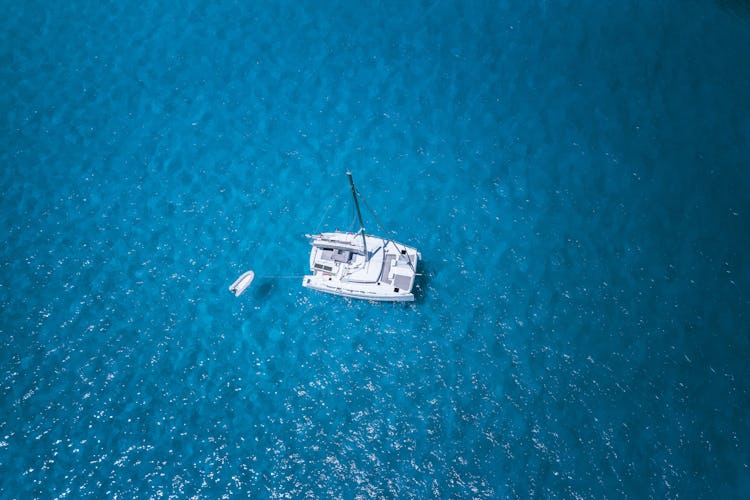
Skippered vs bareboat
A bareboat charter is a sailing boat rental that you sail by yourself, without a skipper or any crew members. You are in charge of everything, from navigation, sailing and mooring to cooking and cleaning. At least one member of your group must be an experienced sailor with a valid licence. Bareboat sailing is also the cheapest option. Bareboat charters offer the freedom to explore the sea wherever and whenever your heart desires. It’s a great way to have a truly unique holiday.
If comfort and relaxation are top priorities on your vacation, you might want to consider a skippered charter. You won’t need a license and your skipper will steer the boat, decide on the best route and keep you safe! Skippers are carefully chosen individuals that aren’t only known for their sailing skills and experience, but also for being very knowledgeable about the area and destinations you’ll be visiting. They often act as your personal local guide. On top of all that your skipper will share tips on how to become the best possible sailor. Skippered sailing charter is the best option for less experienced sailors.
Catamaran vs monohull: interiors and layouts
Catamarans have an eye-catching exterior due to their two-hull design, but are also very impressive on the inside. On the exterior they have a flybridge with a helm station, offering 360-degree views of the sea, a spacious main seating area, and an easily accessible sunbathing platform. Layouts are often open, with a well-equipped L-shaped galley connected to a dining area consisting of comfortable seating and a table. Behind the seating, there are usually glass doors that open to an aft cockpit where you can watch sunsets and sunrises. Below deck, you’ll find cabins with double beds and bathrooms. All in all, a catamaran’s biggest advantages are its open layout and awesome panoramic views you can enjoy from every part of the boat.
Here are your catamaran options:
- 3 cabin catamaran - ideal for three individuals or three couples. This cat comes with a kitchen, sitting area and a few restrooms.
- 4 cabin catamaran - this cat includes a sitting area, multifunctional kitchen, four bedrooms and a few restrooms.
- 5 cabin catamaran - this cat comes with four larger bedrooms and one smaller one. It has a bigger kitchen and a large sitting area with a nice deck where you can enjoy dinner under the stars.
- 6 cabin catamaran - this cat offers large bedrooms and a big deck.
- 7 cabin catamaran - king’s catamaran offering maximum comfort for you and your crew. Comes with a fully equipped kitchen and a large beautiful deck.
- 8 cabin catamaran - traveling in a large group, or part of a big family? We’ve got you covered with the largest catamaran in our fleet, this cat is the definition of comfort and is called a ‘house on water’ for a reason!
Monohull interior options:
- 1 cabin sailboat - ideal for couples and adrenalin lovers. This sailboat wasn’t built for long travels. It comes with one restroom and a small kitchen.
- 2 cabin sailboat - great for couples with children. Comes with a comfortable lounge area.
- 3 cabin sailboat - if you have two or more children, this is the perfect choice for you! Comes with two restrooms, a kitchen and a lounge area.
- 4 cabin sailboat - if you’re spending your holiday with friends and family, this is the right choice for you. It comes with a big sitting area, two restrooms and a big kitchen.
- 5 cabin sailboat - big kitchen, grand sitting area and three restrooms make this sailboat ideal for larger groups.
- 6 cabin sailboat - king of our sailboat fleet. If you’re looking for uncompromising comfort this is the sailboat for you!
Best catamaran and monohull destinations
Whether you’re a seasoned sailing purist who will never abandon your loyalty to monohulls, or a catamaran fan prioritising space and stability, all sailors can agree on one thing – there’s no such thing as a bad day on the water. Every experience is different from the last, and the opportunity for new adventures is infinite. There’s certainly no shortage of phenomenal places to sail to, but here are a few of our favourites:
- Mediterranean - the picturesque and idyllic landscape of the Mediterranean, with plenty of ports and favorable winds, attracts sailors all year round. Famous destinations are the Balearic Islands, the Amalfi coast and the Ionian Islands.
- British Virgin Islands - known as the mecca for sailing, with its numerous islands that are rich in culture. Its weather conditions make it ideal for sailing all year around.
- Caribbean - warm winds, crystal clear water and the reflection of the moon on the midnight waves make the Caribbean a unique destination for sailing enthusiasts.
In conclusion
The choice of a monohull vs catamaran comes down to a personal preference and budget. If you’re traveling with a large party or you want an easy laid-back experience, catamarans are the way to go. If you’re looking for an adrenaline-rushed adventure, a monohull might suit you better.

Catamaran VS Monohull Sailing – Which Is Best For You?

When it comes to choosing the right boat for your sailing adventures, the debate between catamarans and monohulls is a hot topic. Many novice and experienced sailors face the challenge of deciding which type of boat best suits their needs, preferences, and sailing goals.
Each of these vessels has its unique characteristics, and your choice will ultimately depend on factors such as the intended use, the areas you plan to sail, budget constraints, and your personal preferences.
In this article, you’ll find all you need to know about catamaran vs monohull sailing. So, let’s dive into it right now and see the key differences between these two popular types of watercraft.
Post updated: 25.10.23
Table of Contents
Key Takeaways
- Understand the differences in design and performance between catamarans and monohulls.
- Consider factors like comfort, safety, and cost when choosing a boat.
- Gain insights into the pros and cons of each type of vessel to make an informed decision.
Design and Structure
Hull comparison.
When choosing between a catamaran and a monohull, one of the main differences lies in their hull structures. A catamaran consists of two parallel hulls connected by a beam, offering more stability and a shallower draft.
A monohull has a single hull and relies on a deep keel for stability. Monohulls often give the feeling of sailing closer to the water and provide the traditional sailing experience many enthusiasts enjoy.
Deck and Cabin
In terms of living quarters, catamarans offer larger, more open deck spaces and cabins than monohulls. This allows for a more comfortable living experience, with roomy kitchens and dining areas.
On a monohull , the living space can feel more confined, but some sailors appreciate the cozy atmosphere and the challenge of maximizing every inch of space.
Beam and Ballast
The beam refers to the width of the boat, and in the case of a catamaran , it is typically wider than a comparable monohull, as it stretches across both hulls. The increased beam improves stability, making catamarans less likely to rock or roll in waves when navigating in good conditions.
Monohulls, on the other hand, have a narrower beam and use ballast (typically in the form of a heavy keel) to assist in maintaining balance. This allows monohulls to lean or “heel” more while underway, providing a unique sailing experience for those on board.
Helm and Rudders
Both catamarans and monohulls have helms and rudders to control the boat’s direction and maneuverability. The key difference lies in the positioning and number of these components.
On a catamaran , there are typically two rudders, one behind each hull, providing more responsive steering and faster turning.
Monohulls have a single rudder, which might make steering more challenging in strong winds or high seas.
Performance
Speed and efficiency.
When comparing catamarans and monohulls, one of the first things that comes to mind is their speed and efficiency.
Catamarans are generally faster than monohulls of the same length and displacement.
This is primarily due to their lighter weight and slim hulls, which offer less water resistance and drag.
In fact, a catamaran can often sail at half the speed of wind, which is about 30% faster than a monohull. However, this also depends on factors like sail configuration, wind conditions, and sea state.
Handling and Maneuverability
Handling characteristics differ significantly between catamarans and monohulls. Generally, monohulls are more responsive to trim adjustments and wind pressure, providing a more engaging sailing experience for the sailor.
On the other hand, catamarans are less maneuverable under sail since they lack the deep keel of a monohull, which is essential to track and coast.
Nonetheless, catamarans excel in maneuvering when under power, thanks to their twin-engine configuration. They can pivot the boat into position more easily, making docking a breeze.
Monohulls rely on prop walk and reverse to position themselves, which can be challenging for some sailors.
Upwind Sailing
Sailing upwind is an essential aspect of any sailing adventure. Here, monohulls have the edge, as they can sail closer to the wind. This means that when you’re racing or trying to reach an upwind destination, a monohull might get you there faster.
Catamarans, on the other hand, struggle to tack upwind as efficiently due to their wider hull separation and lower resistance.
Water Resistance and Drag
Water resistance and drag play a crucial role in a sailboat’s performance. Catamarans have slender hulls with minimal wetted surface area, which reduces drag and allows them to cut through the water more efficiently.
This design contributes to their speed advantage over monohulls . On the contrary, monohulls have a larger wetted surface and a deeper draft, which increases water resistance and slows them down in comparison.
Both catamarans and monohulls have their unique strengths and weaknesses in terms of performance. While catamarans are generally faster and offer better maneuverability under power, monohulls excel in upwind sailing and provide a more engaging sailing experience.
Comfort and Space
Spaciousness and comfort.
Regarding comfort and space, catamarans have a clear advantage over monohulls. Thanks to their wide beam, catamarans offer more spacious accommodations, especially in the main saloon and cockpit areas.
The twin-hulled design provides greater stability, resulting in a smoother sailing experience with less heeling and rocking.
This makes catamarans ideal for those who prioritize comfort and want plenty of room to move around during their sailing adventures.
Kitchen and Dining Experience
A key difference in the kitchen and dining experience between catamarans and monohulls lies in the amount of space and layout.
Catamarans typically feature roomier galleys with ample counter space for meal preparation, making it easier for everyone to lend a hand in the kitchen.
The dining area in catamarans is often designed as an extension of the cockpit, allowing for seamless indoor-outdoor socializing and easy access to both the galley and the deck.
In contrast, monohull sailboats have smaller galleys, often in a U-shape or along one side of the hull. The dining area might be more confined, usually within the main salon. While it may be cozy, it lacks the open and airy feel of a catamaran’s dining space.
Privacy and Living Quarters
Another aspect to consider is the privacy and living quarters in both types of sailboats.
Catamarans usually have separate hulls for the living accommodations, which can provide greater privacy and personal space for guests or crew members as the cabins tend to be physically separated from the common areas.
Additionally, because the cabins are situated in the hulls, they are less affected by noise or disturbance from the main salon and cockpit.
Monohull sailboats, on the other hand, usually have more compact living quarters located within the same hull. Privacy may be slightly compromised due to the closeness of the cabins to the common areas.
That said, monohulls can still provide adequate living space and privacy, depending on the layout and size of the sailboat.
Safety and Stability
When comparing catamarans and monohulls, safety and stability are important factors to consider. In this section, I’ll explain the differences between the two boat types regarding capsize and buoyancy, seasickness, motion, dealing with waves and bad weather, and docking and anchoring.
Capsize and Buoyancy
Catamarans are known for their stability due to their two-hull design, which increases their resistance to capsizing.
Conversely, Monohulls can roll over more easily but can right themselves due to their heavy, lead-loaded keels. However, catamarans have natural buoyancy and can remain afloat even if they are holed, while a monohull may sink if it takes on too much water.
Seasickness and Motion
Seasickness can be a major concern for boaters, and the motion of a catamaran is generally more stable and comfortable than that of a monohull.
Catamarans are less susceptible to roll, which can reduce the chances of seasickness for those onboard.
Monohulls , however, tend to pitch more in rough seas, which can lead to a more uncomfortable ride for passengers.
Dealing with Waves and Bad Weather
While catamarans are known for their speed advantage over monohulls, heavier cruising catamarans may not be as fast if they have smaller rig sizes for ease of handling.
In bad weather, a catamaran’s speed can help outrun storms, while monohulls rely more on their stability in rough waters.
Waves in an anchorage that induce violent roll in a monohull may, however, only cause a catamaran to bounce or bob.
Docking and Anchor
When it comes to docking and anchoring, there are differences between catamarans and monohulls.
Catamarans don’t coast well primarily because they don’t have a deep keel to track. They require a different approach to docking, utilizing engines to pivot the boat into position instead of relying on coasting and prop walk.
Monohulls typically need more depth when anchoring due to their keels, while catamarans benefit from their shallow drafts, allowing them to access shallower areas and anchor closer to shore.
Cost and Maintenance
When considering catamarans and monohulls, it’s important to take into account the cost and maintenance of each type of vessel. So, let’s explore the differences in maintenance and equipment, fuel consumption, and demand and resale value between the two.
Maintenance and Equipment
Generally, catamarans are more expensive to buy and maintain than monohulls. This is mostly due to their double-hull design, which requires extra maintenance and equipment costs.
On average, catamarans are 19-66% more expensive when new and have about 60% higher annual fees.
Although monohulls ‘ maintenance and repair costs are often lower, both boat types require regular upkeep to stay in good shape.
Some key maintenance differences between catamarans and monohulls include:
- Hull and rigging maintenance: Catamarans have two hulls, which can lead to double the maintenance costs for bottom painting and cleaning. However, their typically lighter and simpler rigging system can result in lower maintenance costs than monohulls.
- Engine maintenance: Catamarans usually have two engines, one in each hull, increasing overall maintenance costs. Monohulls generally have one engine, which can result in lower maintenance costs over time.
Fuel Consumption
When it comes to fuel consumption, catamarans tend to be more fuel-efficient than monohulls, especially at slower speeds. This is due to their hydrodynamic design, lightweight materials, and relatively less water resistance.
Although monohulls may consume more fuel, they often have a smaller fuel tank, which can result in lower overall fuel costs.
Demand and Resale Value
When purchasing a vessel, it’s important to consider the demand and resale value of both catamarans and monohulls.
Catamarans hold their value better due to their growing popularity and scarcity in the used boat market. This means that if you decide to sell your catamaran, you are likely to get a higher percentage of your investment back.
Monohulls, on the other hand, are more common on the used boat market, resulting in lower resale values. However, they typically have a lower initial purchase price, which may be more attractive for those on a budget.
Pros and Cons of Catamarans and Monohulls
Now, let’s explore the advantages and disadvantages of both catamarans and monohulls to help you decide when choosing the right boat for your needs. Let’s dive right into it!
Advantages of Catamarans
One of the main advantages of catamarans is their comfort . They’re more stable and less prone to heeling, making it less likely for passengers to get seasick.
Catamarans are also more spacious due to their dual-hull design, providing ample living space above the waterline with bright and airy saloons. This makes them perfect for sailing with family or friends.
When it comes to speed , catamarans generally perform better than monohulls. They usually sail faster and are more maneuverable in tight spaces due to their shallower draft, allowing for safer anchorages closer to shore.
Most catamarans in the 40-ft to 50-ft range draw between 3 ft to 4.5 ft, so they can access places that monohulls can’t even consider.
Disadvantages of Catamarans
Unfortunately, catamarans do have some downsides. One of the main disadvantages is their larger windage .
The increased surface area can make them more difficult to handle in strong winds.
Additionally, their maintenance can often be more specialized and expensive due to the unique design features.
Advantages of Monohulls
Monohull boats have their own set of advantages. They provide a more classic aesthetic that many sailors find appealing.
When it comes to sailing performance, monohull boats heel naturally, which can give more direct feedback to the sailor and make for a more exhilarating experience.
In terms of speed, modern monohulls can sometimes exceed catamarans, particularly downwind and in choppy seas. Some can reach speeds of 10 knots or more.
Disadvantages of Monohulls
On the flip side, monohull boats often have less living space, and most spaces are below the waterline, making them feel more cramped and darker compared to catamarans. The heeling experience is a double-edged sword, as some passengers might enjoy it while others may feel more prone to seasickness.
Frequently Asked Questions
Q: which is safer in rough seas: a catamaran or a monohull.
When it comes to rough seas, both catamarans and monohulls have their safety advantages. Catamarans are known for their stability on the sea, and their speed can make it possible to outrun bad weather.
However, monohulls are considered to be stronger and may provide more space for emergency equipment and supplies. Safety ultimately depends on your skills as a sailor, the boat’s design, and the specific conditions you encounter.
Q: Can both catamarans and monohulls be used for offshore fishing?
Yes, both catamarans and monohulls can be used for offshore fishing. Catamarans are famous for their stability and ample deck space, which can provide a more comfortable fishing experience.
Monohulls, on the other hand, often have a deeper draft, allowing them to access deeper waters and a wider range of fishing spots. Ultimately, the choice comes down to your personal preferences and the type of fishing you plan to do.
Q: How do catamaran and monohull liveaboards differ?
There are notable differences between catamaran and monohull liveaboards. Catamarans typically provide more living and storage space, as well as more privacy due to their dual-hull design.
They’re also known to have better stability, which can make for a more comfortable living experience onboard.
Monohulls , however, can be more affordable and easier to maintain, and offer better sailing performance in certain conditions.
Q: Which type of boat is more suitable for Yacht Week: a catamaran or a monohull?
Both catamarans and monohulls can make for a fantastic Yacht Week experience, and the choice ultimately depends on your preferences and the specific event you’re attending.
Catamarans are ideal for those who prioritize stability, speed, and a more spacious layout for socializing.
Monohulls may be better suited for those who enjoy a more traditional sailing experience or are looking for a more budget-friendly option. Always consider the preferences of your crew and the requirements of the event when making your decision.
Final Words!
In summary, both designs offer their own unique advantages and drawbacks.
However, you should consider factors like your sailing goals, preferences in boat handling, and the type of waters you’ll be frequenting when deciding between a catamaran or monohull.
Both options have their merits, and your decision will ultimately be shaped by what best suits your unique needs and desires. Happy sailing!
Want More Tips?
Subscribe to Cruising Sea newsletter to receive every two-week the latest post straight to your inbox
Which yacht do you prefer, a catamaran or a monohull? Feel free to share your opinion in the comments below.

Daniella has been passionate about travel, the sea, and nature for many years. As a child, she frequently traveled throughout the Mediterranean and continued with her journeys throughout her adult life.
Her experiences have created the desire within her to share her love for traveling with other passionate and adventurers who want to discover beautiful horizons and new cultures.
10 thoughts on “Catamaran VS Monohull Sailing – Which Is Best For You?”
This is a very interesting article, but I think it’s very clear which side you come down on! I would tend to agree and you have laid the key points out nicely to create a strong argument for the cat. I have been on both, but I’m definitely not a sailor, but the thing I remembered the most was the smoother ride that you get with the cat. So I agree with you!
Yes, you get a smoother ride with a Cat than with a Mono due to the two hulls and not to forget that the Cat is lighter than a Mono:)
Thank you for the comment
I wish you a great day!
Hello Daniella, I am mostly a ballast when sailing but thank you for this nice article. I’ve been curious what are the differences of catamarans vs monohulls and thanks to You now i have a little better understanding. And since i was sailing on monohull now it’s time to check out catas 😉 Maybe You could you provide some more information about renting prices of catas vs mono ? I couldn’t find it here and I think it could also play a big factor when chartering a yacht. Cheers!
You are right, I didn’t mention this important detail. Sorry about it! Here is the answer. A Catamarans is generally more expensive than a monohull of the same size and the reason is because the cat is a larger boat. But you’ll get the payback in the comfort and space.
I hope it helped!
Thank you for the comment and wish you a nice day
For myself I have always owned a mono haul sailboat for the fun of sailing around. To actually do a trip on one with others, I would choose the more spacious catamaran for down south in the warmer waters.
Not knowing much about the catamaran, it was nice to read a side by side description to have a better understanding between the two.
I am glad you found this article helpful and I hope it will help you to make the right choice. If you have never tried a catamaran, then I highly suggest you to try it, I am sure you will love it!
Thank you for the comment and wish you to sail soon!
Have an awesome day
I’ll go for Monohull in this case. I’ll rather sail alone or take a person with me on board. Not keen on having a group.
As I mention before, design is one thing I emphasise on but there are lots of people on board, I think I’ll stick by having more space than more passengers.
Thanks for sharing by the way, Daniella! They’re very analytical and informative, just like the previous debate I red. Good stuff!
As long as you feel good with your choice, then no matter what you’ll choose, it will be the good decision!
I personally love catamarans:) I feel much more comfortable and safe on these boats and the seasickness is reduced to 80%, so I won’t give up on Cats!
A Catamaran sounds awesome to me! I love that there is more living space and that they can be faster in the right winds. I’ve always thought they were so cool whenever I’ve seen one. So much space to relax and enjoy the ocean. I personally do more dinghy sailing and like for sailing to be more of a workout – hiking upwind and such. What big boats sail most like a dinghy?
Yes, I totally agree with you, Catamarans are great boats for cruising. As you said, cats have everything in order to sail comfortably and in luxury as well. As far as I know, a dinghy will always be a boat and you can try to workout as you do it on a dinghy on a bigger boat like a catamaran or a monohull. If you want to navigate the boat by yourself, then you’ll need to check if you are required to have a license for bigger vessels. You might need to do a sailing course.
However, I hope it helped and if you need more information, please don’t hesitate to contact me at any time, I’ll be glad to assist:)
Leave a Comment Cancel reply
By using this form you agree with the storage and handling of your data by this website. *

IMAGES
VIDEO
COMMENTS
One of the advantages of catamarans over monohulls is their wider beam, which provides more deck space. This means more room to move around and increased stability, which is important in rough seas. Additionally, catamarans usually have two hulls, which means more cabin space and privacy for the crew and passengers.
In a similar manner, we can observe that catamarans have better roll stability when compared to monohulls. This gives them an upper hand in terms of comfort and executing different operations onboard the vessel with ease, also reducing the risk of people falling on board the vessel. Catamarans are mostly used as ferries or passenger vessels as ...
Rough seas are defined as waves that rise to heights between 2 to 6 feet (0.6 -1.8 meters). The hulls turn a catamaran into a floating platform that's pretty sturdy. In addition, their wide stance and solid construction make the vessel extremely stable, allowing it to withstand the water's constant pounding motion.
When it comes to determining which is better in rough seas, whether a catamaran vs. a monohull, it depends on various factors and personal preferences. Both types of vessels have their own strengths and considerations in rough conditions and it took us a lot of research to work out that really there isn't a 'better vessel', just different ...
Navigating choppy waters: Monohull vs. catamaran. In rough seas, the design of a catamaran shines through. Its twin hulls provide excellent stability, reducing the rocking motion common on monohulls. If comfort during challenging weather is a priority, catamarans have a clear advantage. Sailboat catamaran: Best of both worlds
Catamarans and monohulls are boats that are pretty different from each other. Although the term catamaran applies to any vessel with multiple hulls, most catamarans are from two hulls connected by decks and outriggers to prevent capsizing in rough seas, while monohulls only have one hull. Catamarans are typically faster and more efficient than ...
Catamarans don't coast well primarily because they don't have a deep keel to track. Relying on coasting to a dock at a shallow angle and then going into reverse and using prop walk to cozy up the stern won't work. It is better to come in at a sharper angle and then pivot the boat into position with the engines.
In the catamaran vs monohull speed debate, it might be more of a draw. Catamarans are typically 25-30% faster than a comparable monohull, but some argue that it comes at a price. ... When considering sailing conditions, a catamaran vs monohull in rough seas will perform very differently. During rough sailing, you must be more vigilant when on a ...
7. Shallow Draft Equals Better Anchorages. Catamarans have significantly shallower drafts than monohulls, allowing for safer anchorages closer to shore. Most catamarans in the 40-ft to 50-ft range draw between 3-ft to 4.5-ft, so they can anchor in places that a monohulls can not even consider.
Upwind sailing performance: While catamarans have the edge at straight-line speed, monohulls sail closer to the wind. When you're racing or you have to sail upwind to get to the next island, this can get you there faster. Sailing feel and responsiveness: The "feel" of sailing a monohull is much better.
Most cat enthusiasts believe a minimum of 40 feet (12m) is optimal for a cat to survive in rough seas. As a general rule of thumb, the best length-width proportion is 45 to 22 feet (13.72 to 6.71 meters). In addition to safety, a bigger boat will allow for more weight because it has more space, and you can arrange your gear in a more organized way.
Short Answer. Yes, catamarans can typically handle rough seas better than monohulls due to their wide, stable platform. They also have a shallow draft, which helps them to more easily maneuver through choppy waters. The multiple hulls also give them greater buoyancy, meaning they can rise up with the waves easier.
Catamarans, as opposed to monohulls, perform better in head seas because of their twin-hull configuration. The key is hidden in the tunnel. Between the tunnel and the water, the air is trapped, producing a cushion of air for the boat to ride on, giving you the finest ride possible. Factors that Make Catamarans Easier to Navigate on Rough Waters ...
Recreation In a Monohull vs. a Catamaran. Most sailors agree that sailing a monohull boat is much more exhilarating than sailing a catamaran. Traditional sailboats heel, and sailors get instant feedback while they're sailing. ... This means that even in rough seas, you're unlikely to find yourself permanently capsized. ...
Obviously, a monohull has less space than a catamaran. This is due to the fact that a cat is broader and has a larger deck surface. It also has twice as many hulls as the other, giving you greater total space between them. People who want to host parties on their boats will appreciate the extra space.
In short, the speed of a catamaran will allow you to outrun rough weather. A modern catamaran can clock nearly 250 miles a day, which is quite faster, and so there's no reason why you should get caught in bad weather. Monohull. In terms of safety, a monohull is nowhere near a catamaran as far as safety is concerned.
Catamaran VS Monohull in Rough Seas. 1. Deploying Sea Anchor. In order to keep chafe to a minimum, the most important aspect in deploying a sea anchor is the ability to control the angle, otherwise, the vessel will have the wind and prevailing seas without putting too much strain on fittings. The wide beam of a catamaran when in rough seas will ...
Part 2 right here: https://youtu.be/05E-Qv6BVfgA debate as old as time itself! Which is better, a catamaran or a monohull? I'll give away the answer here: l...
The Advantages of Catamarans in Rough Seas. There is an incredible number of myths about catamarans, especially among monohull owners. These boats are one of the superior options for tackling rough seas, especially with anglers. A few essential advantages to note are: High-Speed Sailing
Monohulls have a single hull, and catamarans have two hulls side-by-side. Catamarans are faster than monohulls of the same length and displacement, but monohulls are stronger and more spacious. Monohulls are also cheaper and easier to build than multi-hulls. In this article, we'll cover the differences between catamarans and monohulls, along ...
Catamaran vs. monohull power. A monohull under auxiliary power may be faster than a catamaran in certain conditions, like powering against a strong wind. In other wind and wave conditions, the catamaran is often faster. Also, with an engines on each hull, the cat is often much more maneuverable in close quarters or at the marina.
Catamaran vs monohull: interiors and layouts. Catamarans have an eye-catching exterior due to their two-hull design, but are also very impressive on the inside. On the exterior they have a flybridge with a helm station, offering 360-degree views of the sea, a spacious main seating area, and an easily accessible sunbathing platform.
On a monohull, the living space can feel more confined, but some sailors appreciate the cozy atmosphere and the challenge of maximizing every inch of space.. Beam and Ballast. The beam refers to the width of the boat, and in the case of a catamaran, it is typically wider than a comparable monohull, as it stretches across both hulls.The increased beam improves stability, making catamarans less ...